Lisbon is the largest city in Portugal and a popular starting and/or ending point for many visitors to this country. The list of things to do in Lisbon is very long, with historic landmarks to visit, colorful neighborhoods to explore, and quite a few places to indulge on Portuguese delicacies.
We have visited Lisbon multiple times, first on a longer trip to Portugal, spending nine days in Lisbon, followed up by a quicker visit about one year later. This list of things to do in Lisbon is result of our experiences from both visits.
As you will see, there is a lot to see and do in Lisbon. Strolling through the Alfama neighborhood, visiting the miradouros for views of the city, photographing Praça do Comércio, seeing Tram 28 and the funiculars, and dining in its long list of great restaurants are all must-have experiences, but there are a few hidden gems as well.
40 things to do may sound like a lot, but there were plenty more places we could have added. At the end of this guide, we list what we think are the 10 best experiences to have in Lisbon, plus things to do in Lisbon with kids and a list of the top free things to do in the city.
Let’s get started.
Best Things to Do in Lisbon
In no particular order, here is our list of the best things to do in Lisbon. At the end of this list, you can see all of them on a map, plus our 10 Best List.
1. Praça do Comércio
Let’s get started with one of Lisbon’s most iconic sights, Praça do Comércio (Commerce Plaza), also called Terreiro do Paço.
Sandwiched between the Tagus River and Rua da Augusta, this is one of the largest squares in Portugal.
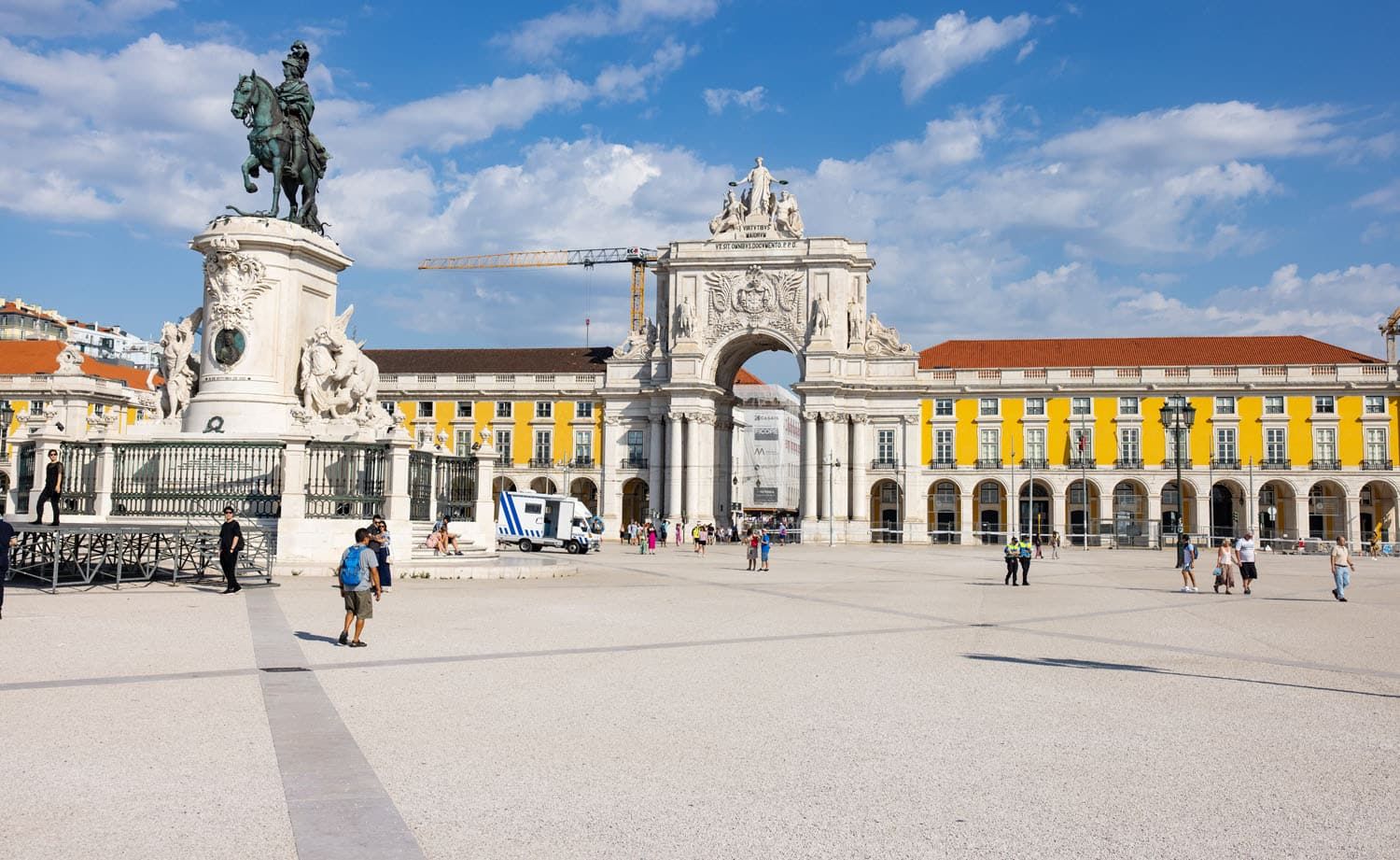
Praça do Comércio
In 1755, the earthquake damaged many of the buildings that sat on this square, including Ribeira Palace. The square was rebuilt with government buildings that regulate port activities and customs, giving this square its name.
The centerpiece of the square is the Statue of King Jose I, which was inaugurated in 1775. Step inside Martinho da Arcada, the oldest café in the city. And don’t miss climbing to the top of the triumphal arch for a bird’s eye view over Praça do Comércio and Lisbon (mentioned next).
2. Arco da Rua Augusta
This arch was built to commemorate Lisbon’s reconstruction after the 1755 earthquake. It sits on Praça do Comércio and from here visitors can stroll along Rua Augusta, one of Lisbon’s famous pedestrian streets.
For a small fee, you can go to the top of the arch for 360° views of Lisbon. An elevator takes you most of the way and at the very top, you’ll walk up a 28-step narrow staircase followed by a 46-step narrow spiral staircase.
Here’s the view.
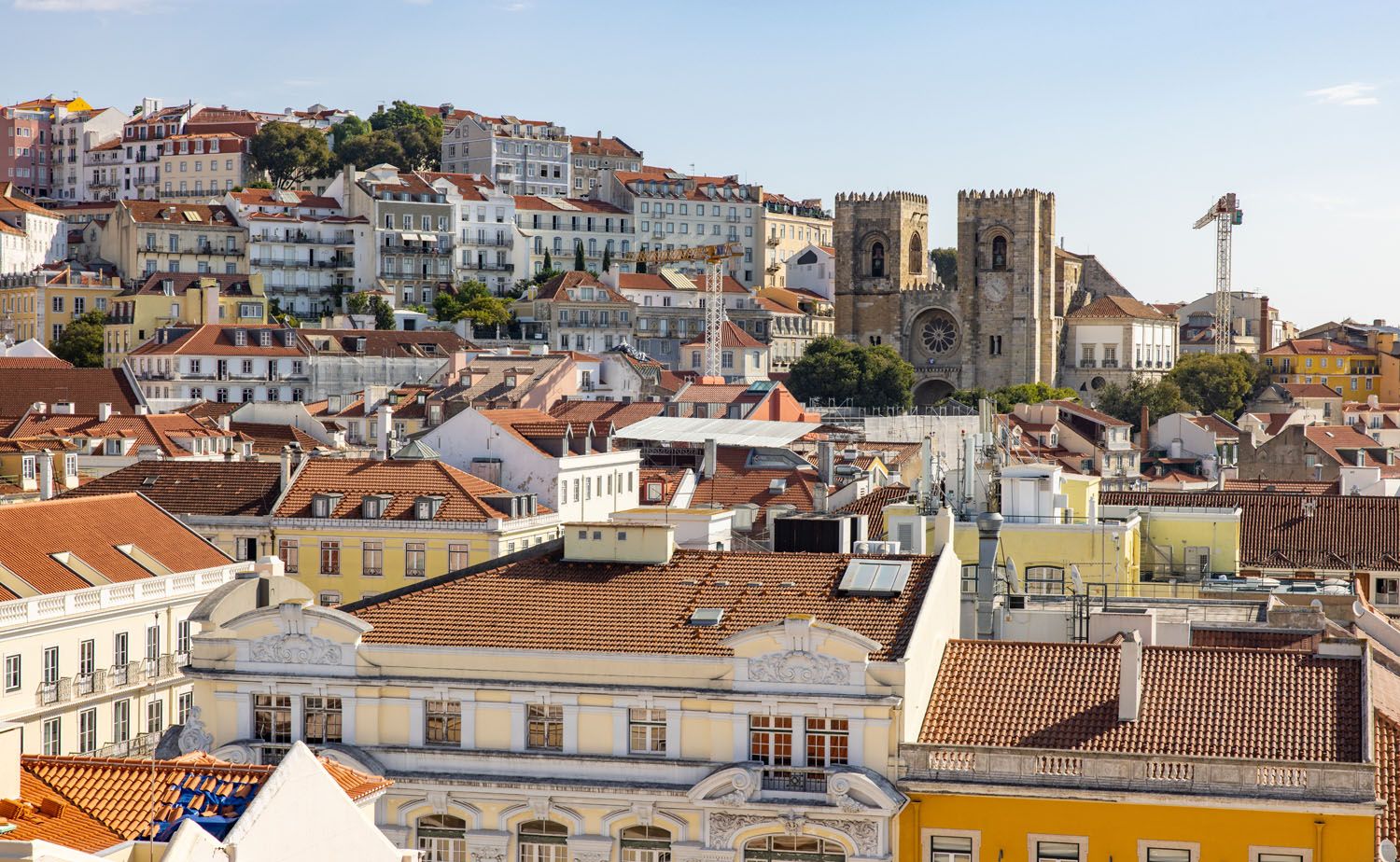
The view from Arco da Rua Augusta
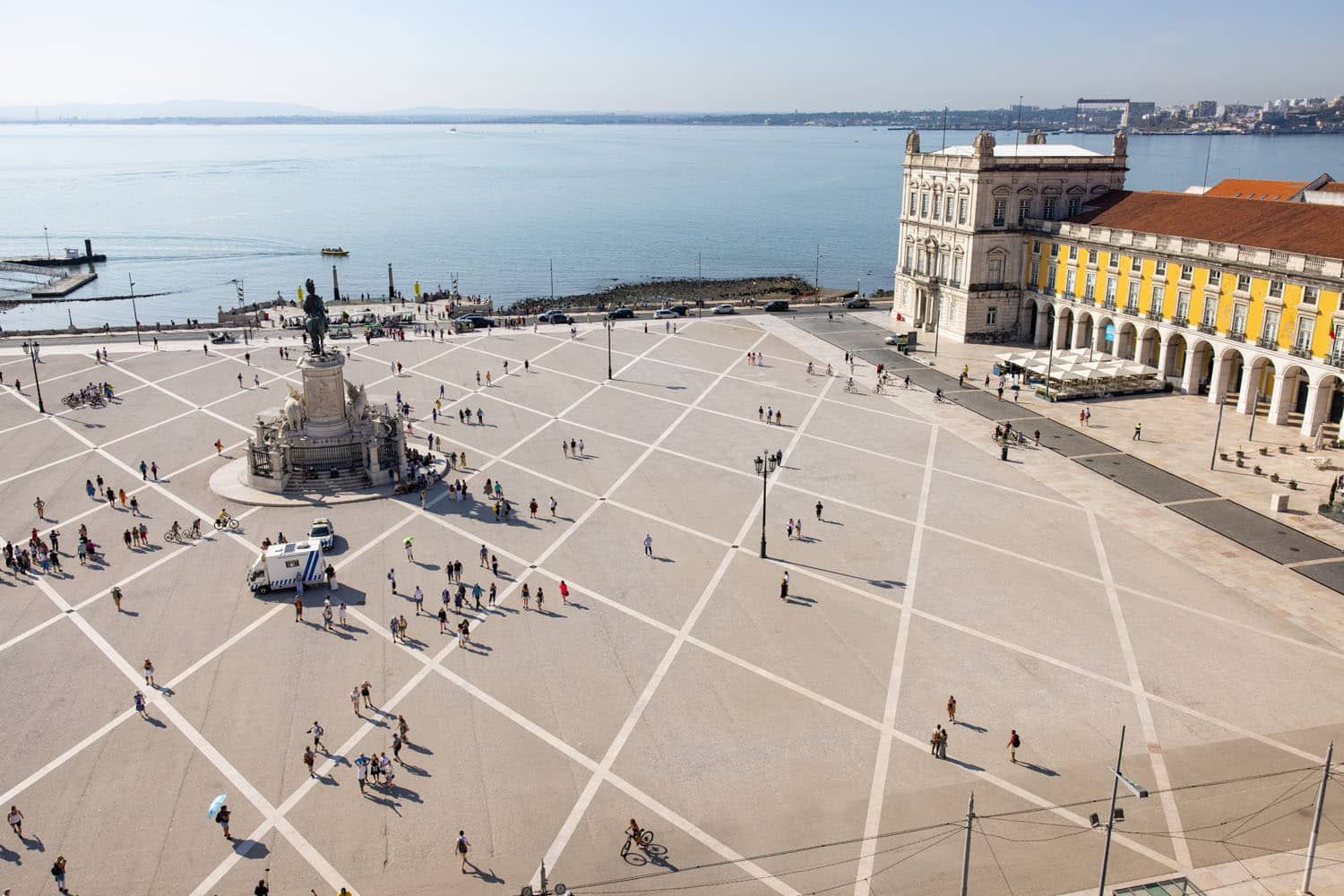
The view over Praça do Comércio from the arch
3. Rua Augusta
This pedestrian street is a very busy place to visit in Lisbon. Photographing Arco da Rua Augusta with the statue of King Jose I attracts a lot of visitors, as do the shops and cafes that line this street.
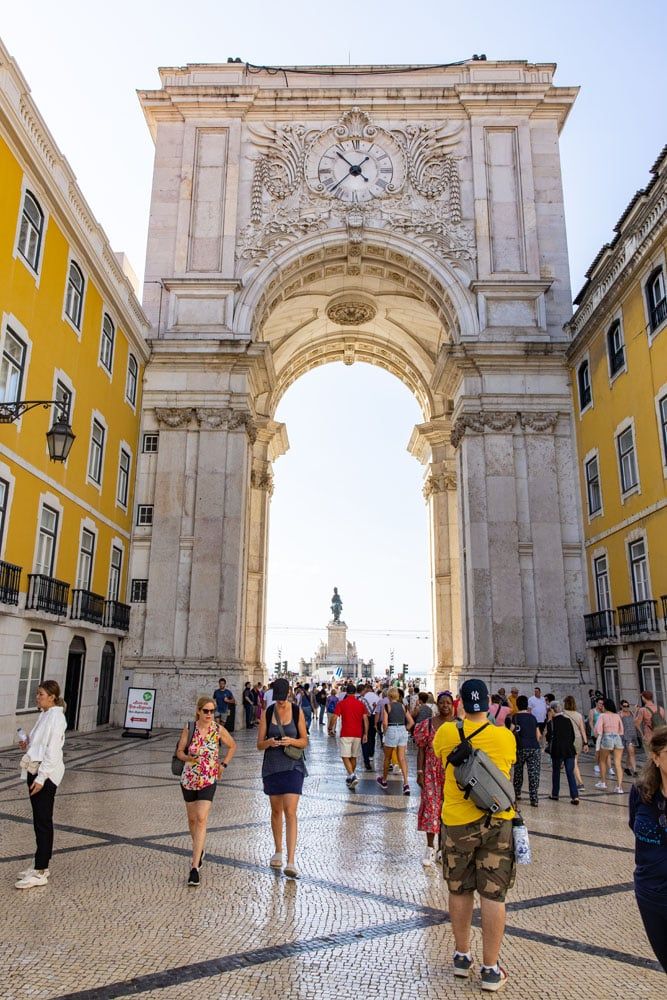
Rua da Augusta and the arch
4. Tram 28
Tram 28 is Lisbon’s most famous tram. It runs through the Alfama, Baixa, Estrela, and Gracia districts, taking riders past several of Lisbon’s top tourism sites. A few of the main sites that the tram passes include Praça do Comércio, the Lisbon Cathedral, Rua Augusta, Miradouro das Portas do Sol, and Basilica da Estrela.
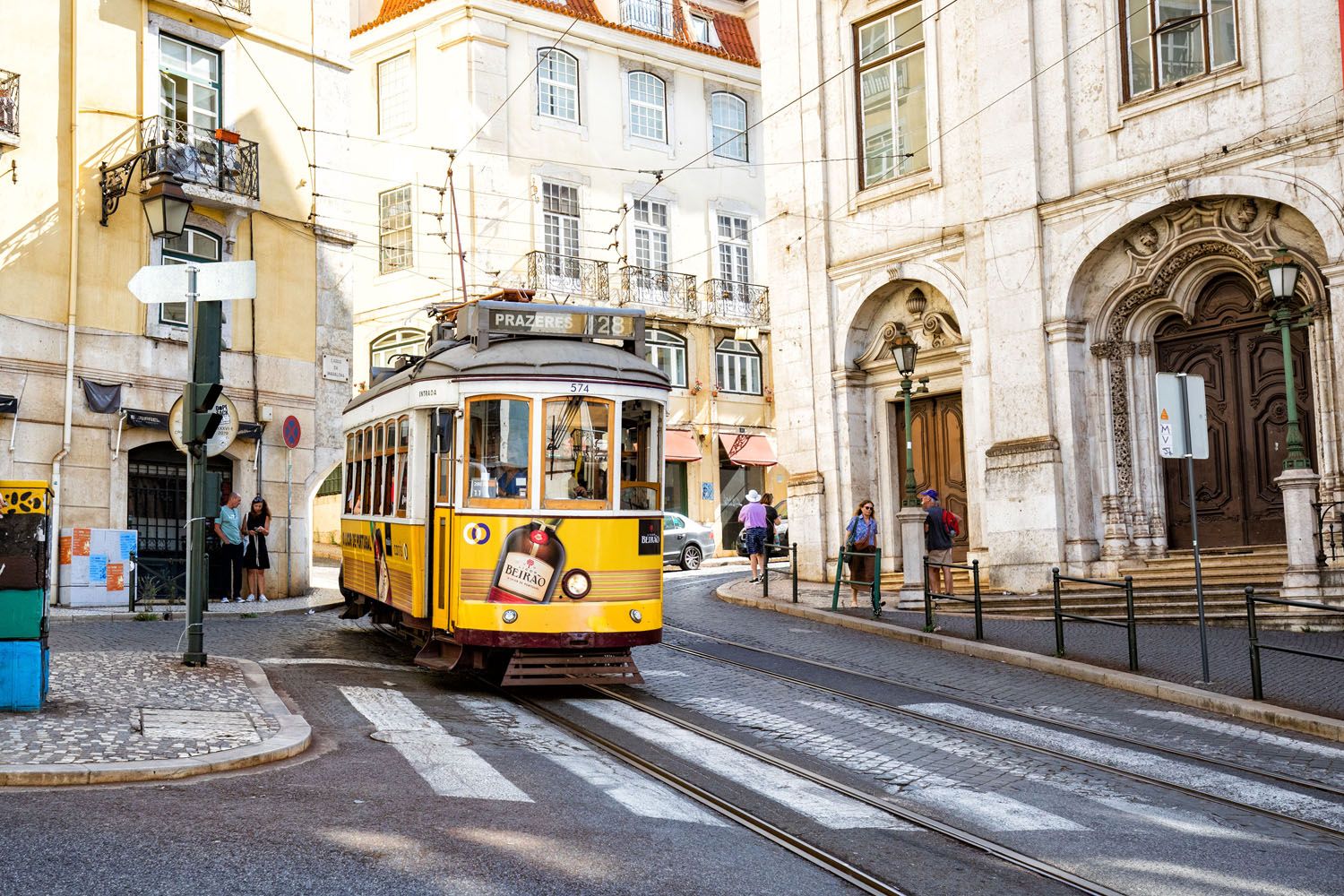
Tram 28
For those who like to take hop-on hop-off bus tours of cities, this experience is right up your alley. Just be aware that this is a popular route so the trams can be very crowded and pickpocketing can occur. To get a seat, it is best to ride the tram early in the morning and board the train at the starting point (Praça Martim Moniz). Midday, lines can be an hour long to board the tram.
When we saw these trams running through the city center, they were always completely packed with people. We chose to just take a photo of it, walking to the city sites instead.
5. Sé de Lisboa (the Lisbon Cathedral)
The Lisbon Cathedral, also called Sé de Lisbon and the Cathedral of Saint Mary Major, is the oldest church in Lisbon. It was partially destroyed in the 1755 earthquake and later underwent major renovations.
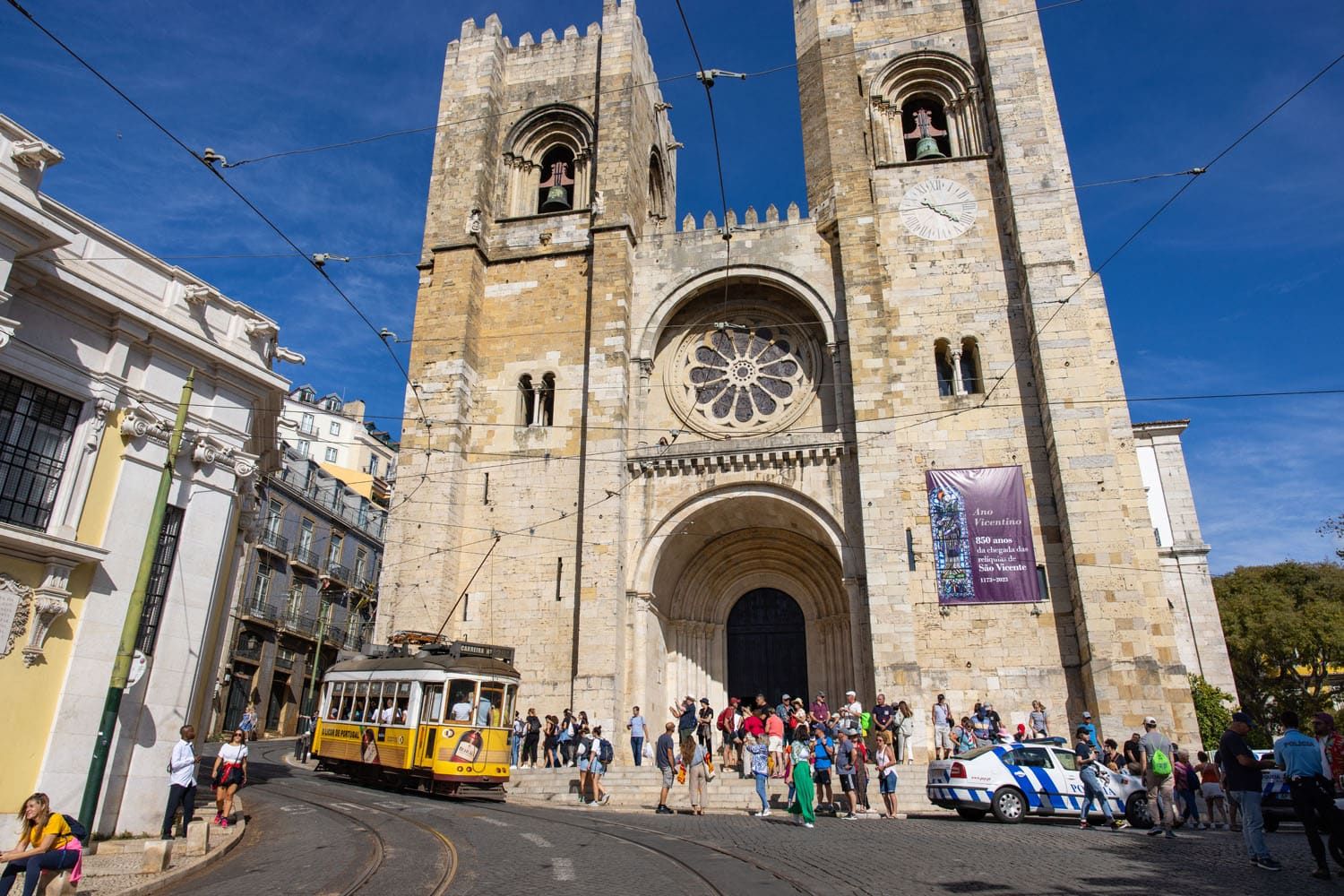
Lisbon Cathedral
On a visit to the cathedral, there are a few things to see and do.
From the upper outdoor balcony, you get a slightly elevated view over the city streets (it is worth a quick look but there are much better viewpoints of the city, as you will see later in this guide). The Treasury contains religious artifacts (photography is not allowed here). Inside of the cathedral, see the nave and walk the Gothic hallways to see the small chapels and stained-glass windows.
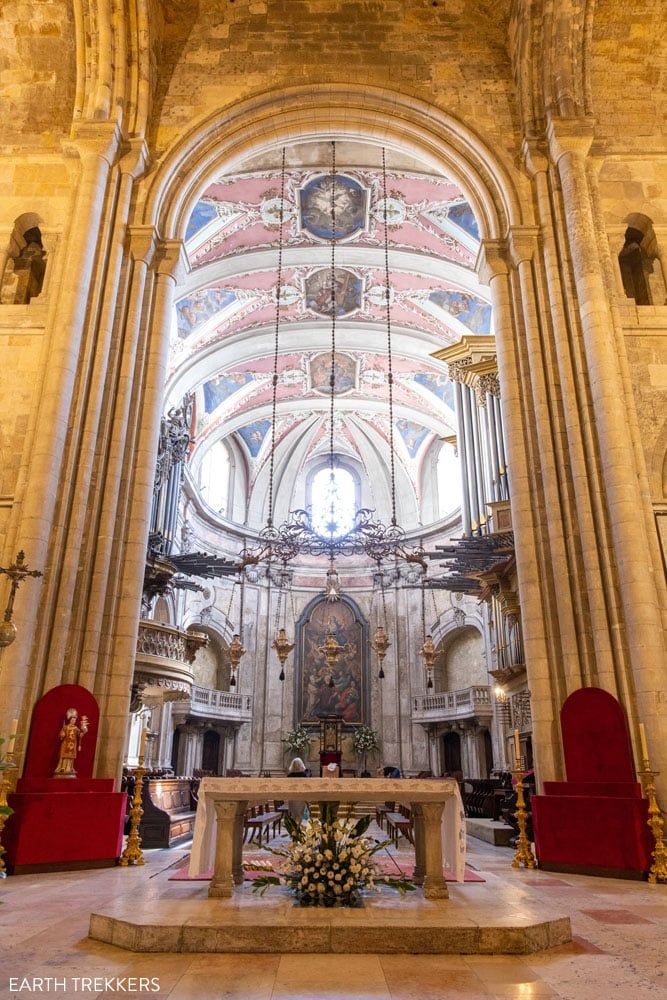
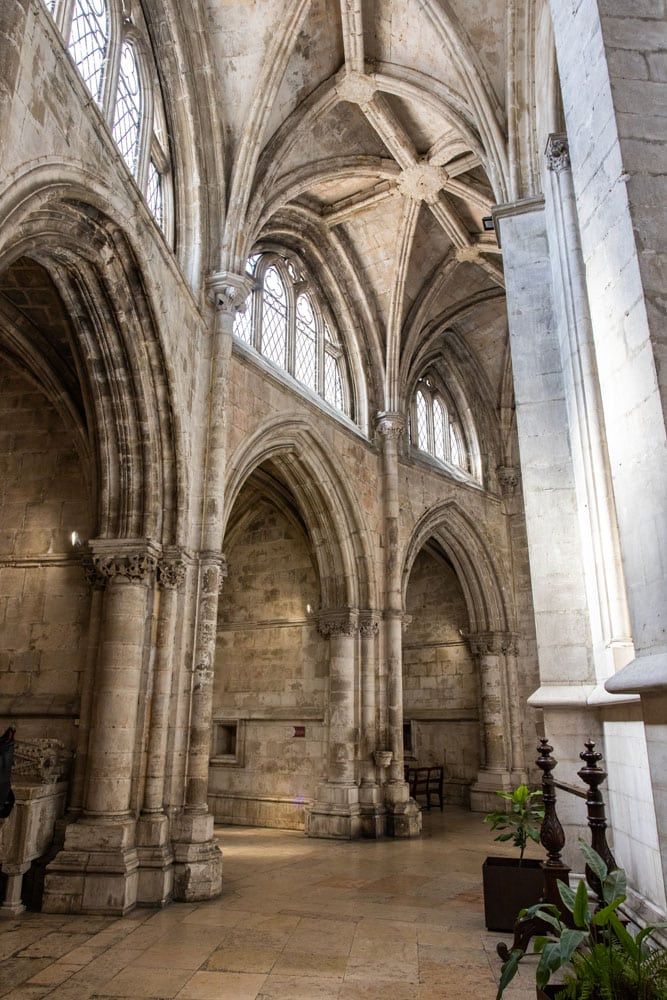
Interior of the Lisbon Cathedral
Outside, watch as Tram 28 makes its uphill journey through the city, making this one of the most iconic spots to photograph this historic tram.
There is a fee to enter the cathedral. For hours and pricing, visit the official website.
6. The Alfama District
This maze of hilly, winding streets is the oldest neighborhood in Lisbon. The 1755 earthquake amazingly did not destroy Alfama, so many of its buildings remain, although some of them have been restored in recent years.
The top sights in Alfama include the Lisbon Cathedral, Miradoura de Santa Luzia, Miradouro das Portas do Sol, and the Church of St. Antonio. Castelo de São Jorge overlooks Alfama and historic tram 28 runs through this district.
7. Miradouro de Santa Luzia
This is one of Lisbon’s most popular viewpoints and photography locations.
This small terrace is covered with grapevines, a nice respite from the sun on a hot day. It has an Amalfi Coast vibe, with its columned-terrace and waterfront views.
From Miradouro de Santa Luzia, visitors overlook the Tagus River, São Vicente de Fora Church, the buildings of the Alfama district, and most likely, several cruise ships.
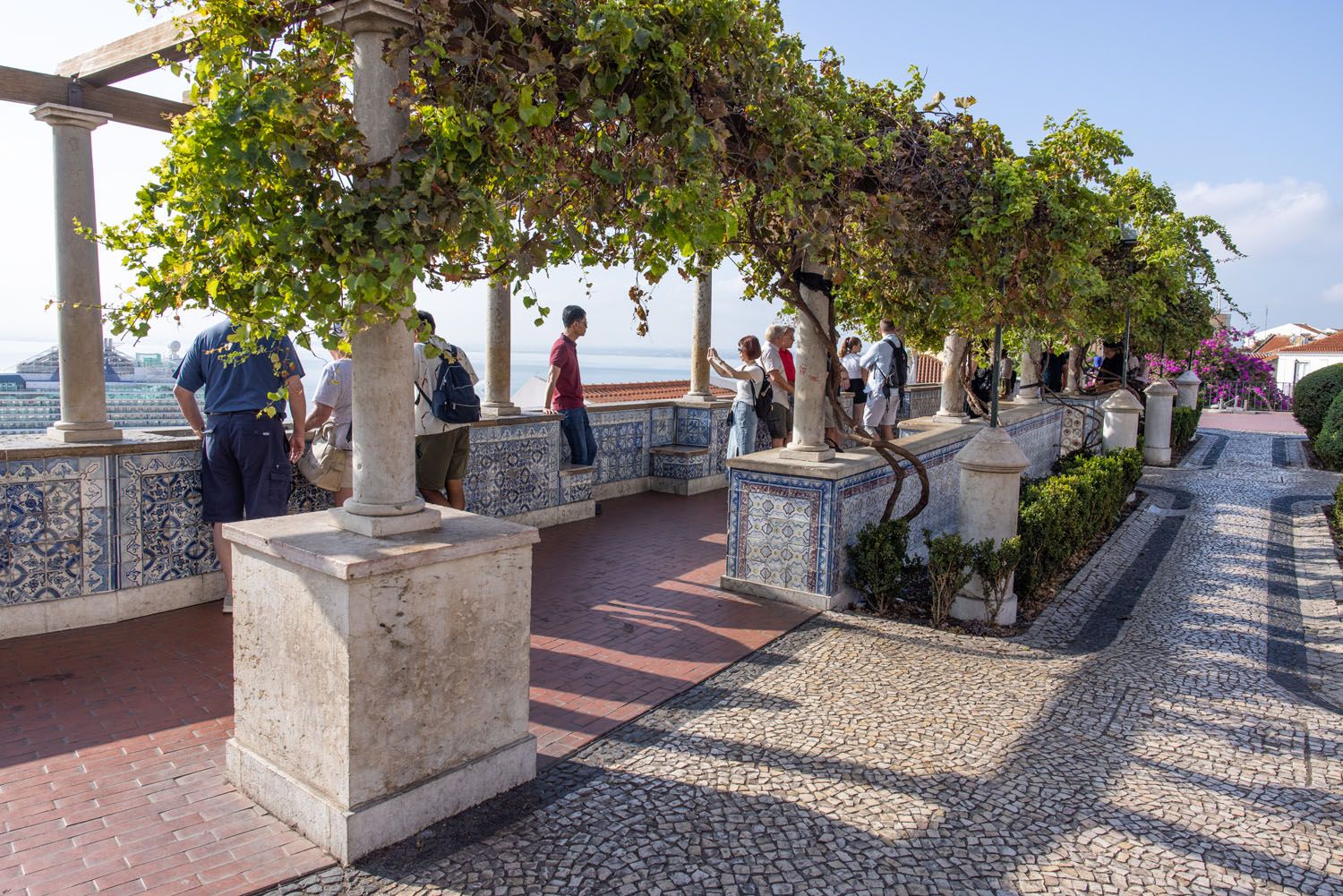
Miradouro de Santa Luzia
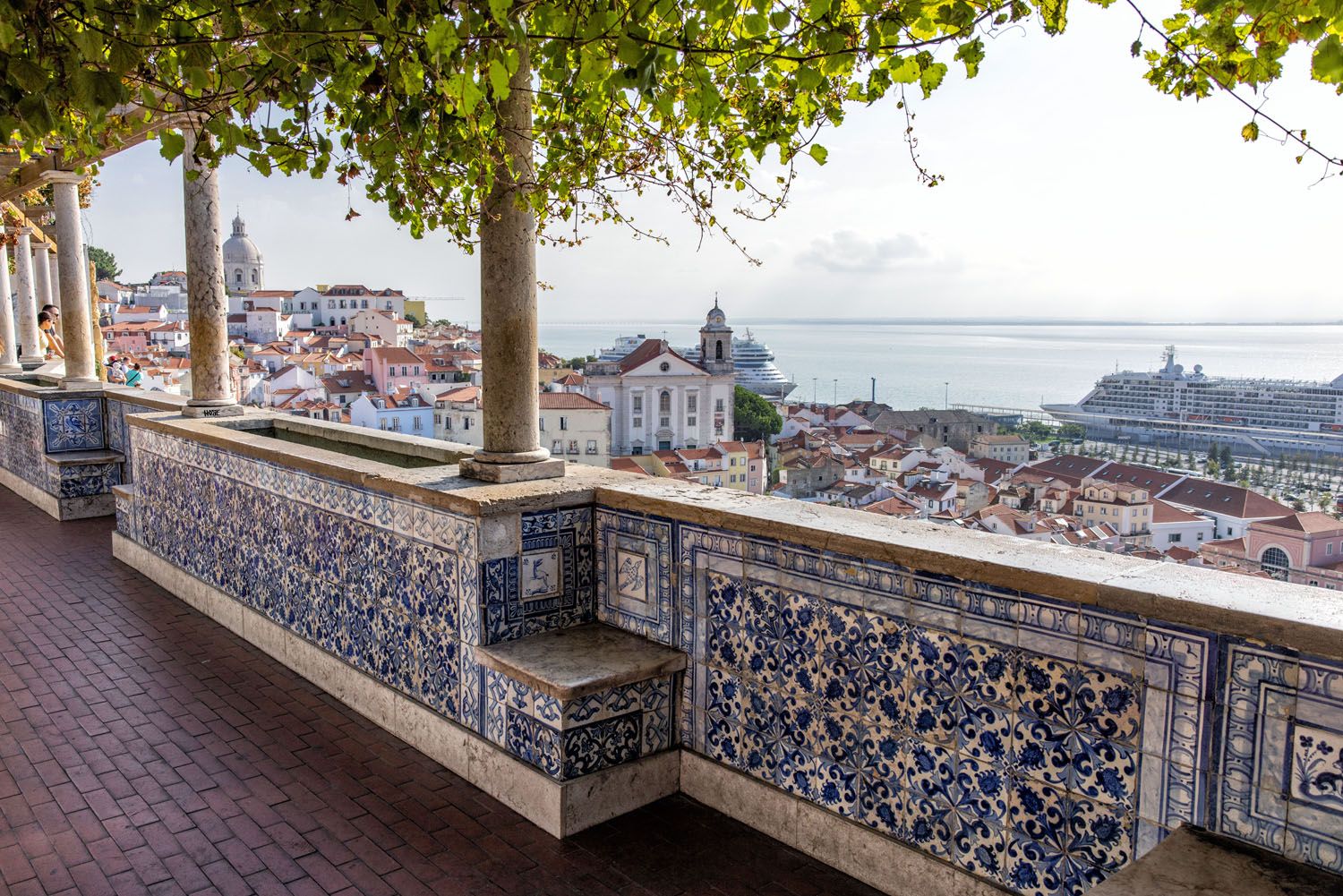
This terrace gets its name because it sits beside the Church of Santa Luzia. The outside of the church is covered with azulejos.
Since this is such a picturesque spot, plan to share this experience with a lot of people. It can get extremely crowded, so for the best experience, visit early or late in the day.
8. Miradouro das Portas do Sol
This viewpoint is just a short walk from Miradouro de Santa Luzia but we liked it more, since it was less crowded and offered a better view of the area, in our opinion.
The view is similar to Santa Luzia, but you get more of a view of Alfama than of the port and cruise ships.
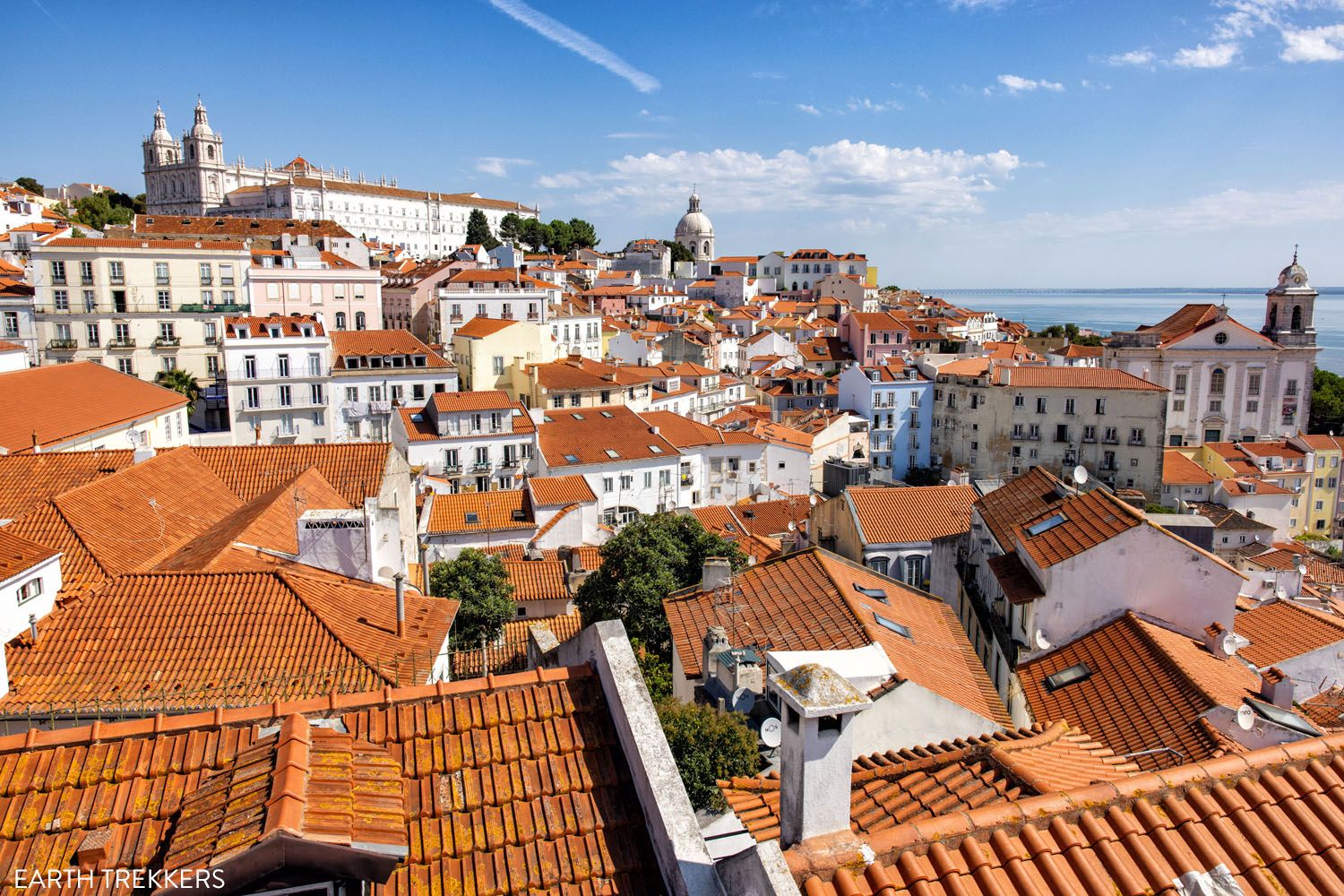
9. History of Lisbon Mural
This hidden gem is a less than a minute walk from Miradouro das Portas do Sol. Inside of a tunnel is a mural painted by Nuno Saraiva, depicting the history of Lisbon. It is painted in a comic book style and covers important historical events, such as the Portuguese Inquisition, the 1755 earthquake, and the Carnation Revolution in 1974.
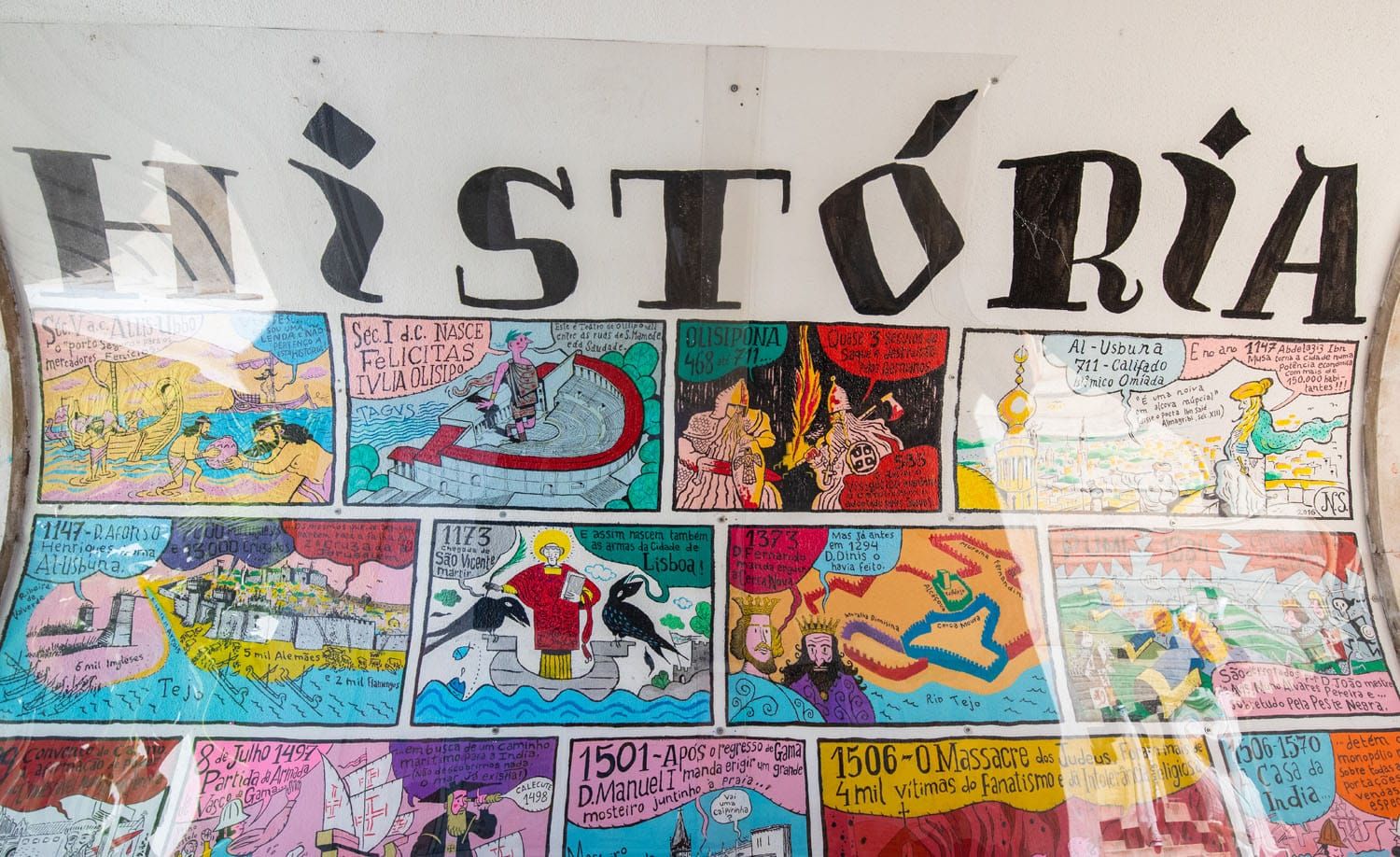
History of Lisbon Mural
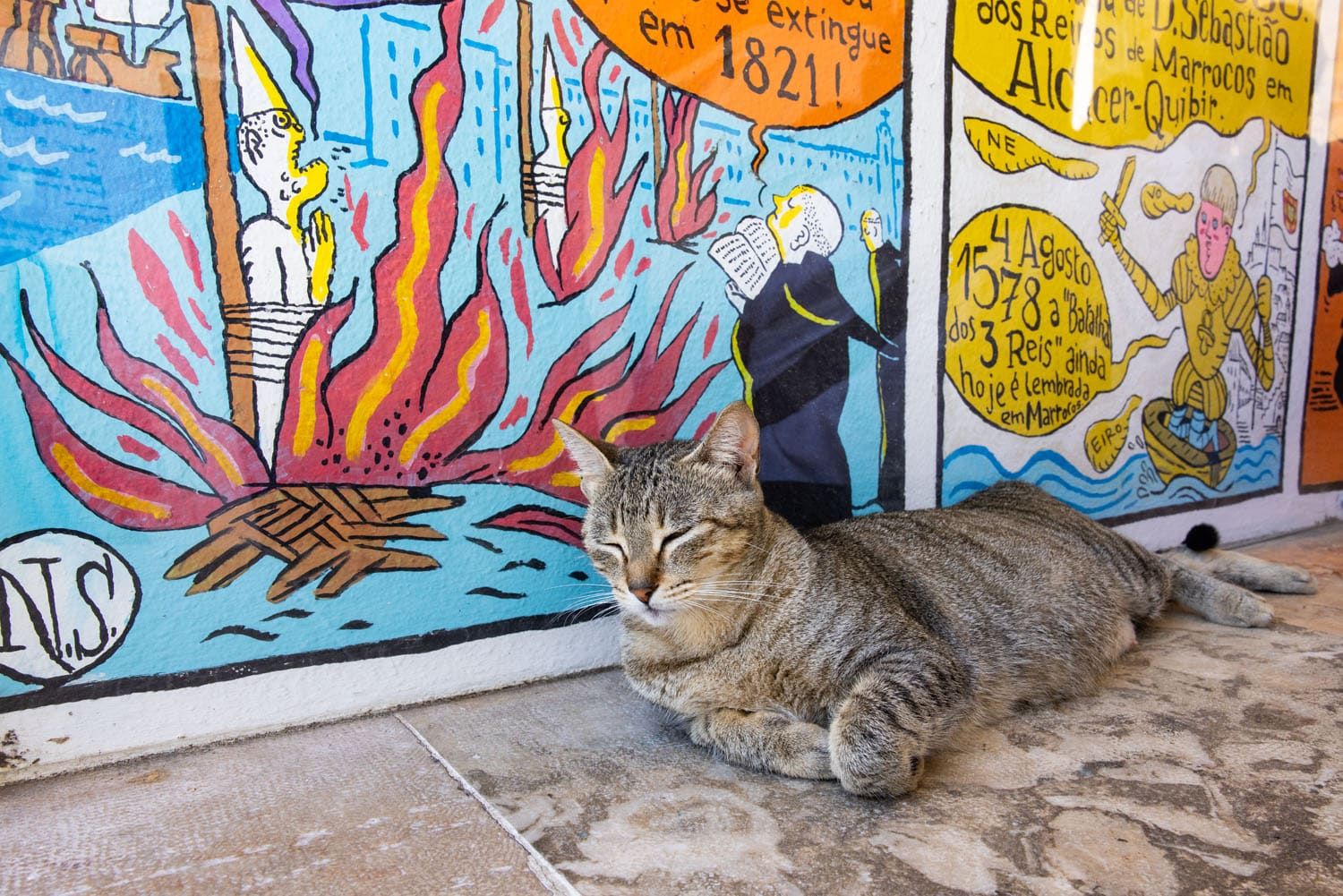
This mural is located underneath of Miradouro das Portas do Sol. To get here, walk down the steps next to the viewpoint. You only need to go down the first set of stairs and then you’ll see the mural and tunnel to your left (don’t go to the bottom of the stairs).
10. Monastery of São Vicente de Fora
With its azulejos, cloister, and stunning views from the roof, this is not to be missed on a visit to Lisbon. What makes this experience even better is that we shared this visit with just a handful of other people.
The Monastery of São Vicente de Fora is one of Portugal’s most important monasteries. It was founded in 1147, the same year as the Lisbon Cathedral. The monastery was dedicated to Saint Vincent of Saragossa, whose relics were brought here from the Algarve in the 12th century. Most of what we see today date back to the 16th century.
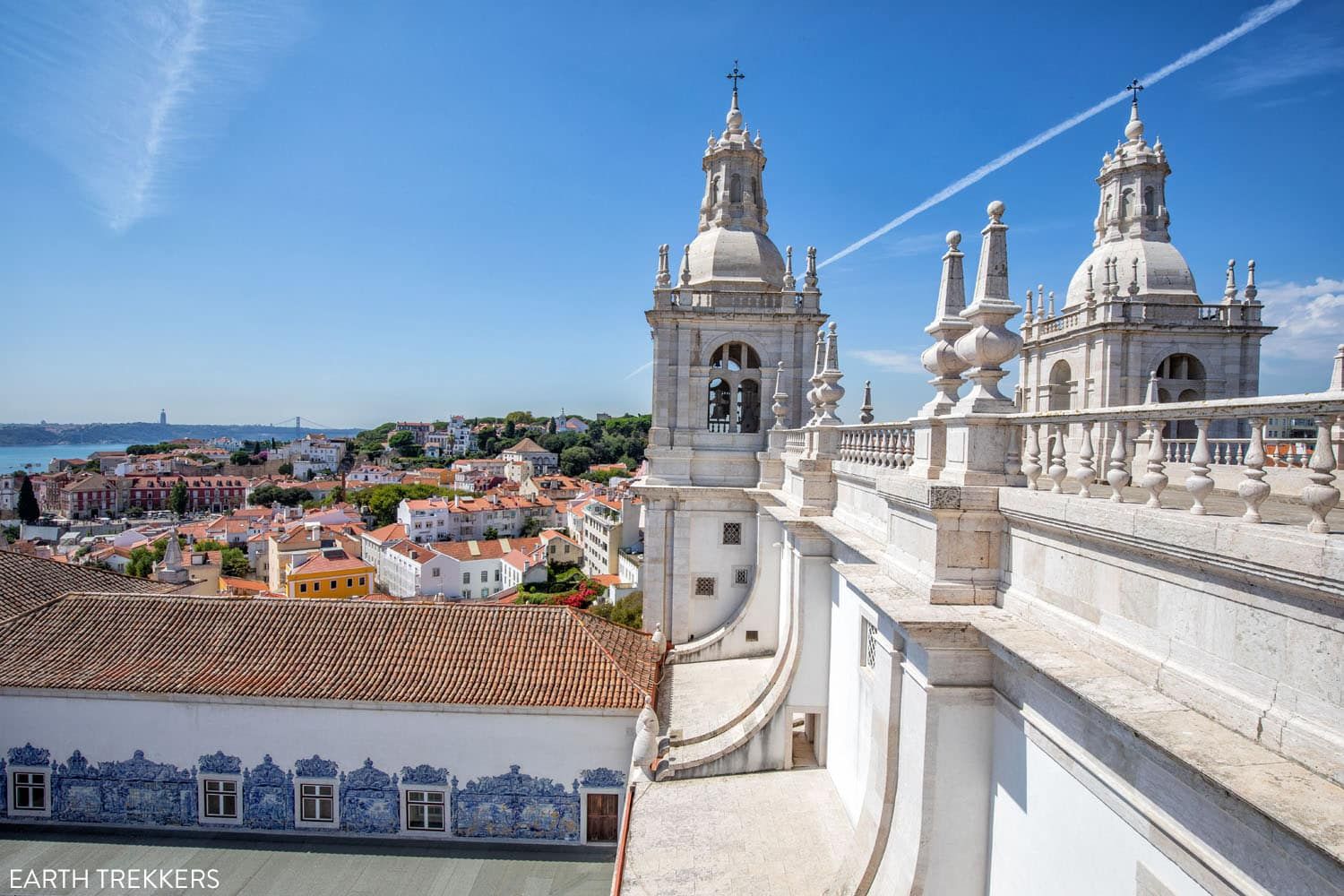
Monastery of São Vicente de Fora rooftop
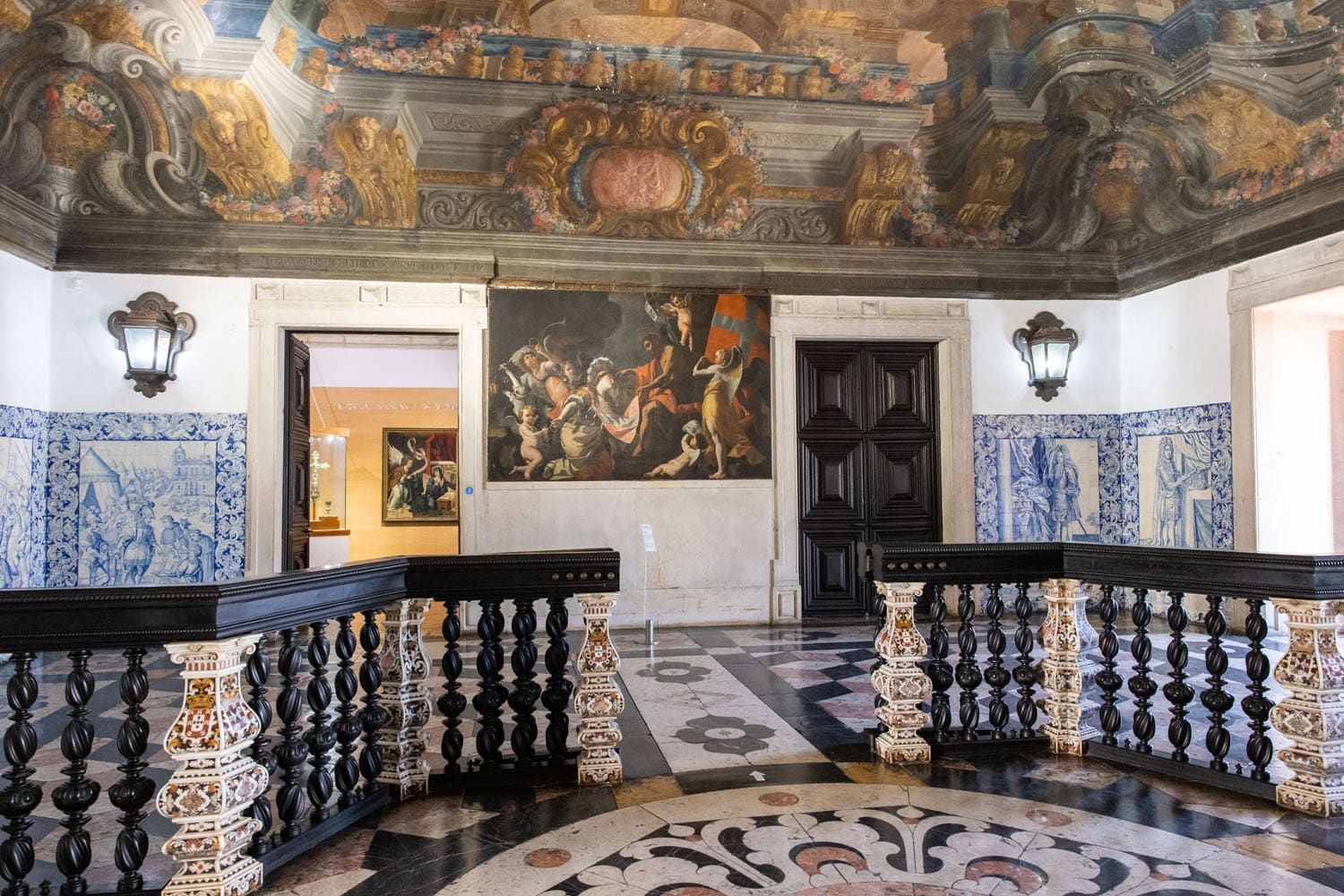
Sala da Portaria
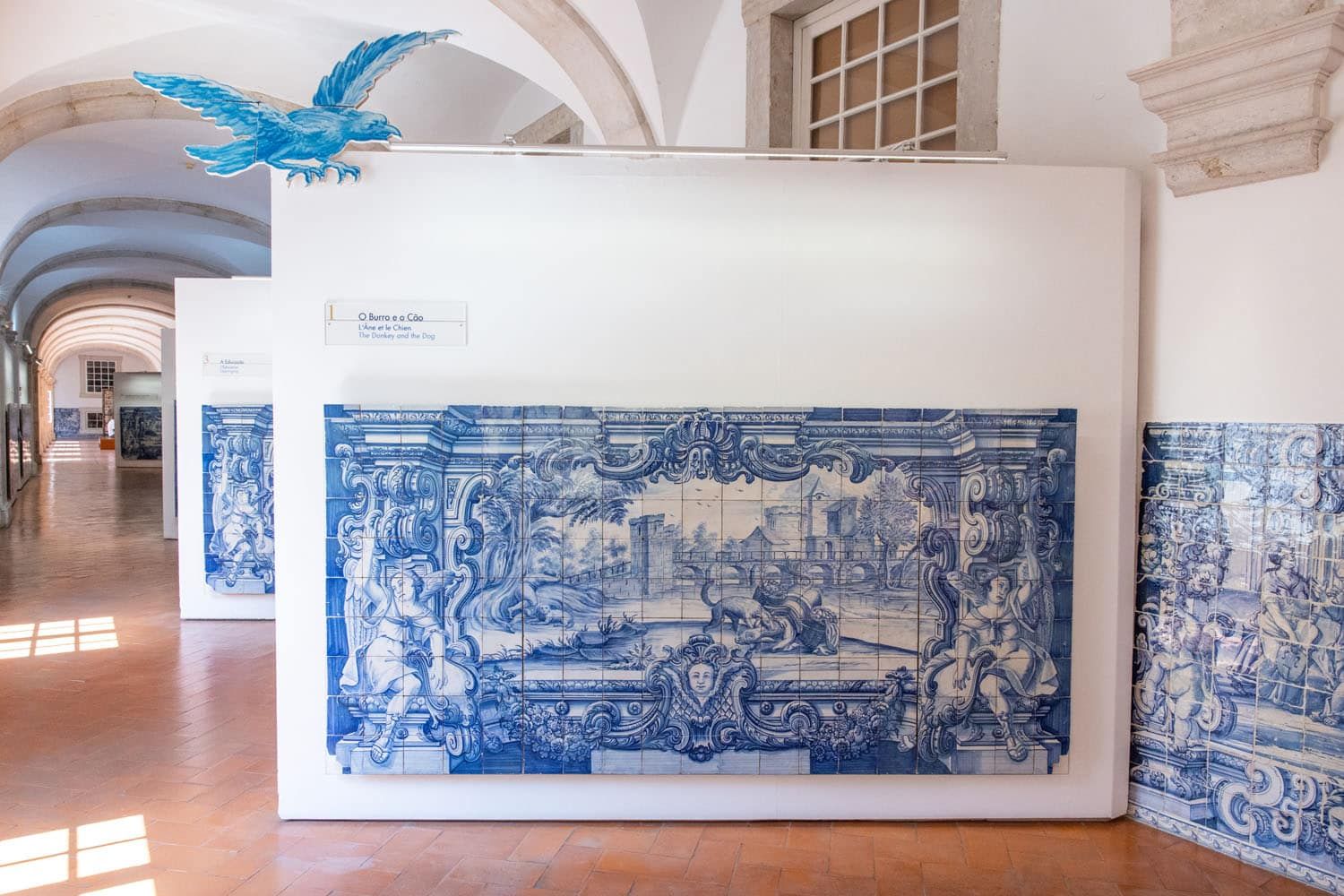
On a visit here, you will tour many of the rooms of the monastery, including the cistern, the cloister, and the pantheon, which contains the tombs of the Patriarchs of Lisbon. As you walk through the monastery, you will get to see lots of painted murals and walls covered with historical scenes, made with blue tiles.
One of the highlights is stepping onto the roof. From here, the views of Lisbon are spectacular, rivaling those at the Alfama viewpoints listed earlier.
It’s also worth a peek inside of the Church of São Vicente de Fora, which sits right next to the monastery.
For pricing and hours, visit the official website.
11. The National Pantheon
This is another underrated gem in Lisbon. The National Pantheon sits near the Monastery of São Vicente de Fora (it’s about a 5-minute walk) and it is well worth your time to add this on, if you like rooftop views and visiting off-the-beaten-path places.
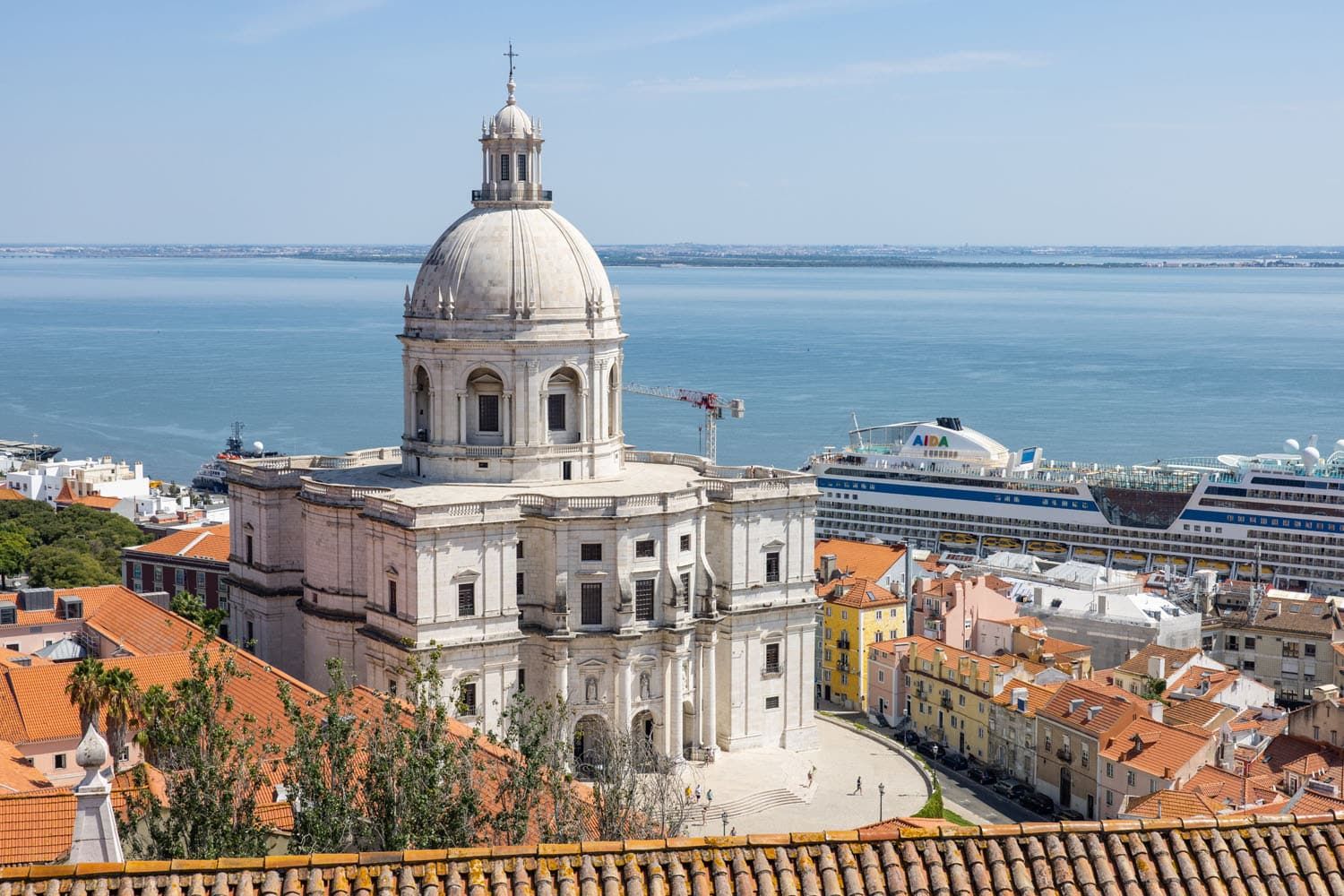
The National Pantheon (photo taken from the Monastery of São Vicente de Fora)
This building started off as the Church of Santa Engrácia and it was later converted into the National Pantheon. It was completed in 1966, making it a relatively modern building in Lisbon. Presidents of the Republic, famous writers and athletes, and fado singers are entombed here.
The pantheon is beautiful inside. It was inspired by St. Peter’s Basilica in Rome and it shares a lot of similarities to the Pantheon in Paris. But like the Monastery of São Vicente de Fora, the highlight here is visiting the roof for more views of Lisbon.
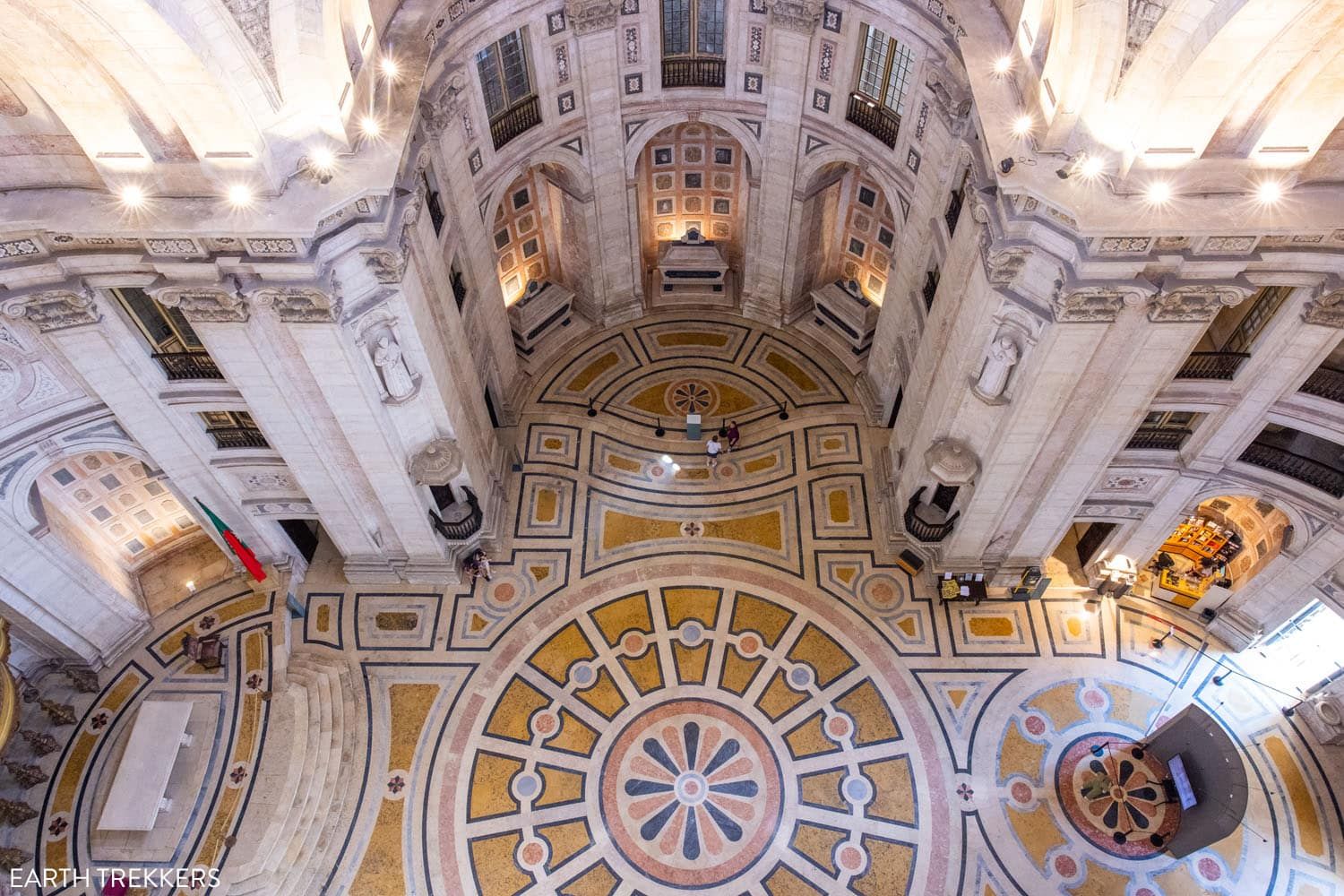
Inside the National Pantheon
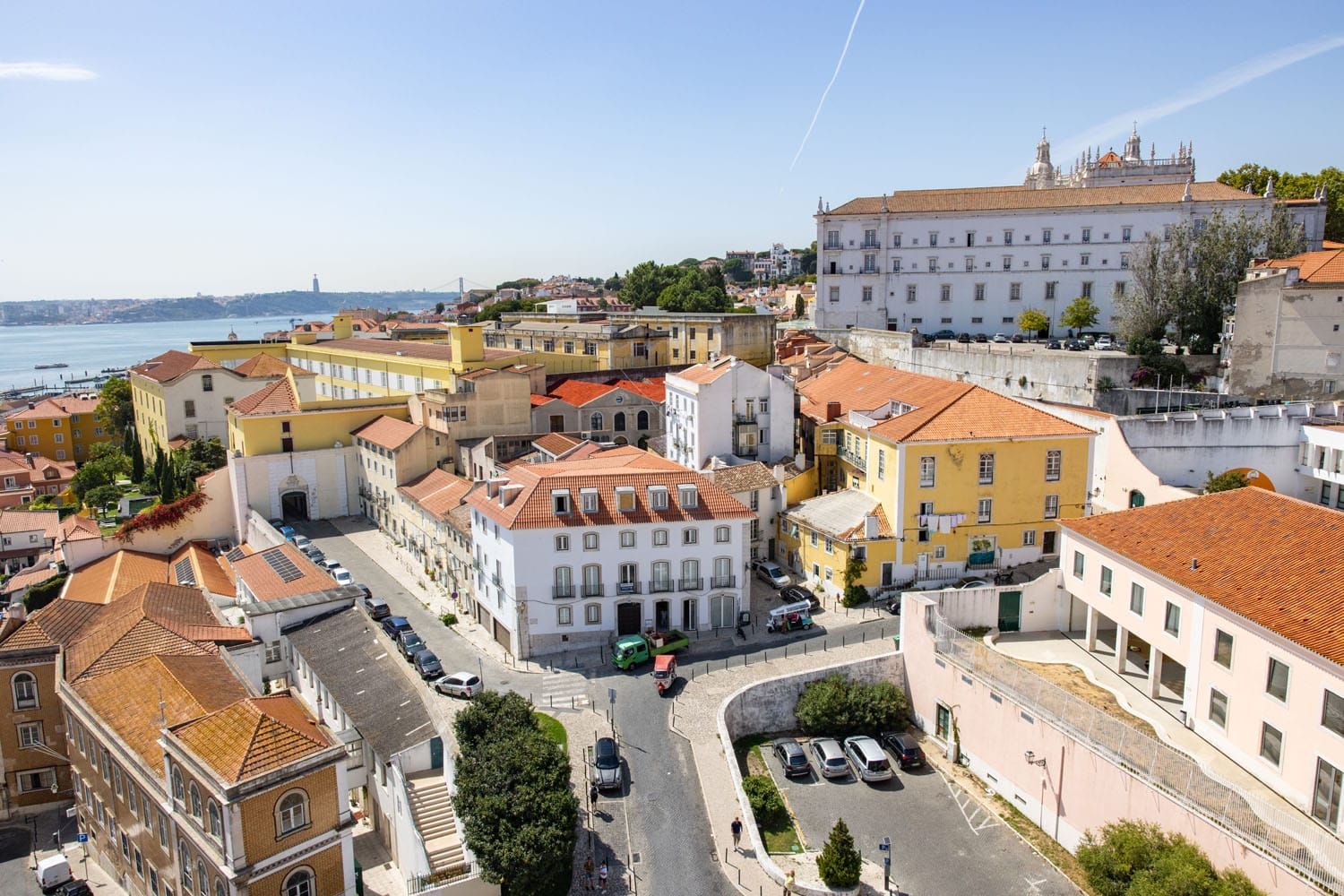
View from the National Pantheon
12. National Tile Museum
Located inside of Madre de Deus Convent, this is one of the best places in Lisbon to see azulejos, or blue tiles. This museum, also called the National Museum of the Azulejo, features a variety of murals created from blue and white ceramic tiles.
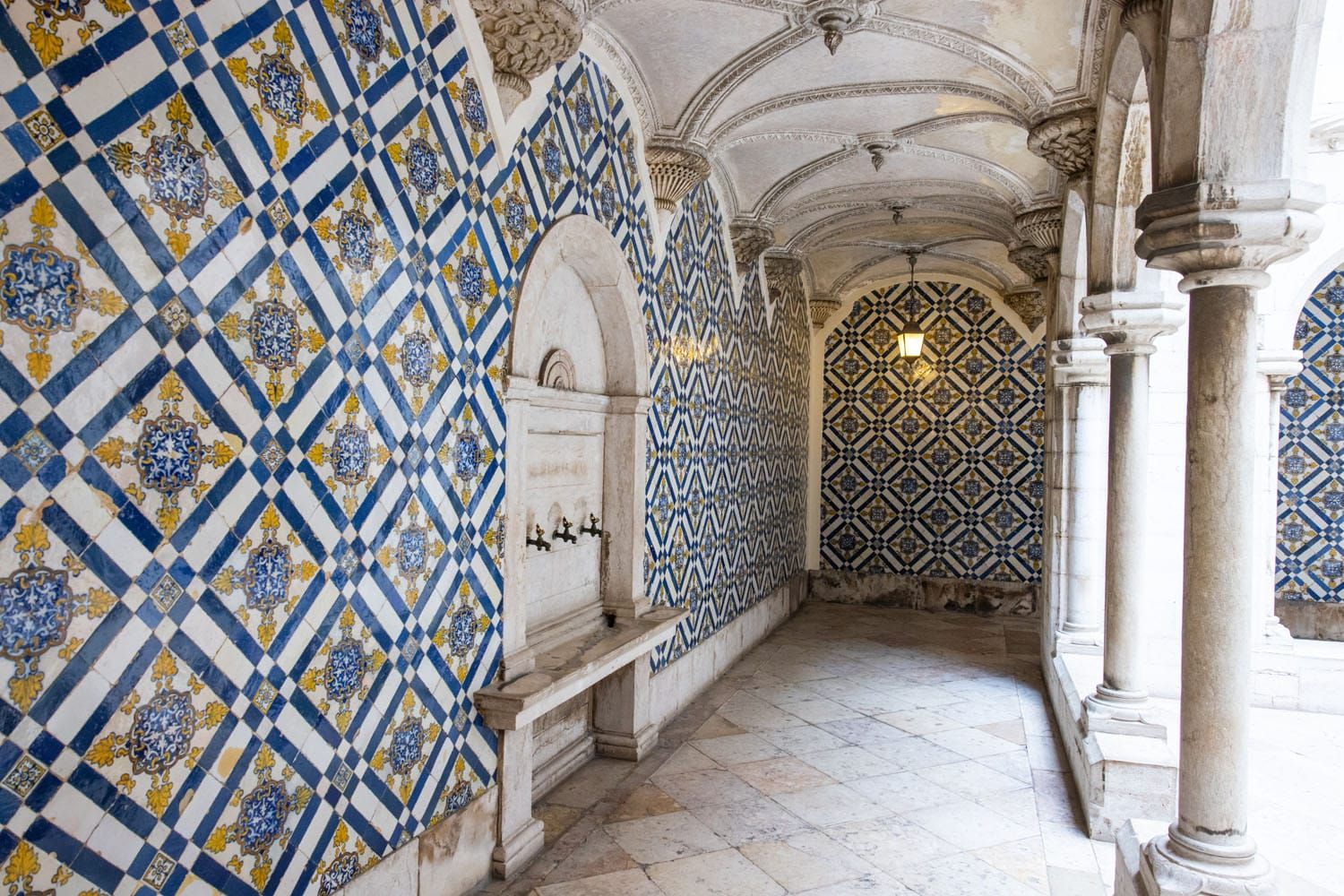
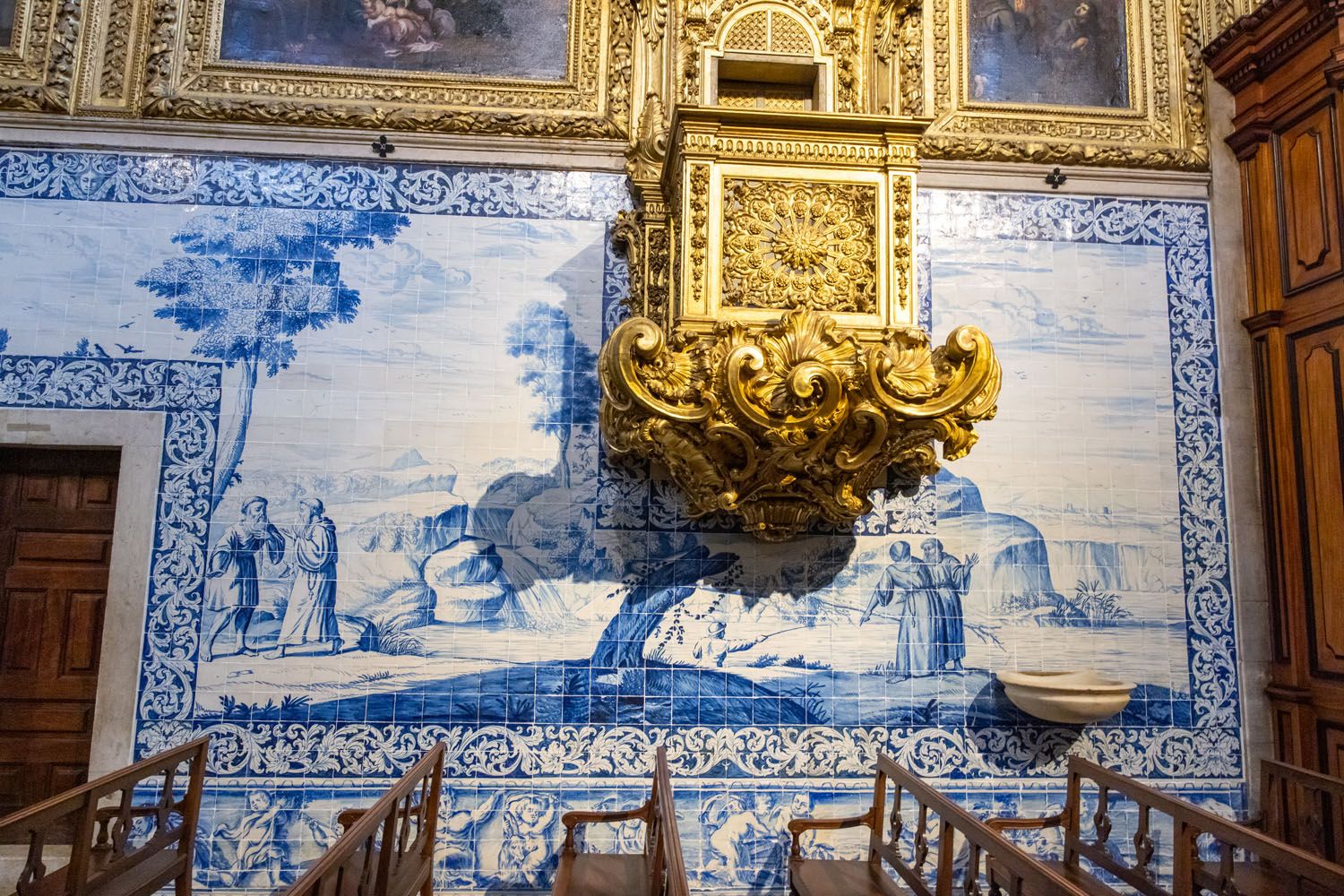
Blue tiles in the church
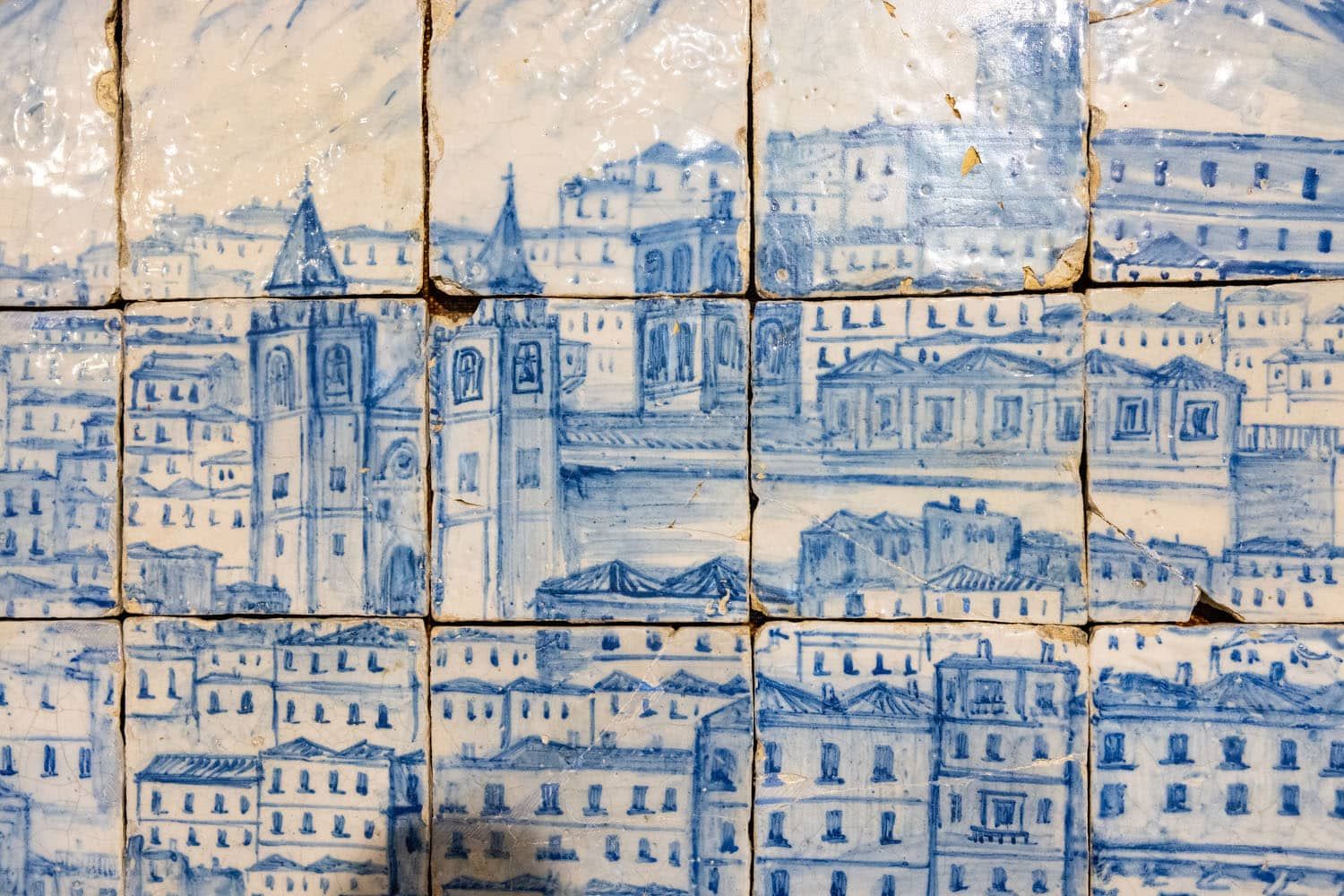
A portion of the mural of the skyline from 1738
Don’t miss mural of the Lisbon city skyline from 1738, which was created just a few years before the Great Earthquake of 1755. It’s also worth visiting the church, to see even more blue tiles.
Get hours and pricing on the official website.
13. Castelo de São Jorge
Sitting atop one of the seven hills of Lisbon is São Jorge Castle. Visiting this medieval castle is one of the best things to do in Lisbon, for its views and for its history.
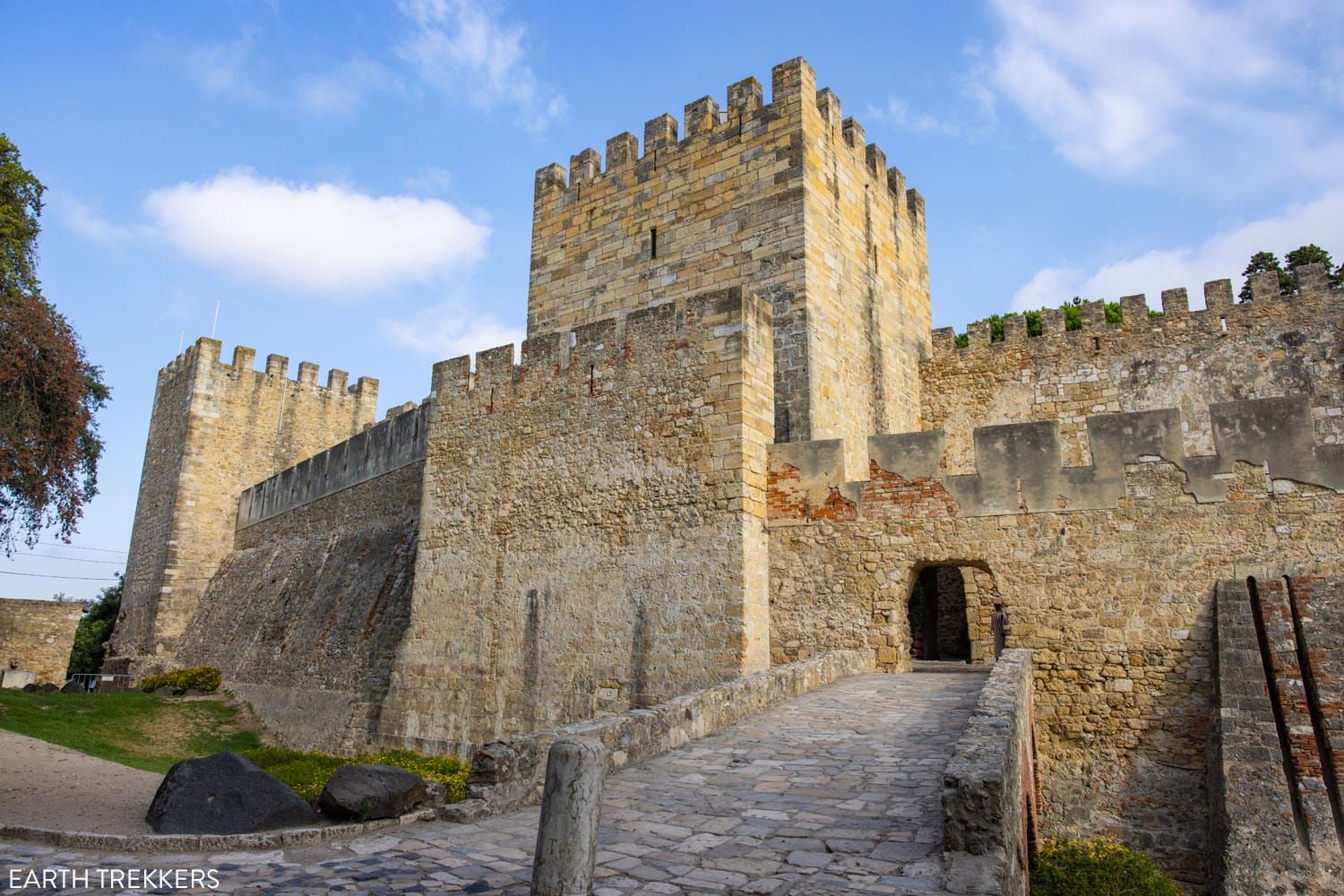
The Castle of São Jorge sits next to the Alfama district. Because of its lofty perch, this hilltop is home to fortifications that date back to the 1st century BC. It was built by the Moors and in 1255, when Lisbon became the capital of Portugal, King Afonso III used this castle as his fortified residence. The Great Earthquake severely damaged the castle. It underwent a massive renovation in the 20th century.
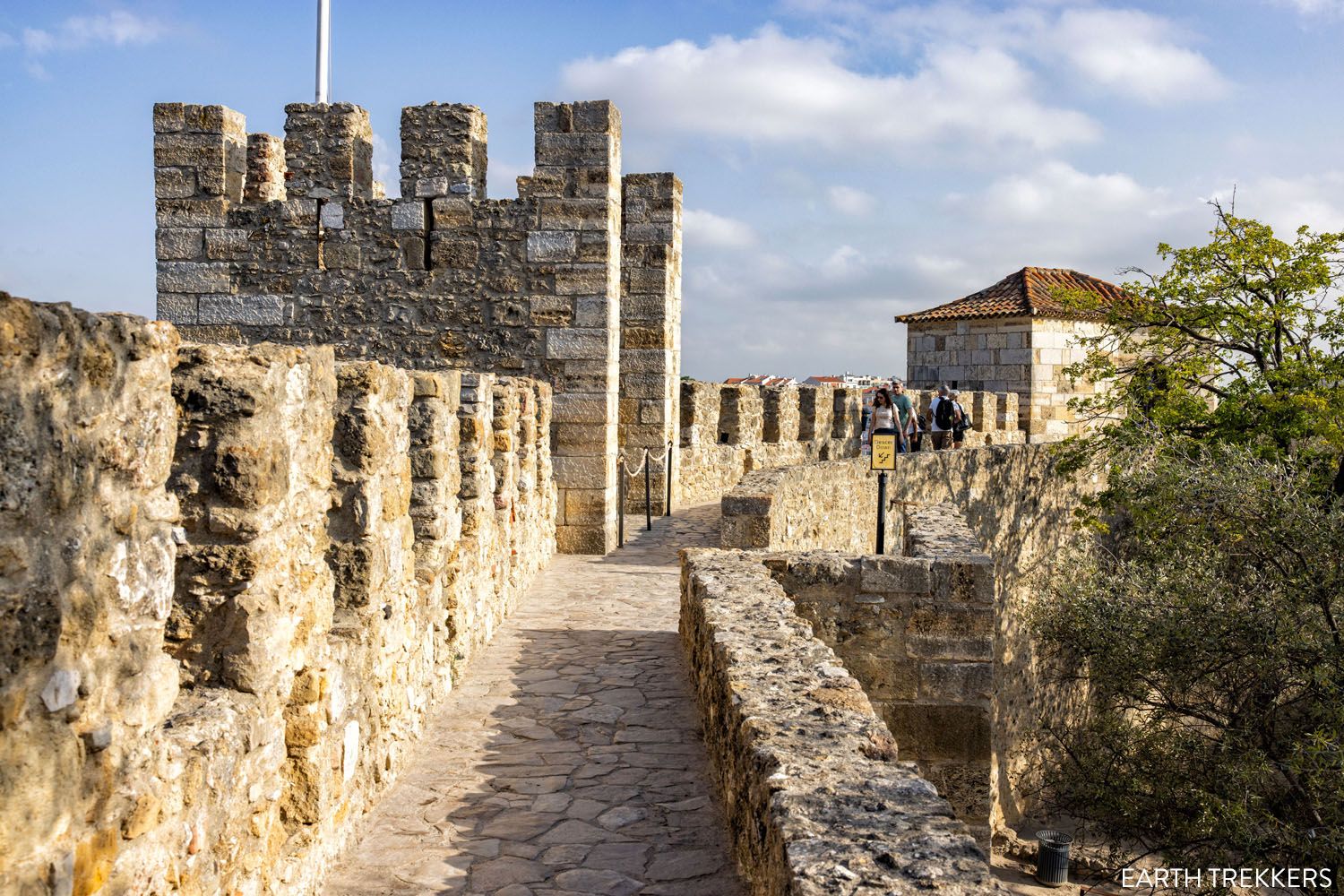
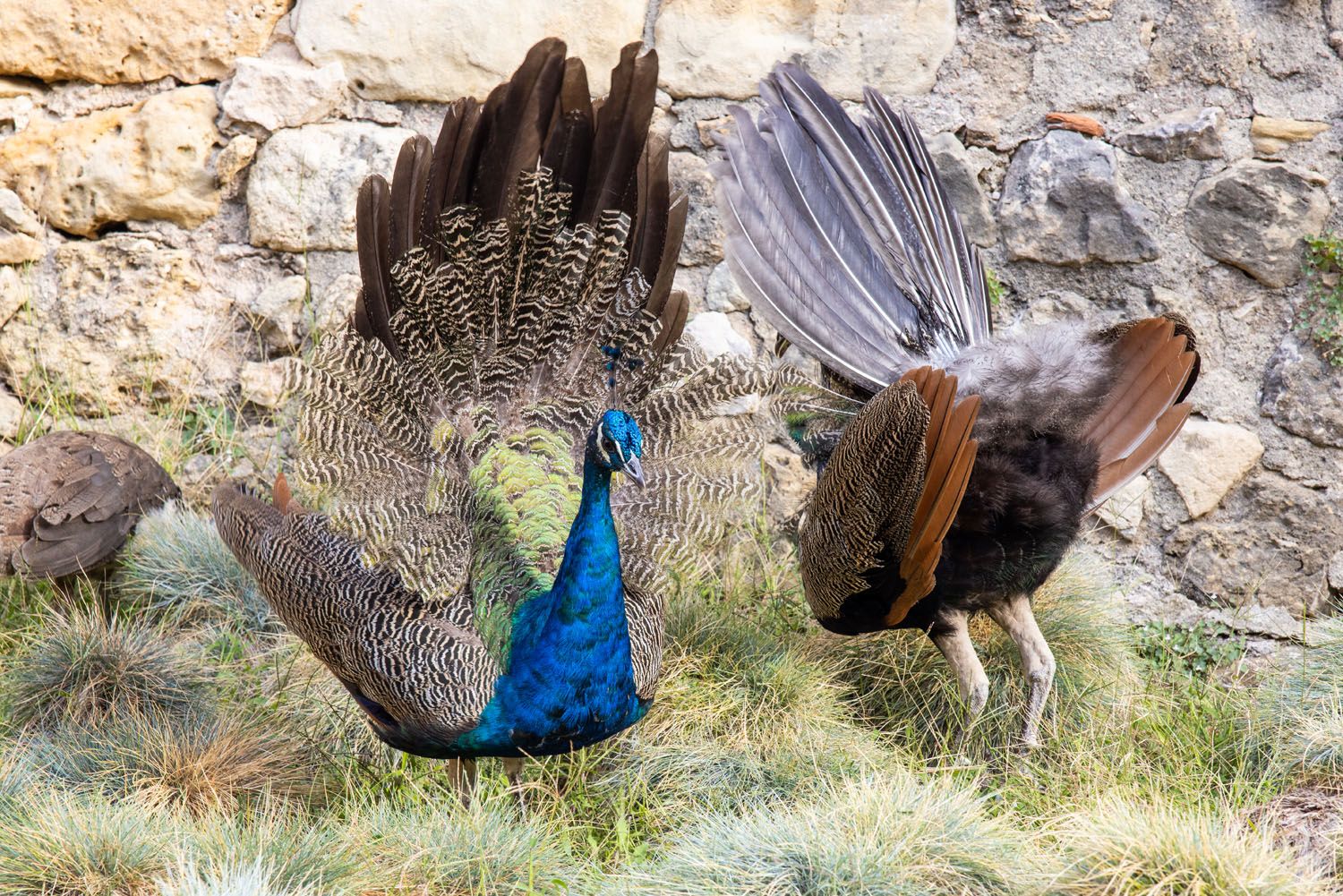
Our favorite unexpected experience was seeing the peacocks roaming throughout the castle grounds. Walking the castle walls and climbing the towers of the castle is a lot of fun and offers some amazing views of Lisbon.
Lines to enter the castle can be long. To save yourself the wait, purchase your ticket online in advance. Since the castle sits on a hilltop, be aware that it is an uphill walk to get here.
14. Miradouro da Senhora do Monte
This is one of the best viewpoints in Lisbon. From this hilltop setting, you get panoramic views of the city. São Jorge Castle, the Tagus River, and the Sanctuary of Christ the King can all be seen from here. There are a few buildings which block the view a little bit. However, just down the street is a viewpoint that is even better.
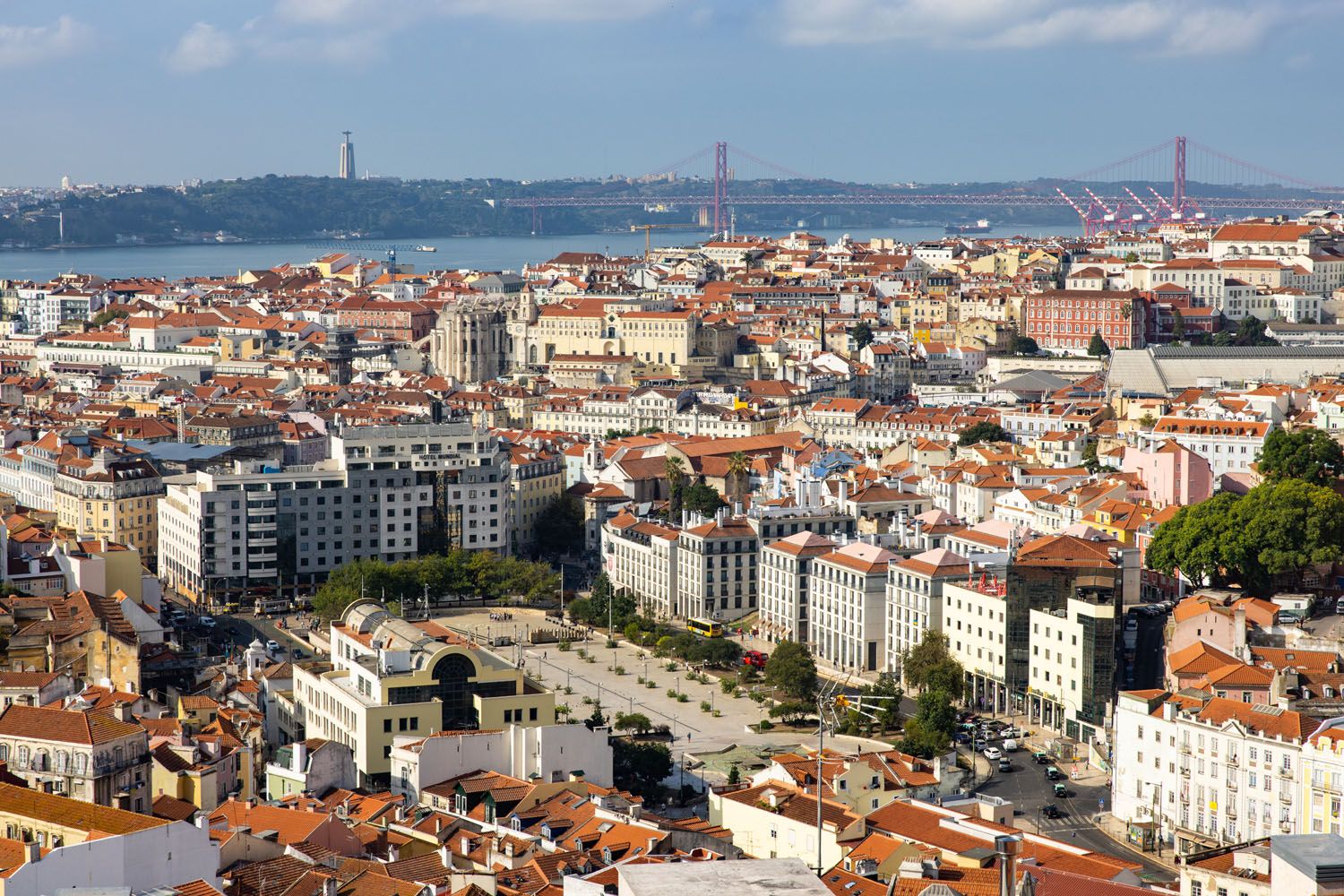
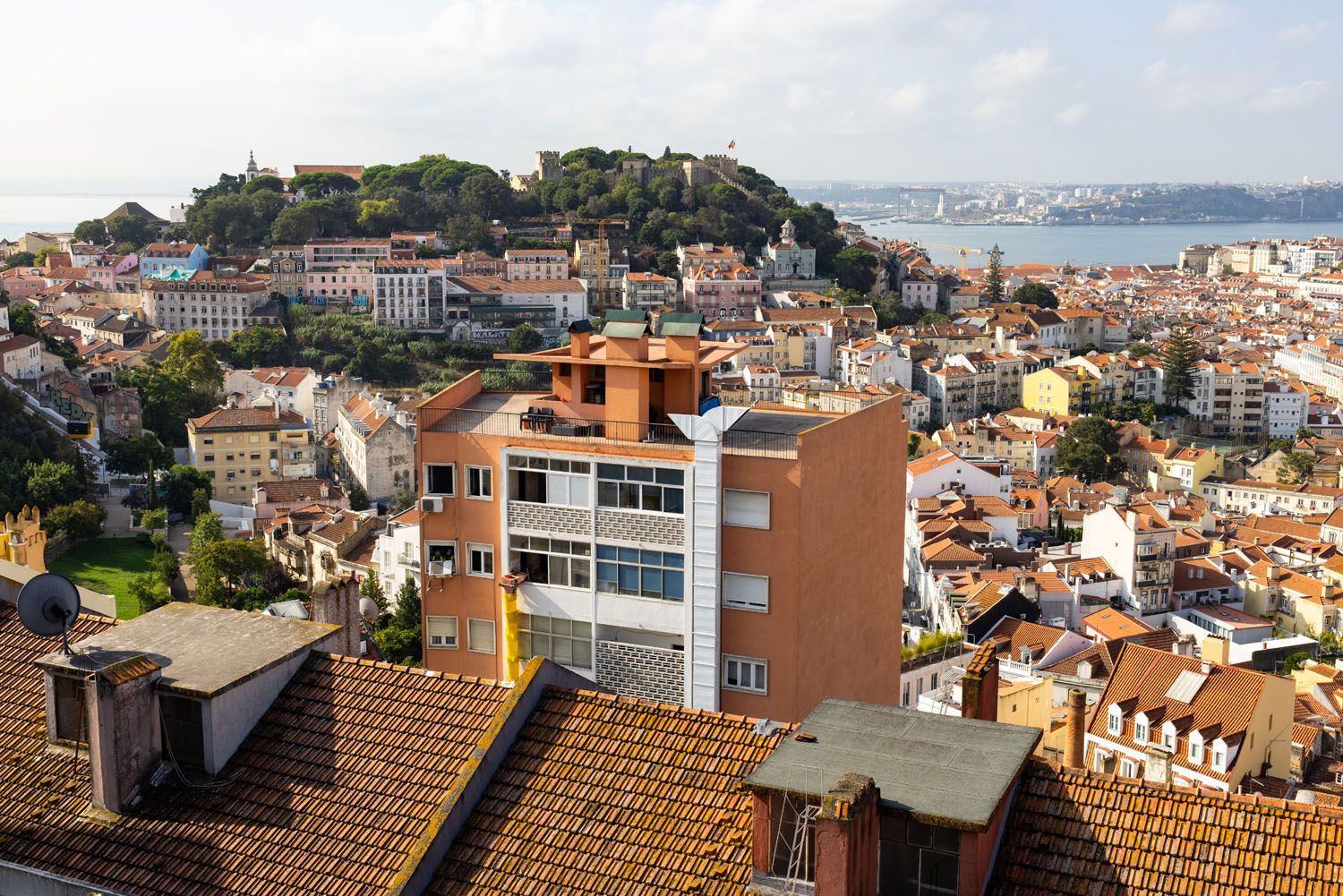
The easiest way to get here is by electric tuk-tuk, but you can walk (it will be uphill) or use Uber or Bolt.
Morning is a great time to visit this viewpoint as the sun will be to your back and the city will be illuminated by the sun.
15. The View from the Church of Our Lady of Grace Bell Tower
This is our favorite view of Lisbon.
The Church of Our Lady of Grace sits next to Jardim de Graça and another famous viewpoint in Lisbon, Miradouro da Graça.
For a small fee, you can walk up the steps of the bell tower of the Church of Our Lady of Grace for panoramic views that blow away those at Miradouro da Graça and Miradouro da Senhora do Monte. Since you are a bit higher, you get an unobstructed view without trees or buildings.
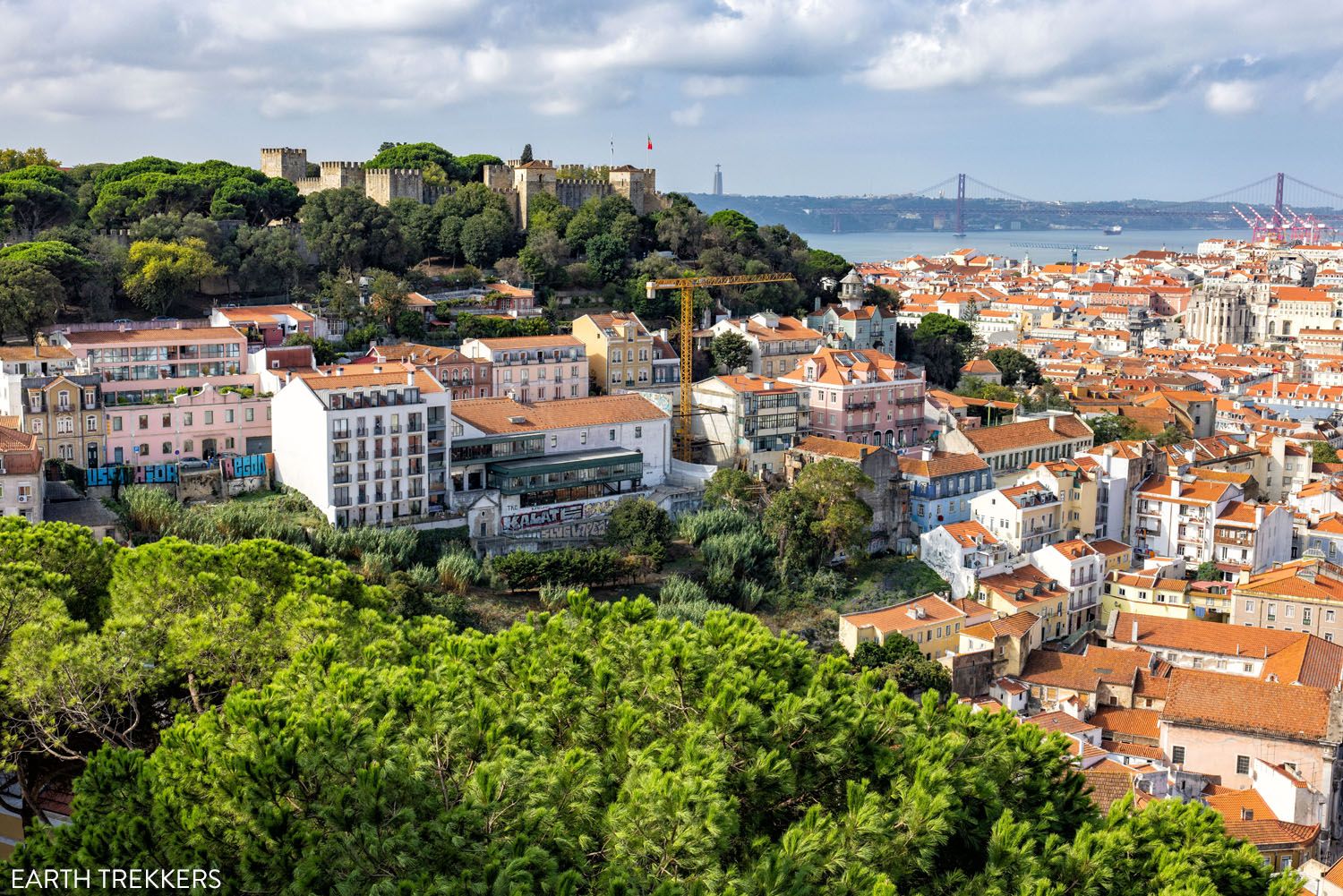
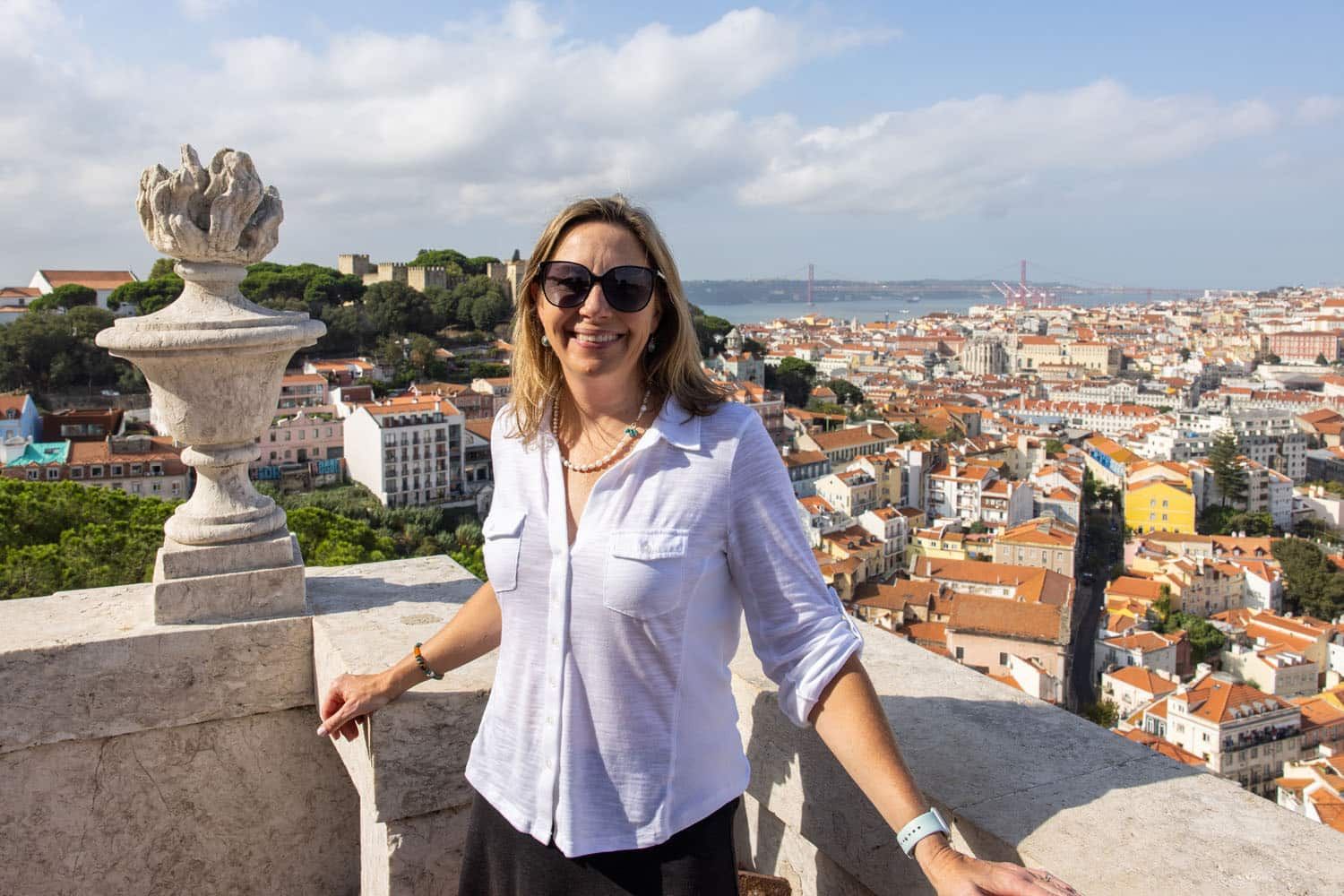
When we did this (September 2023) we had the rooftop all to ourselves. Standing on this balcony, gazing out over Lisbon, just the two of us, made this one of our favorite memories in Lisbon. The only downside is that the church is not open 24 hours a day, unlike the nearby viewpoints. You should also watch your timing, as the bell chimes several times per hour and can be quite loud.
For hours and pricing, visit the official website.
Miradouro da Graça: This viewpoint sits next to the Church of Our Lady of Grace. The view from here is just so-so, because there are a few buildings and trees that block part of the view. It’s better to pay the small fee and climb the bell tower of the church.
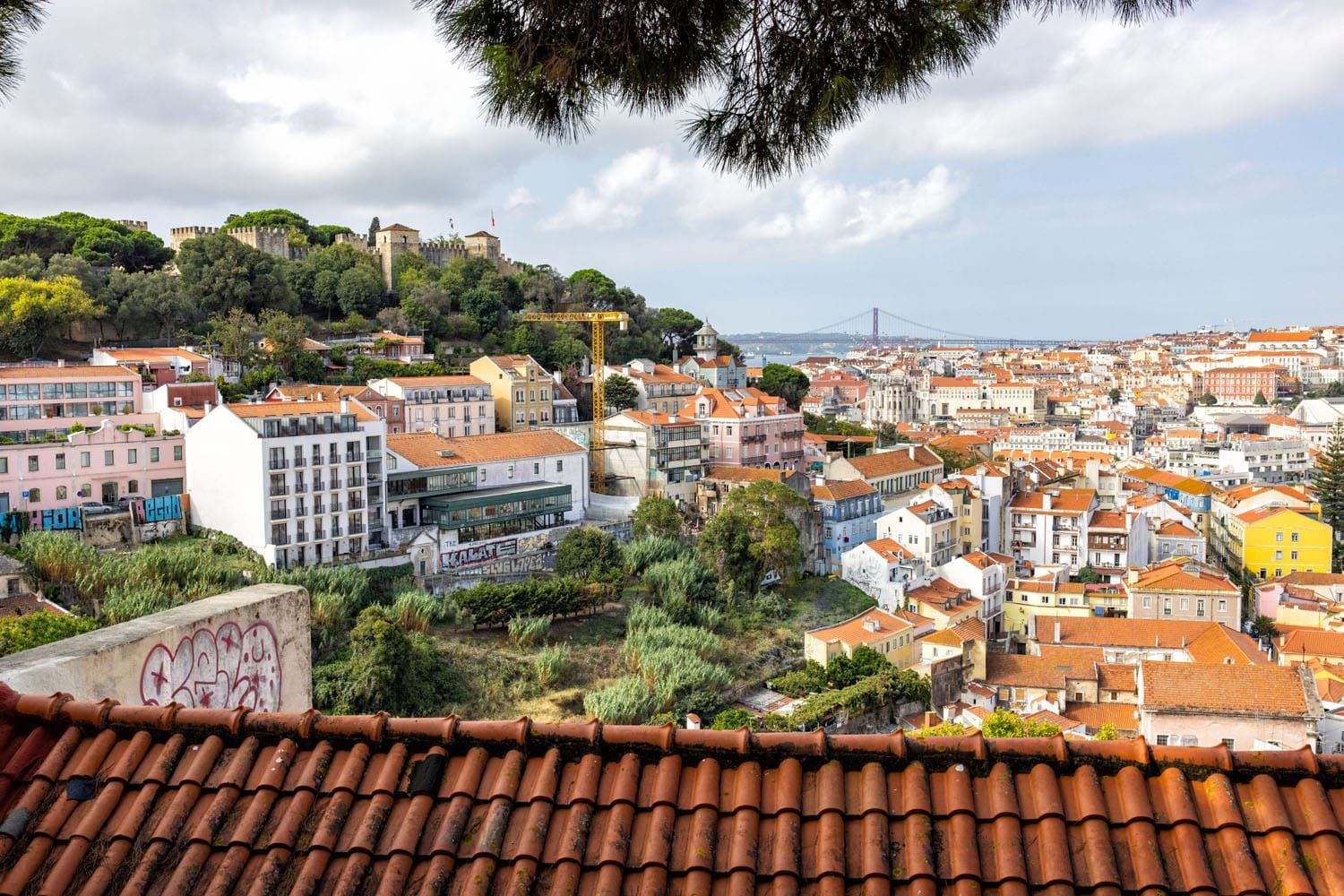
Miradouro da Graça
16. Praça do Rossio
Praça do Rossio (Rossio Square) is another name for the King Pedro IV Square. This square sits in the city center and it surrounded by important buildings, such as the Rossio Train Station and Teatro Nacional D. Maria III. Fountains sit on either end of the square and a statue of Dom Pedro IV is the centerpiece. The highlight is seeing the graceful waves of Portuguese tiles.
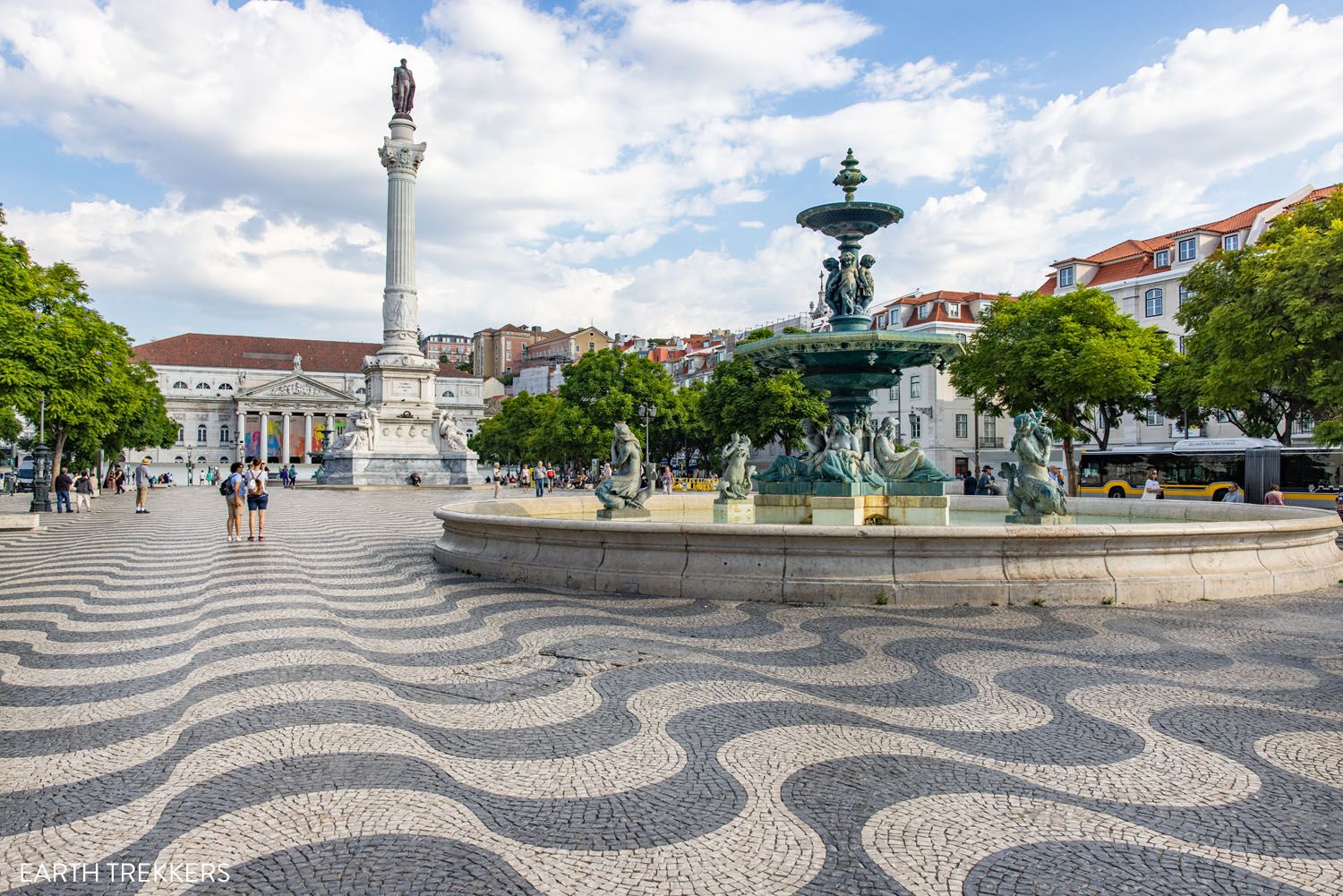
Praça do Rossio | Best Things to Do in Lisbon
17. Santa Justa Lift
The Santa Justa Lift is an iconic landmark in city center of Lisbon. Inaugurated in 1902, this wrought-iron lift connects the Baixa district with Carmo Square.
From the upper terrace of the lift, you guessed it, you get another panoramic view of Lisbon.
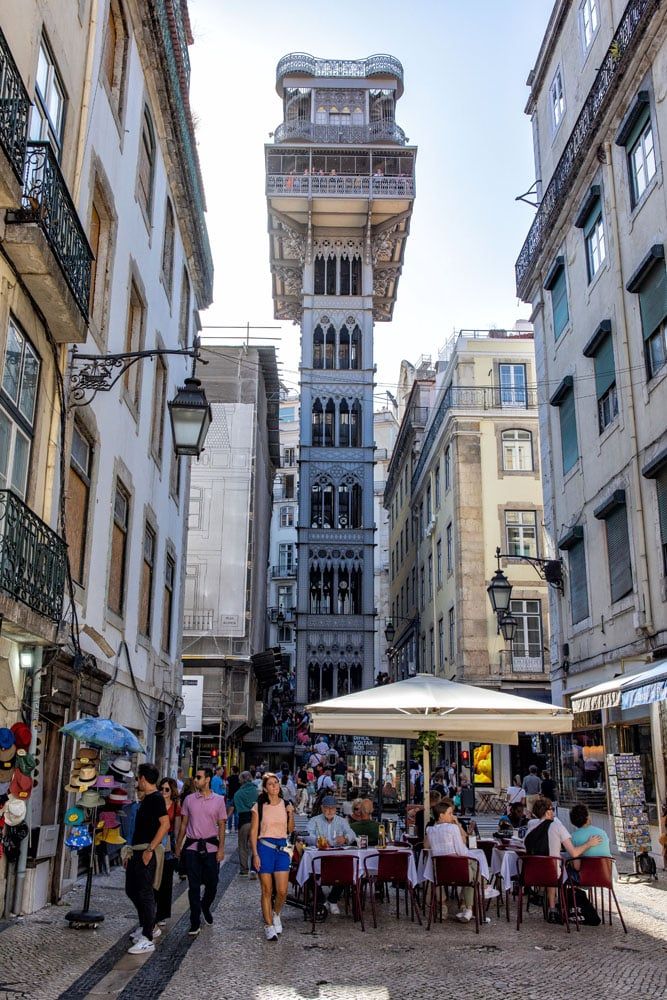
Santa Justa Lift
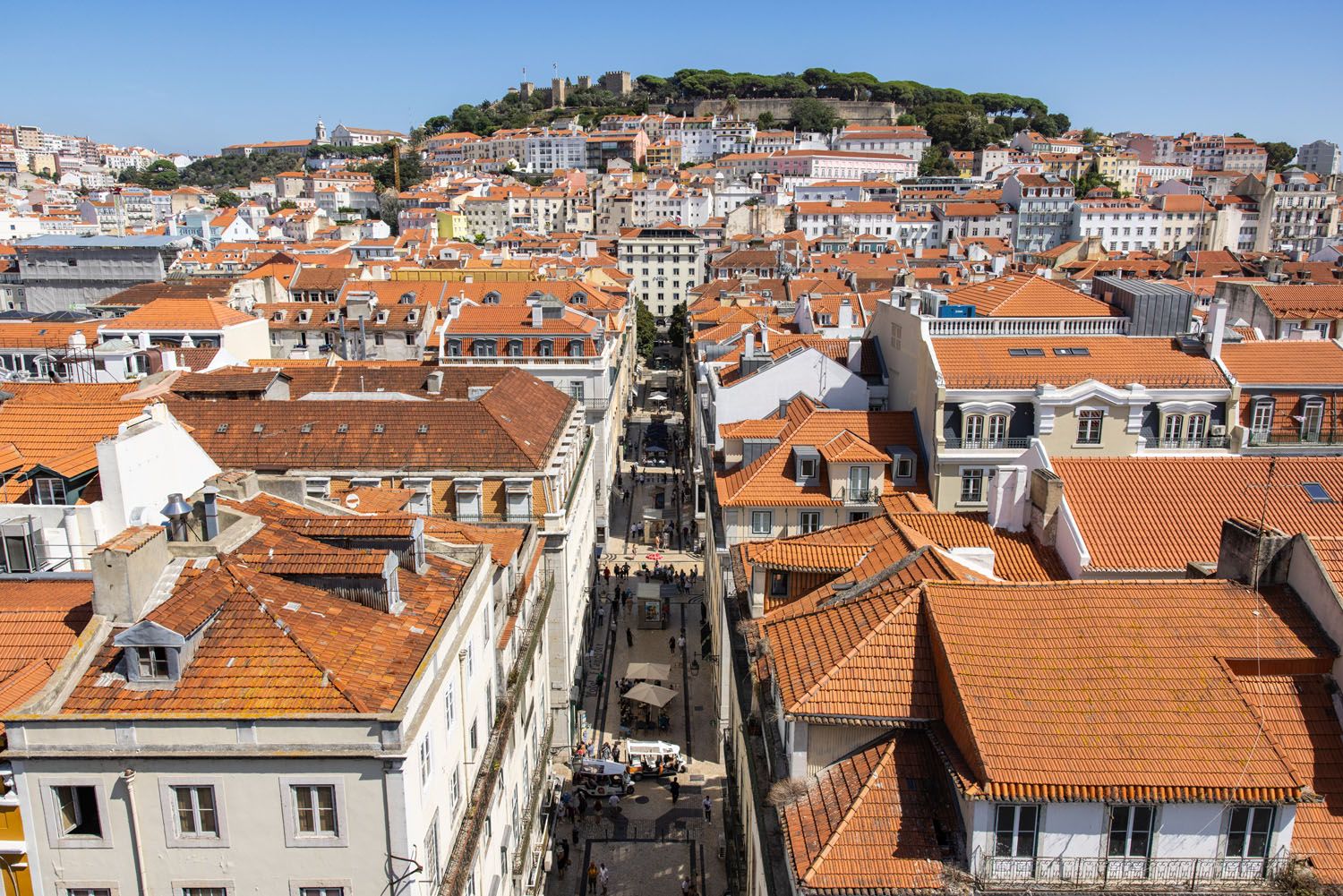
The view from the Santa Justa Lift
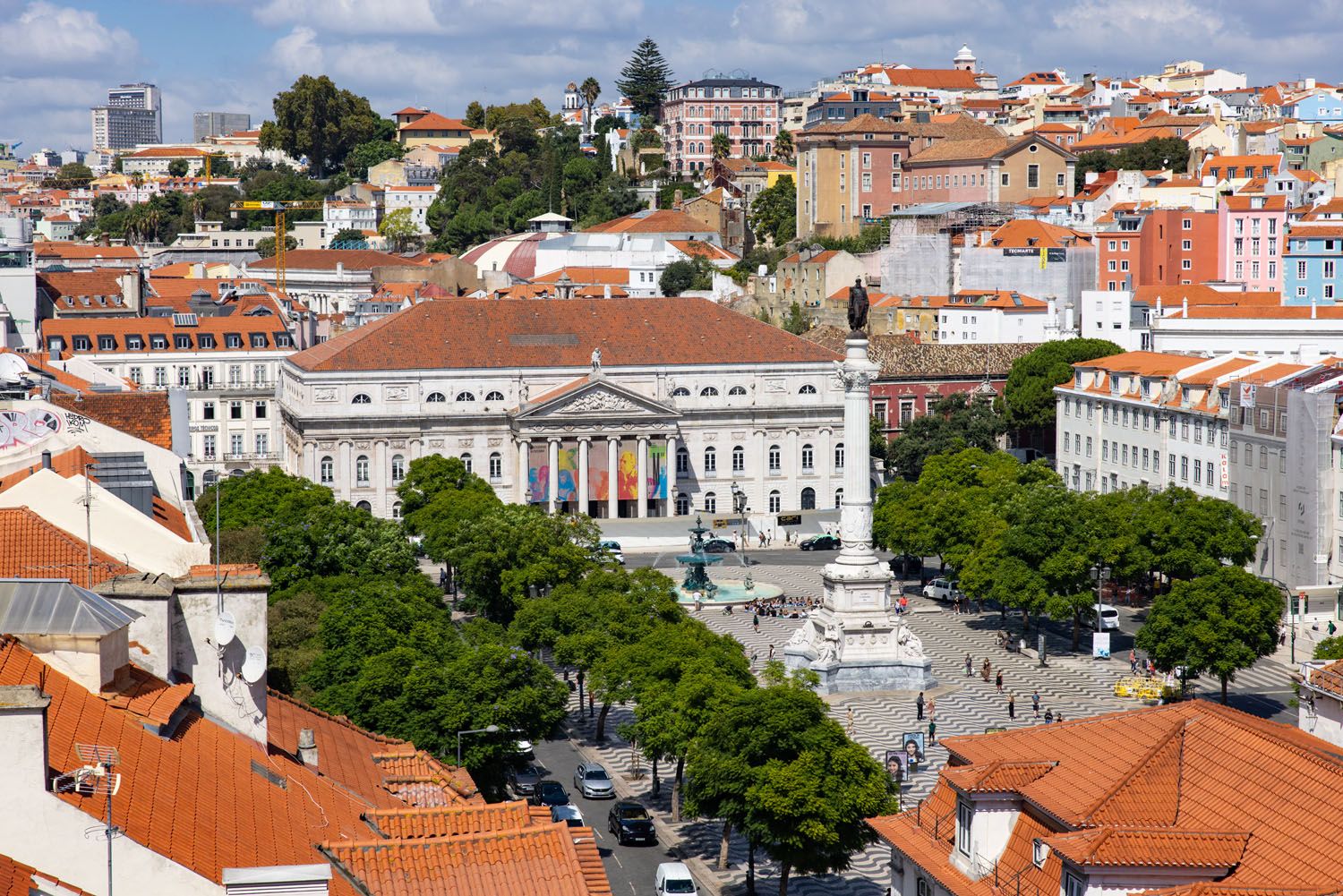
The elevator runs from 7 am to 10:45 pm. It’s a great way to get between the lower level of the city up to Carmo Square.
18. Carmo Convent
This historic building shows visitors the power of the 1755 earthquake.
The Convent of Our Lady of Mount Carmel was founded in 1389 and the church was constructed between 1389 and 1423. The church sustained heavy damage after the earthquake and much of it remains unrestored, making this one of the most unique churches to visit in Portugal.
The Gothic arches still stand but the roof was never rebuilt.
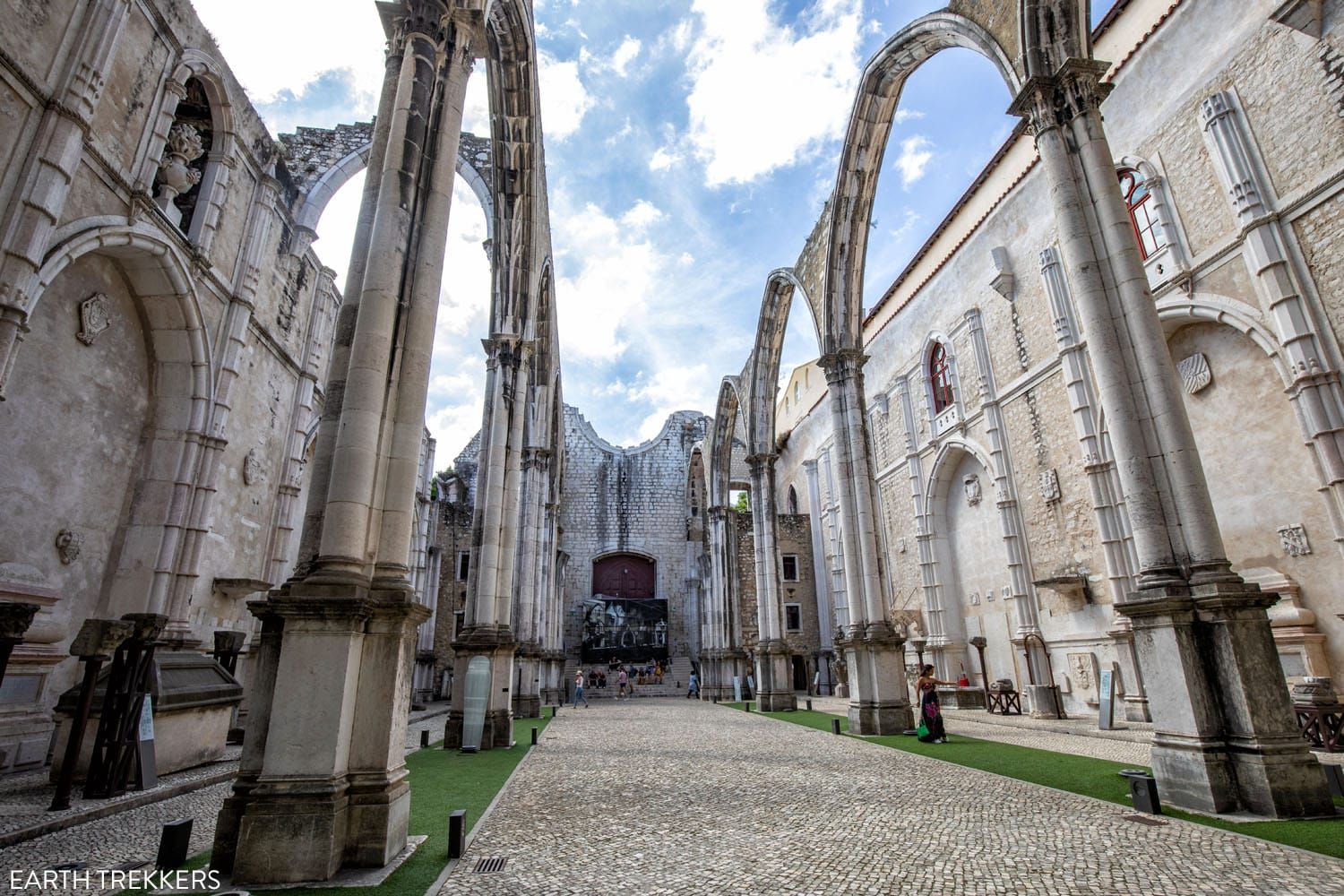
Carmo Convent
On a visit here, you will walk down the nave, with bright blue sky overhead.
In the archaeological museum, on display are mummies from Peru and a sarcophagus from Egypt, making this visit full of wonderful surprises.
Carmo Convent is open every day except Sunday. Get hours and pricing on the official website.
19. Miradouro do São Pedro de Alcântara
By now you know that Lisbon is full of viewpoints and this is another good one.
This terrace, which sits beside the Bairro Alto district, offers another lofty view of Lisbon. With live performers, benches that sit in the shade of trees, and its close proximity to some of the best restaurants in Lisbon, Miradouro do São Pedro de Alcântara is a popular spot to visit. This is a great place to go for sunset views of Lisbon.
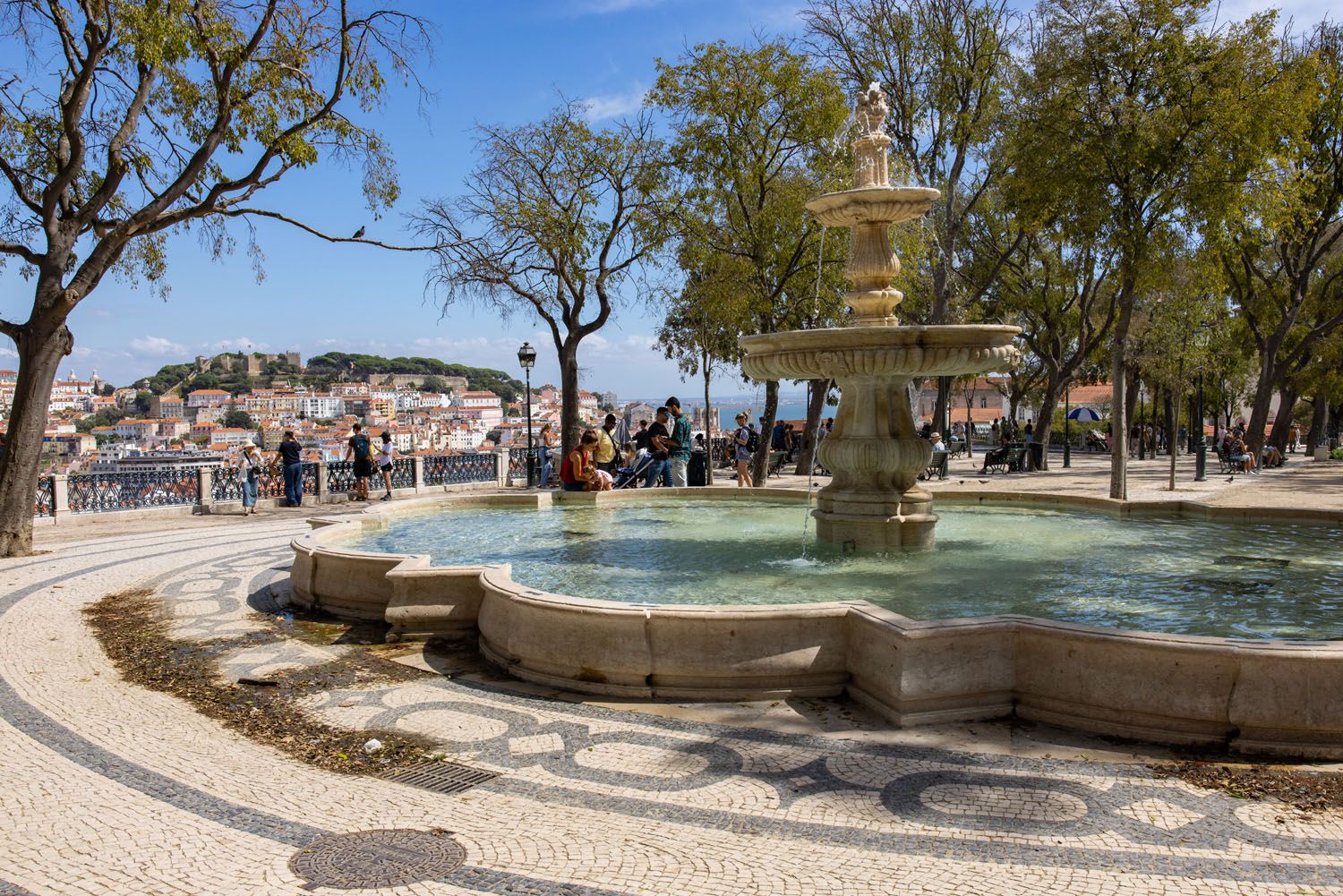
For lunch or dinner, we highly recommend Las Dos Manos, a fantastic restaurant that fuses Japanese and Mexican flavors. It is located across Rua de São Pedro de Alcântara from the viewpoint.
20. Bica Funicular
The Bica Funicular (Ascensor da Bica) is one of the most iconic funiculars in Lisbon and an extremely popular photography location.
The Bica Funicular runs from Rua de Sao Paulo up to Rua do Loreto. Two cars run at the same time, in opposite directions.
Many people ride the funicular to the top of the street and take photos with car at this point. A better photography location is at the intersection of Travessa da Laranjeira and Rua da Bica de Duarte Belo, which is located along the funicular route.
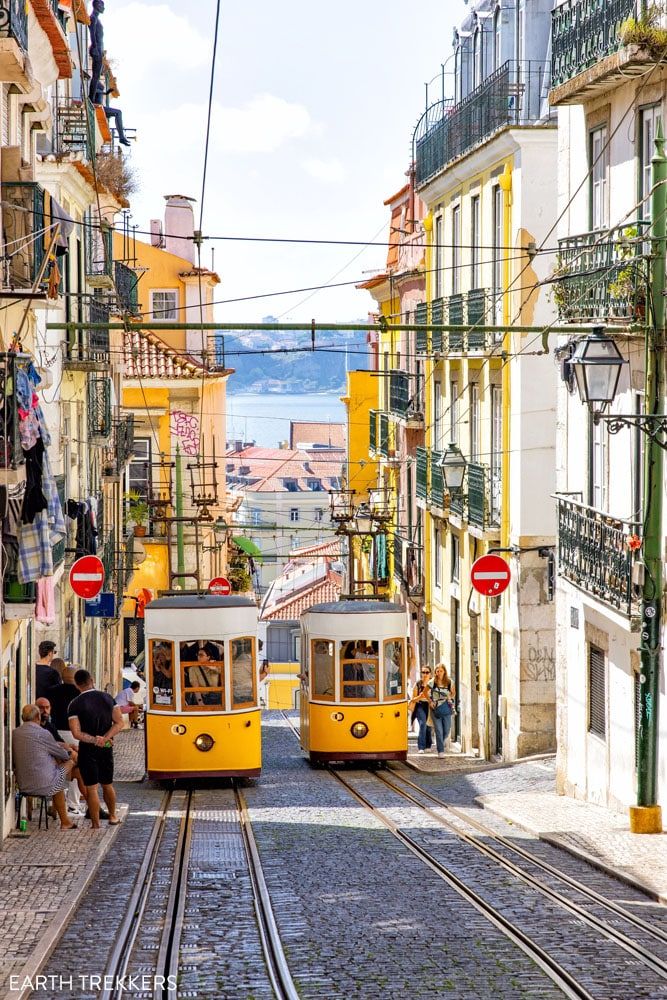
If you plan to ride the funicular, the line can be long. It could take you much longer to wait in line for a ticket and the ride on the funicular, than to walk up or down the street (it takes about 5 to 7 minutes to walk the funicular route).
21. Pink Street
If there is an Instagram hot spot in Lisbon, then this is it!
Pink Street is famous for its painted pink street that is covered with rainbow-colored umbrellas. This is a very popular spot to take a photo but if you get here early in the day, crowds aren’t too bad.
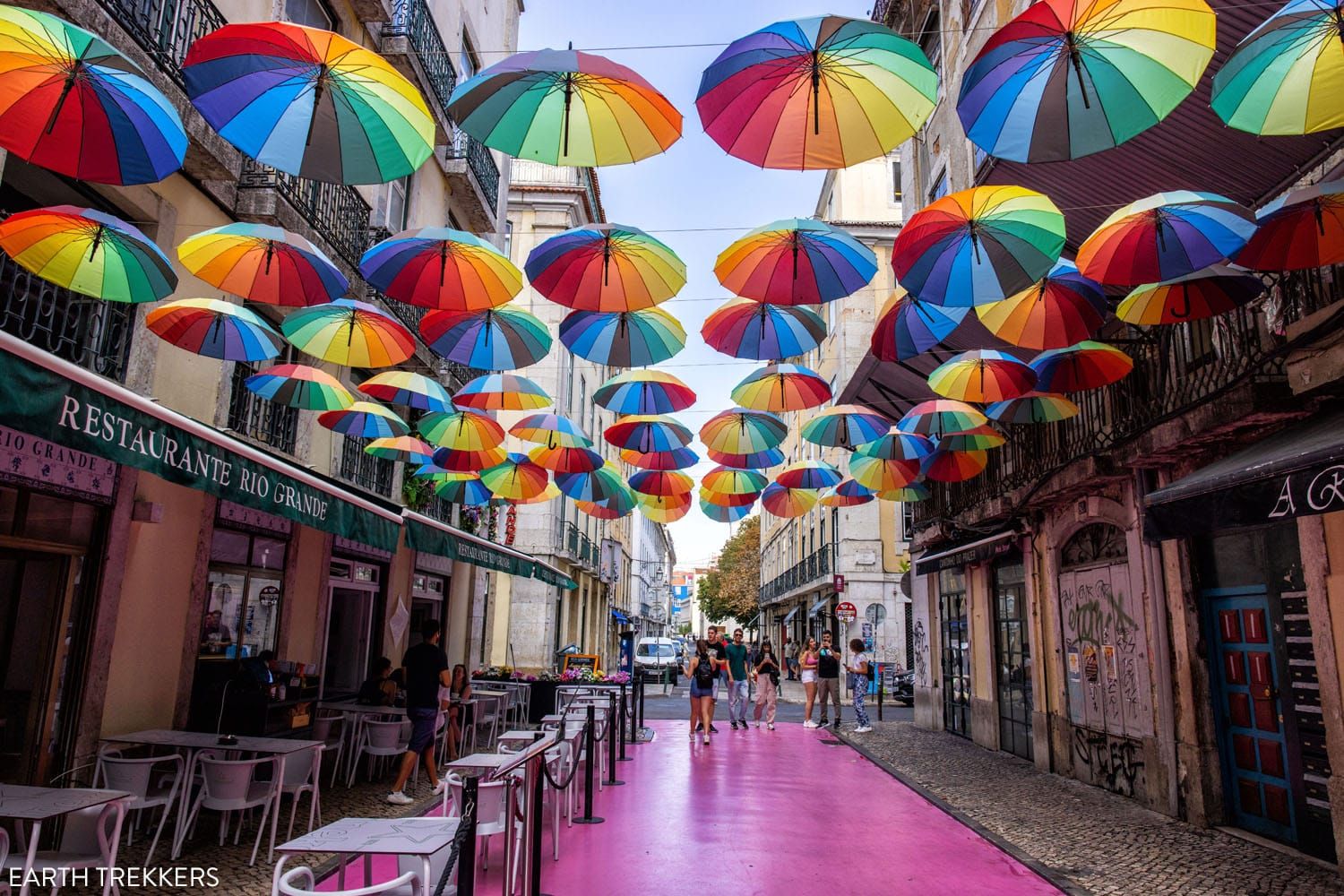
Pink Street | Best Things to Do in Lisbon
22. Time Out Market
One of our favorite things about Portugal is the food. Time Out Market is Portuguese food paradise.
This covered market is lined with small shops selling a wide variety of foods, from traditional Portuguese dishes to gourmet hot dogs and burgers to cakes, cookies, and donuts. You can also taste port, have a cocktail at the Time Out Bar, and try Super Bock beer. There are even a few shops selling ceramics, home goods, and souvenirs.
With so many small restaurants to try, there is something here for everyone.
For us, Time Out Market was a highlight of our time in Lisbon. Tim and I ordered lunch from Marlene Vieira, which specializes in traditional Portuguese cuisine. We had the polvo a lagareiro (octopus with potatoes and spinach), the bacalhau (codfish), and mussels with tomato sauce. It was all fantastic. If we didn’t have so many other restaurants to try in Lisbon, we would have dined here again.
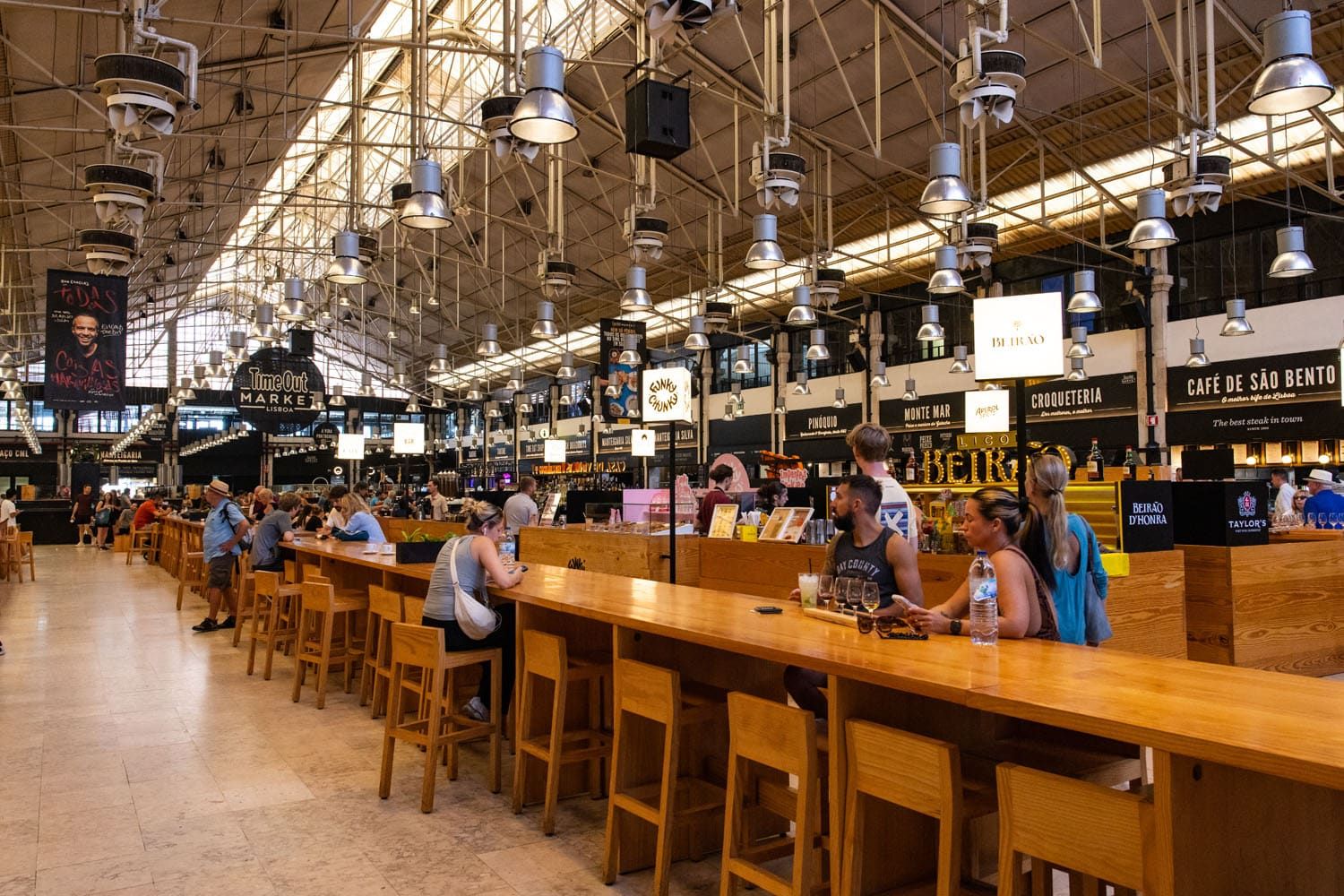

You will see a few negative reviews for Time Out Market, but these are mostly about the crowds. This does get to be a very crowded spot. Tim and I got here at 12:30 pm, and from our photos you can see that crowds were rather light. However, it didn’t take long for this place to fill up and at 1:30 pm, almost every seat was taken and lines at the restaurants were long.
Get hours on the official website and plan your visit before noon if you want to be here before the crowds arrive.
23. Calouste Gulbenkian Museum
This museum contains one of the best private art collections in the world. Starting at age 14, Calouste Gulbenkian began collecting ancient Greek coins and then art and artifacts from Egypt, Mesopotamia, Armenia, Turkey, Syria, Greece, China, and Japan. There are also more recent European works of art.
For art lovers, this museum is not to be missed. Purchase your tickets online in advance on the official website to save yourself a wait in line.

24. Vasco da Gama Tower
Named for Vasco da Gama, who discovered the ocean route between Europe and India, this is the tallest skyscraper in Lisbon. It is located in eastern Lisbon, near the Oceanário de Lisboa, the next entry on our list.
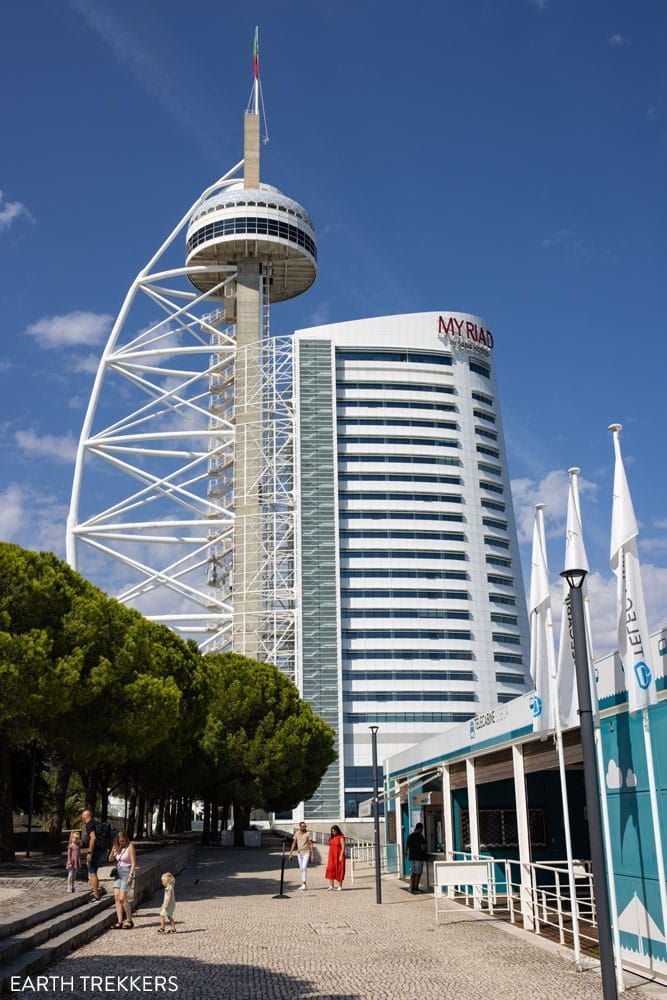
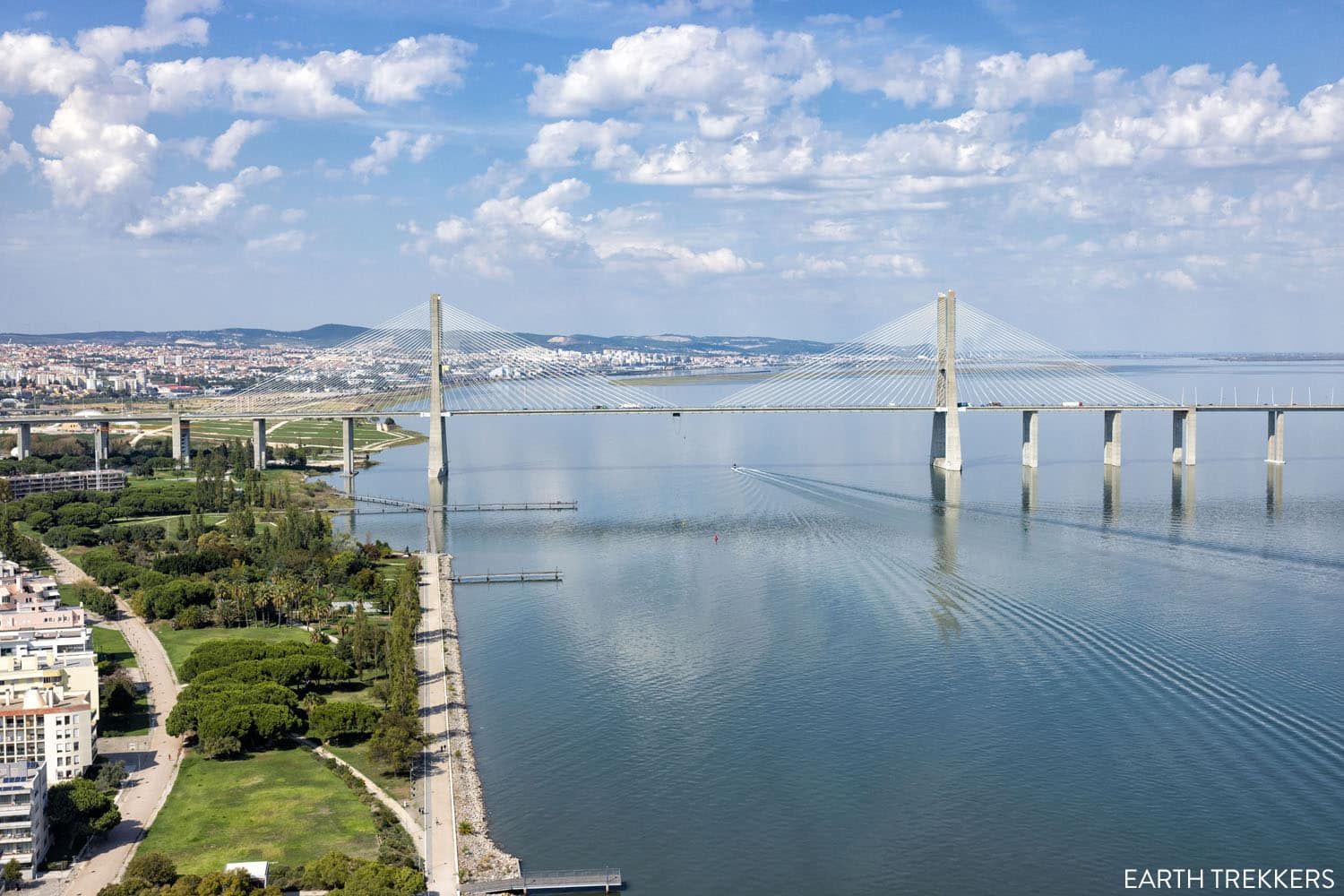
The view of the Vasco da Gama Bridge from Vasco de Gama Tower
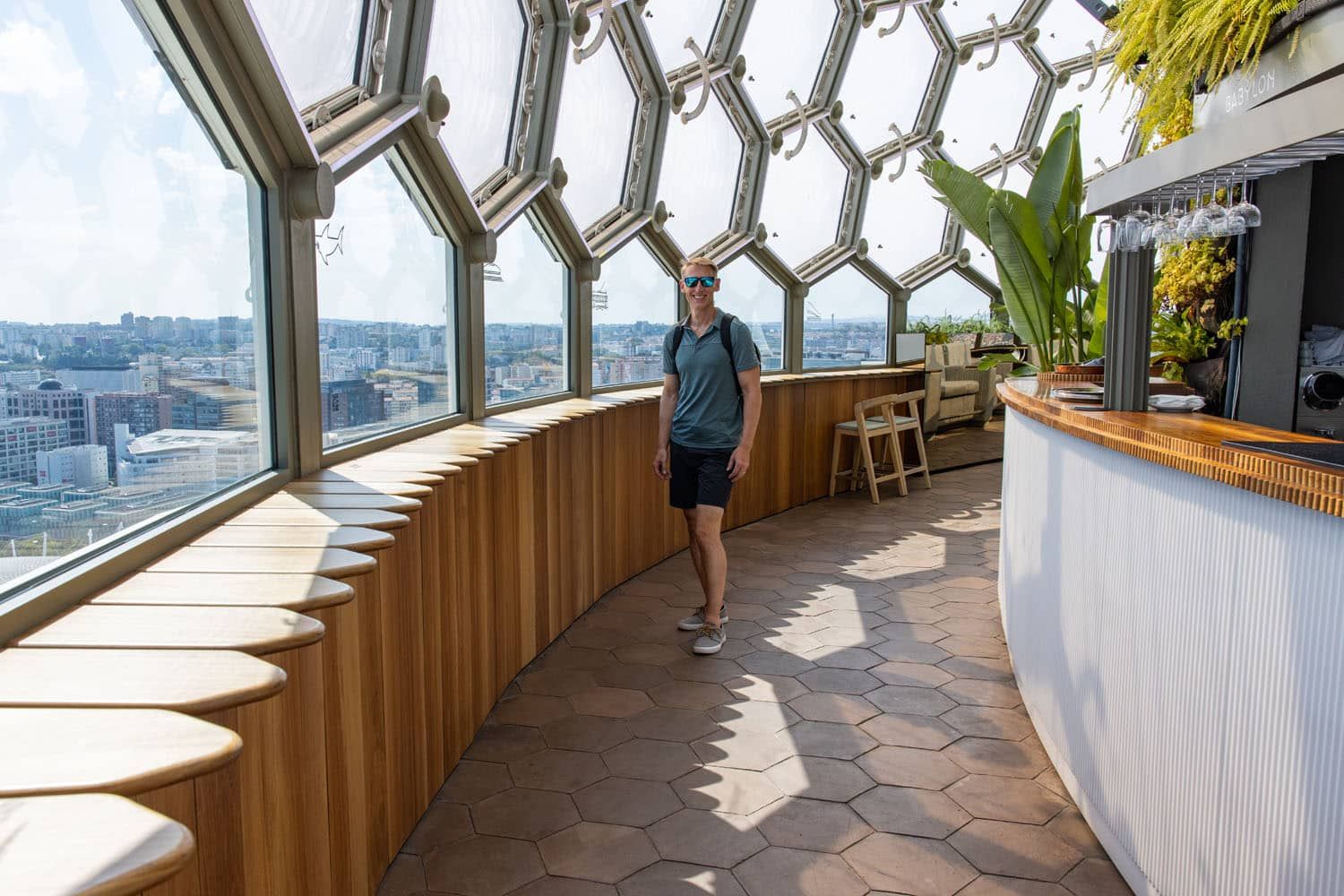
Ride the elevator to the top of the tower for 360° views of Lisbon. Babylon 360° is a rooftop bar on top of the tower, with live music and DJ’s. From here, you get a bird’s eye view of the Vasco da Gama bridge, the second longest bridge in Europe.
Get hours and pricing on the official website.
PRO TRAVEL TIP: The Myriad by SANA is a 5-star hotel that sits next to the Vasco da Gama Tower. They have a bar and restaurant on the ground floor (the Myriad River Lounge) with indoor and outdoor seating. This is another nice place to get a cocktail, before or after you visit the Vasco da Gama Tower.
25. Oceanário de Lisboa
With Portugal’s long coastline and prime seaside location, it may come as no surprise that Lisbon has a world class aquarium. Oceanário de Lisboa is one of the largest aquariums in Europe, with more than 15,000 marine creatures.
This aquarium offers many unique experiences, such as an 8-day diving program in the Azores and the opportunity to sleep with sharks (basically a slumber party in the aquarium).
Get hours, pricing, and learn more about their conservation projects on the official website.
26. Telecabine Lisboa
This gondola connects the aquarium with the Vasco da Gama Tower, soaring above Nations Park. It costs a few euros to ride the gondola and saves you about 2 km of walking (25-minutes one-way).
Get hours and pricing on the official website.
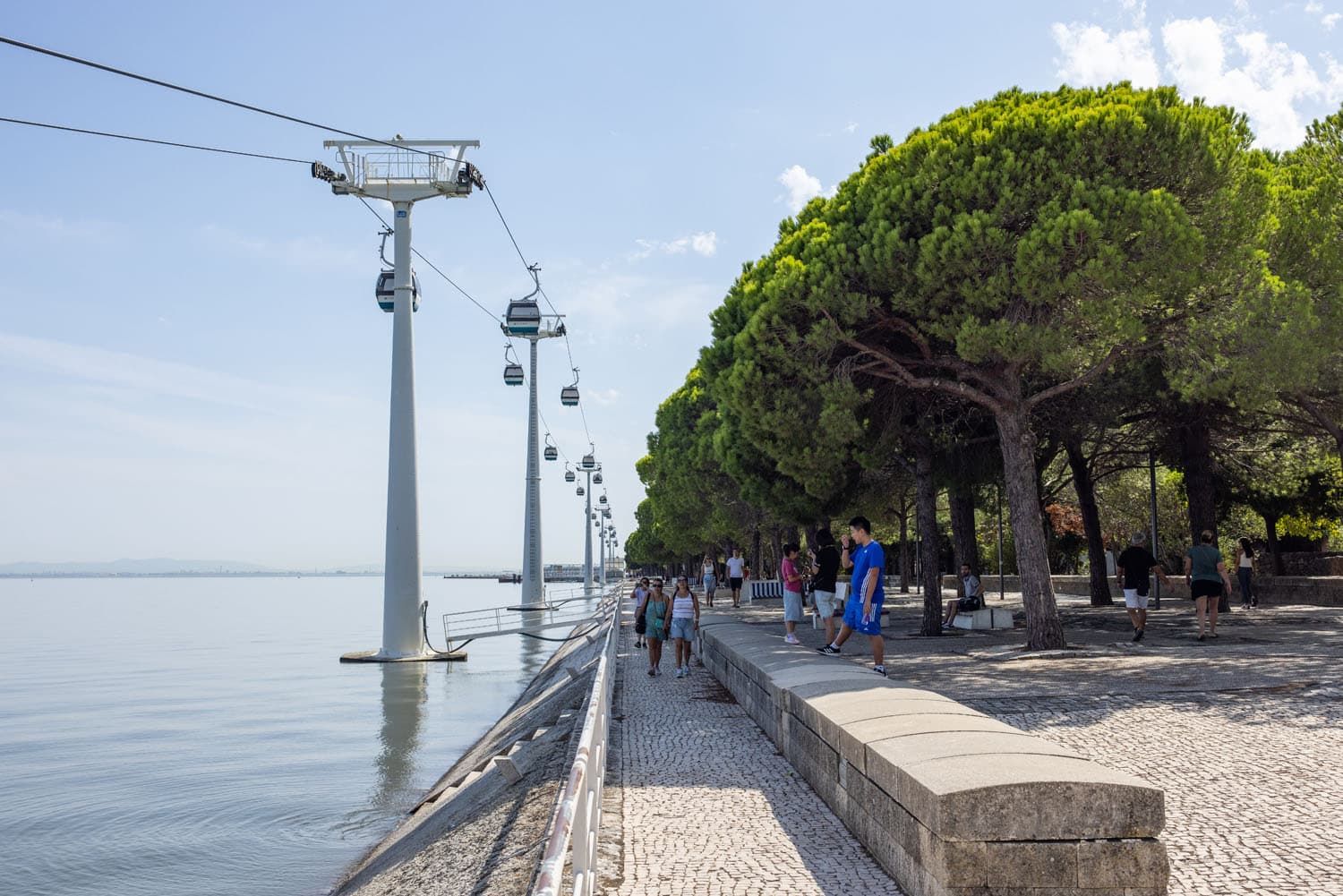
The gondola and Nations Park
PRO TRAVEL TIP: The Vasco da Gama Tower, Oceanarium, and gondola are located in eastern Lisbon. It’s too far to walk to from the city center, so the best way to get out this way is on the red metro line or by Uber or Bolt.
27. Sanctuary of Christ the King
Inspired by Christ the Redeemer in Rio de Janeiro, Brazil, this Catholic monument and shrine is dedicated to the Sacred Heart of Jesus Christ. It sits in Almada, on the opposite side of the Tagus River and overlooks the city of Lisbon.
Visitors can ride the elevator to the observation deck, which sits at the base of the Christ the King statue. This platform offers a fantastic view of Lisbon. In the base of the monument is the Chapel of Our Lady of Peace.

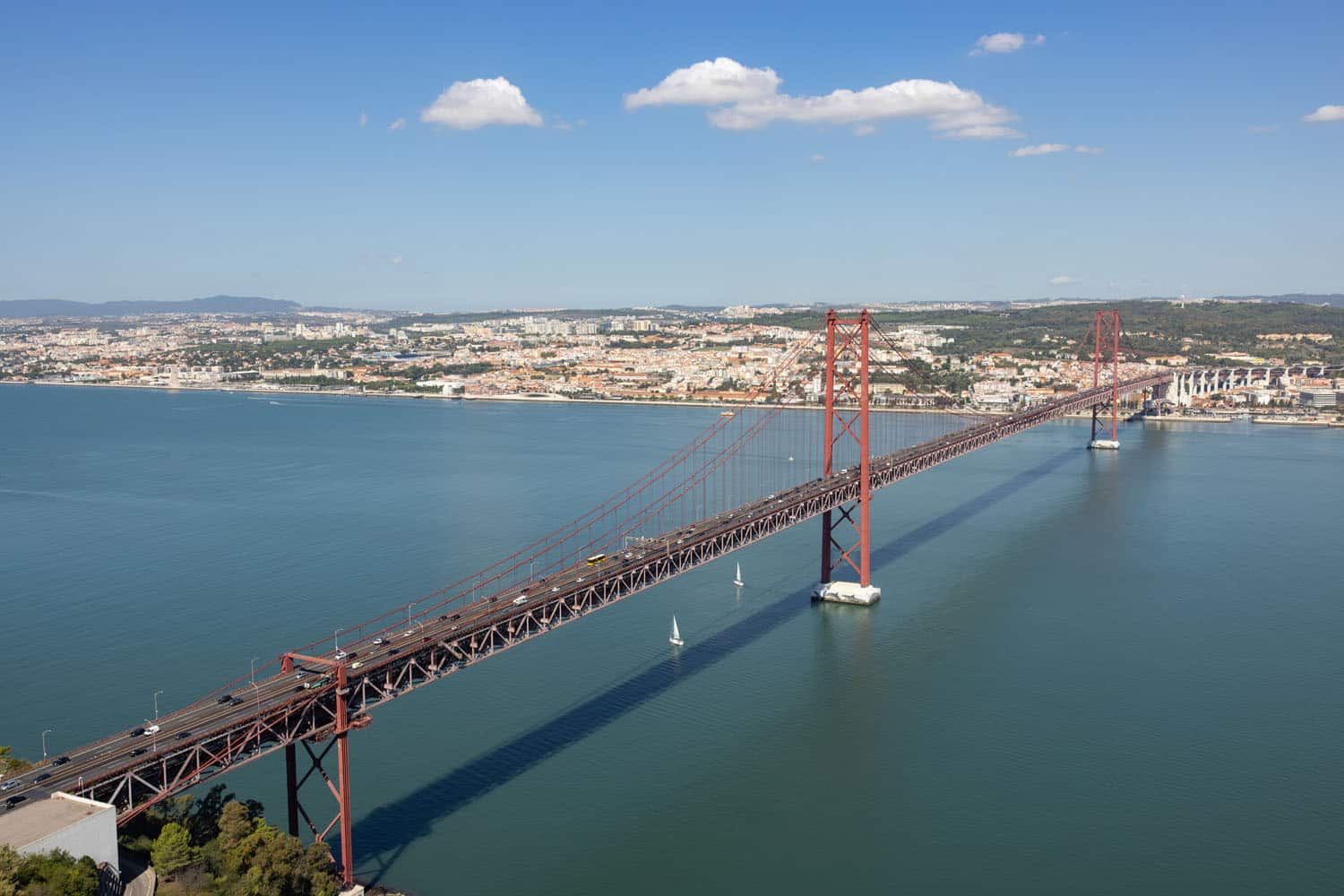
The view from Christ the King
When we did this, we waited about 30 minutes to purchase tickets and then board the elevator. The elevator is slow and can hold a limited number of people, which is what causes the delay. If you get here and find that the line is long, you don’t miss out on much by skipping the ride up the observation deck. The views from terrace in front of the Christ the King statue are just as good as from the observation platform.
To get here, take the ferry from Cais do Sodre to Cacilhas (the town next to the Sanctuary of Christ the King) and then take bus 3001 to Cristo Rei. You can also get here by Uber, Bolt, or another ride share app.
Get hours and pricing on the official website.
28. Jerónimos Monastery
Jerónimos Monastery (Mosteiro dos Jerónimos), is an architectural masterpiece and one of the most beautiful buildings in Lisbon.
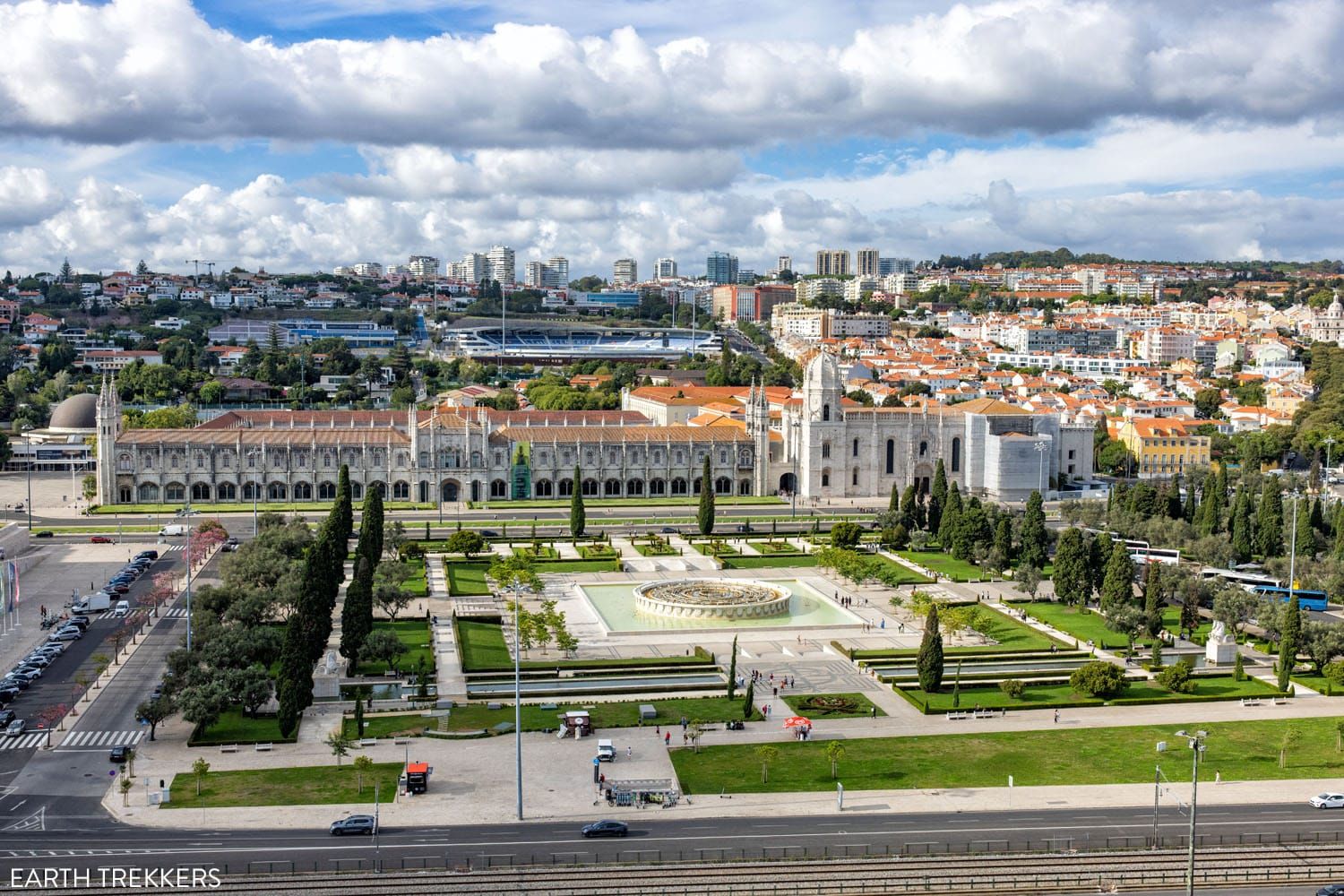
Jerónimos Monastery (photo taken from the Monument of Discoveries)
Commissioned by King Manual I in 1501 to celebrate Vasco da Gama’s successful voyage to India, the monastery exemplifies the Manueline architectural style (a richly ornate and intricate architectural style). It was completed in 1601.
The exterior is a stunning display of intricate carvings, with sea monsters, ropes, knots, and exotic flora. The highlight of the visit is seeing the cloister, with more delicate stone carvings depicting biblical scenes and maritime motifs.
Jerónimos Monastery is a UNESCO World Heritage Site and one of the 7 Wonders of Portugal.
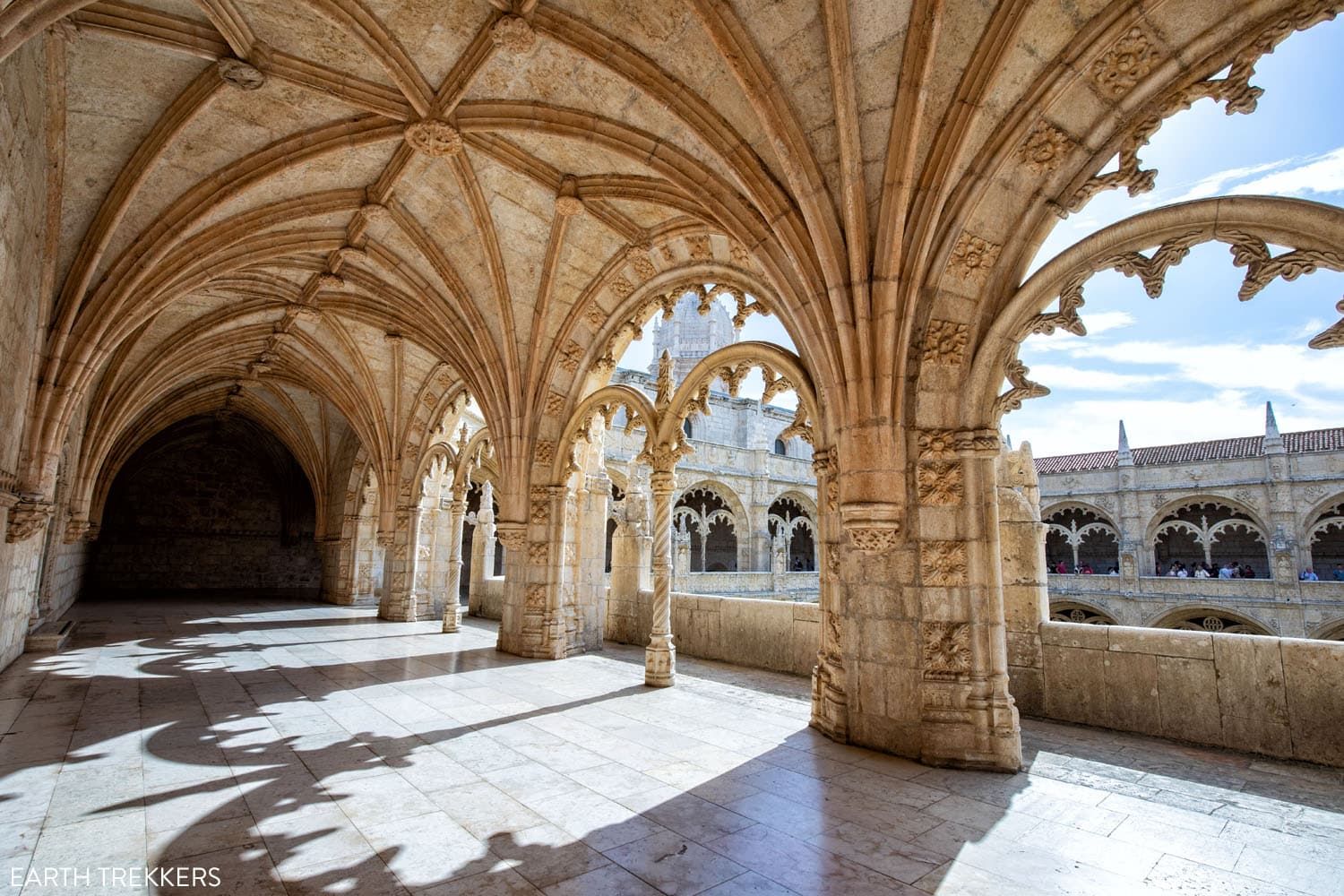
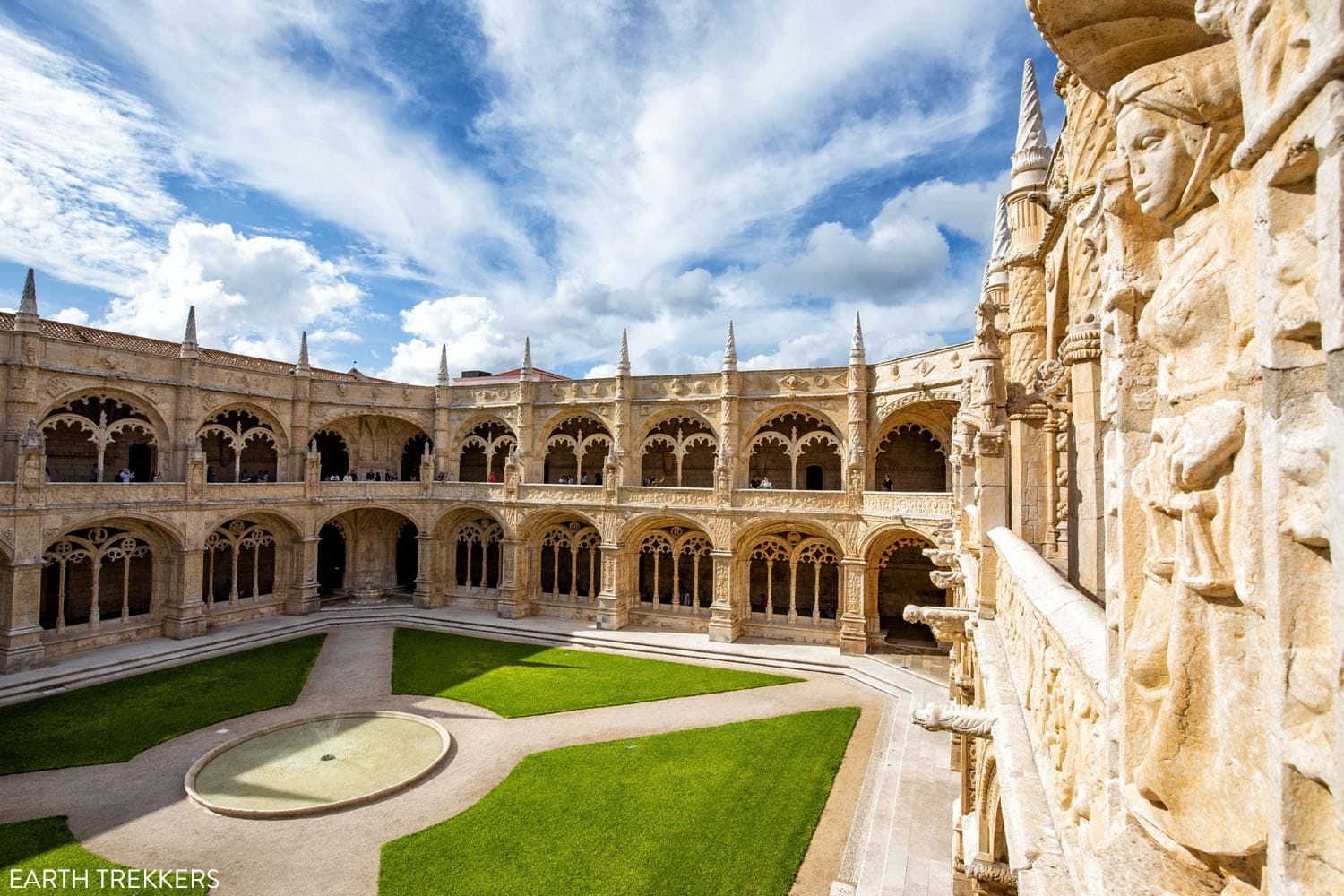
This is not to be missed on a visit to Lisbon. Not only is this one of the most important buildings in Portugal, but seeing the cloister is an unforgettable experience.
With that being said, Jerónimos Monastery is one of the most visited landmarks in Lisbon. The line to enter can get massively long.
How to Visit Jerónimos Monastery
Line to Enter: There are two different lines at the entrance to Jerónimos Monastery. The line to the left is to enter the monastery and the line to the right is to enter Santa Maria de Belém Church. There are signs indicating these lines so confirm that you are getting in the correct one.
Tickets: You can purchase an entrance ticket in advance through GetYourGuide. If you have the Lisbon Card, this serves as your ticket into the monastery. Or, purchase your tickets at the ticket stand across the street from the monastery
About Our Experiences: We visited Jerónimos Monastery twice. The first time was at 4 pm in mid-September. The line looked long but it only took us 10 minutes to enter the monastery. When we exited the monastery (around 4:30 pm) the line was gone. Our second visit was at opening time in July. We got in line at 9:15 am and a good-sized line had already formed. It took us about 25 minutes to get into the monastery. If you plan to visit at opening time, I recommend getting in line about 9 am, which is 30 minutes before opening, because that 10 minutes can really make a difference in how long you wait in line.
Hours: The monastery is open from 9:30 am to 6:00 pm 7 days a week. Confirm hours before you go on the official website or Google.
29. Church of Santa Maria de Belém
This church is part of the Jerónimos Monastery. On its exterior is the South Portal, an ornate, intricately carved façade with scenes of the life of Saint Jerome, the Madonna (Santa Maria de Belém), archangel Michael, and a cross of the Order of Christ.
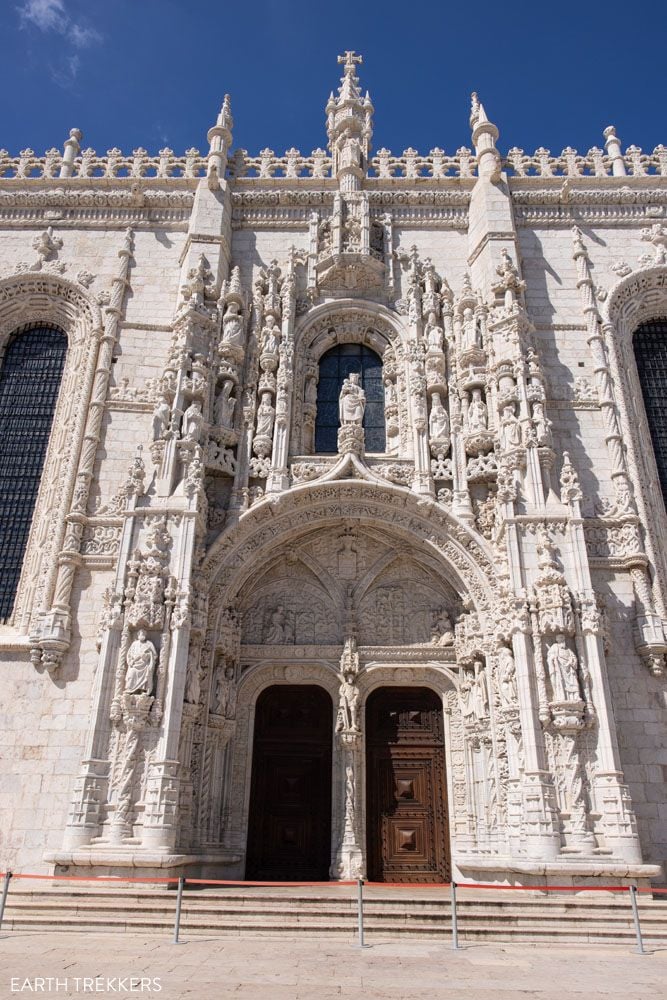
The South Portal
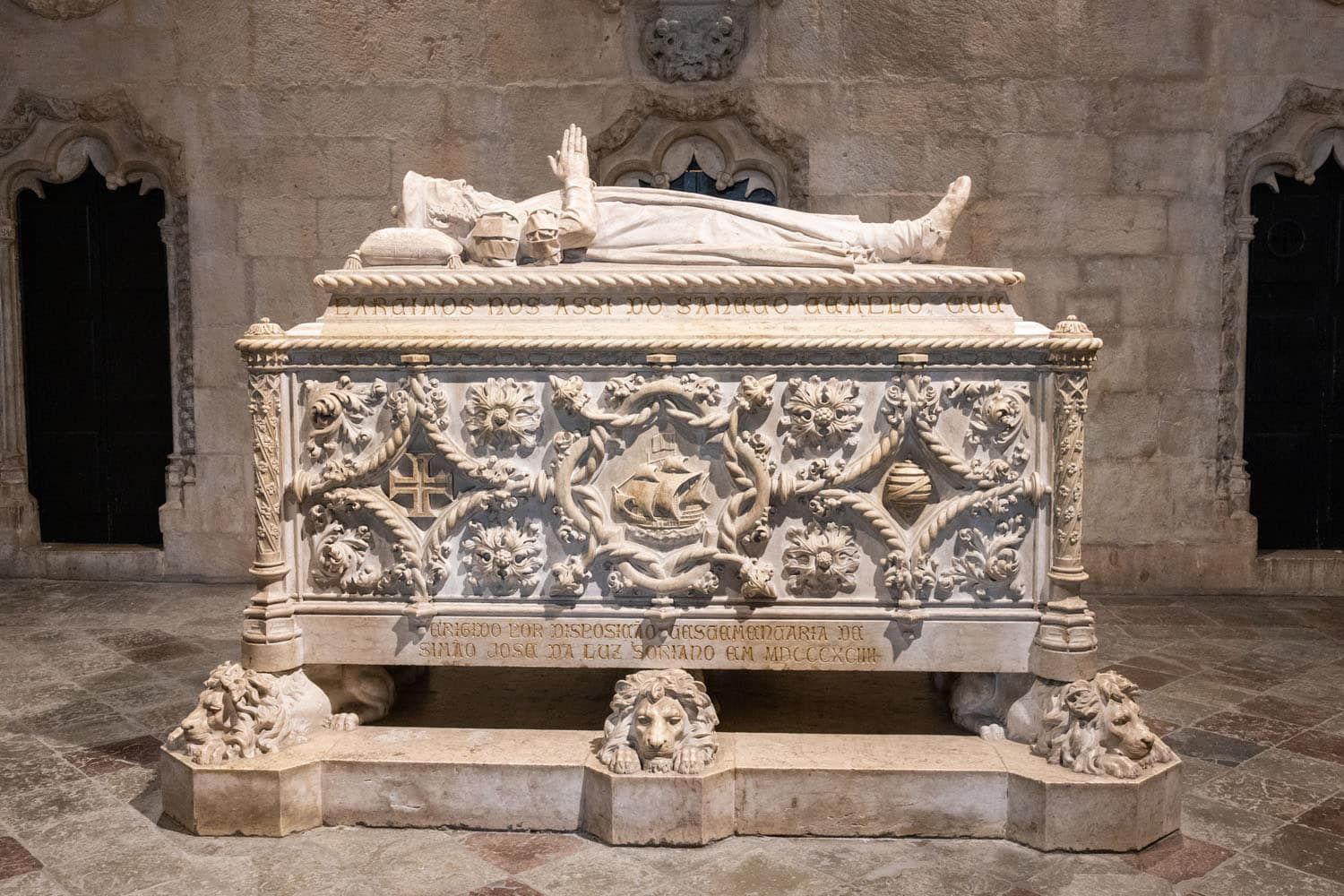
The tomb of Vasco da Gama
Inside of the church, the most notable thing to see is the tomb of Vasco da Gama and the tomb of Luis de Camões, the great poet of the Age of Discoveries.
The church is free to enter. The line to enter is to the right of the monastery line and it is generally shorter than the line into the monastery.
30. Belém Tower
This UNESCO World Heritage Site is the symbol of Europe’s Age of Discovery.
The term Age of Discovery refers the period during the 15th to 17th centuries when seafarers from Europe explored and conquered regions around the globe. The main events were Christopher Columbus sailing to America and Magellan circumnavigating the globe, but Vasco da Gama’s voyage around the Cape of Good Hope unveiled an important route to India.
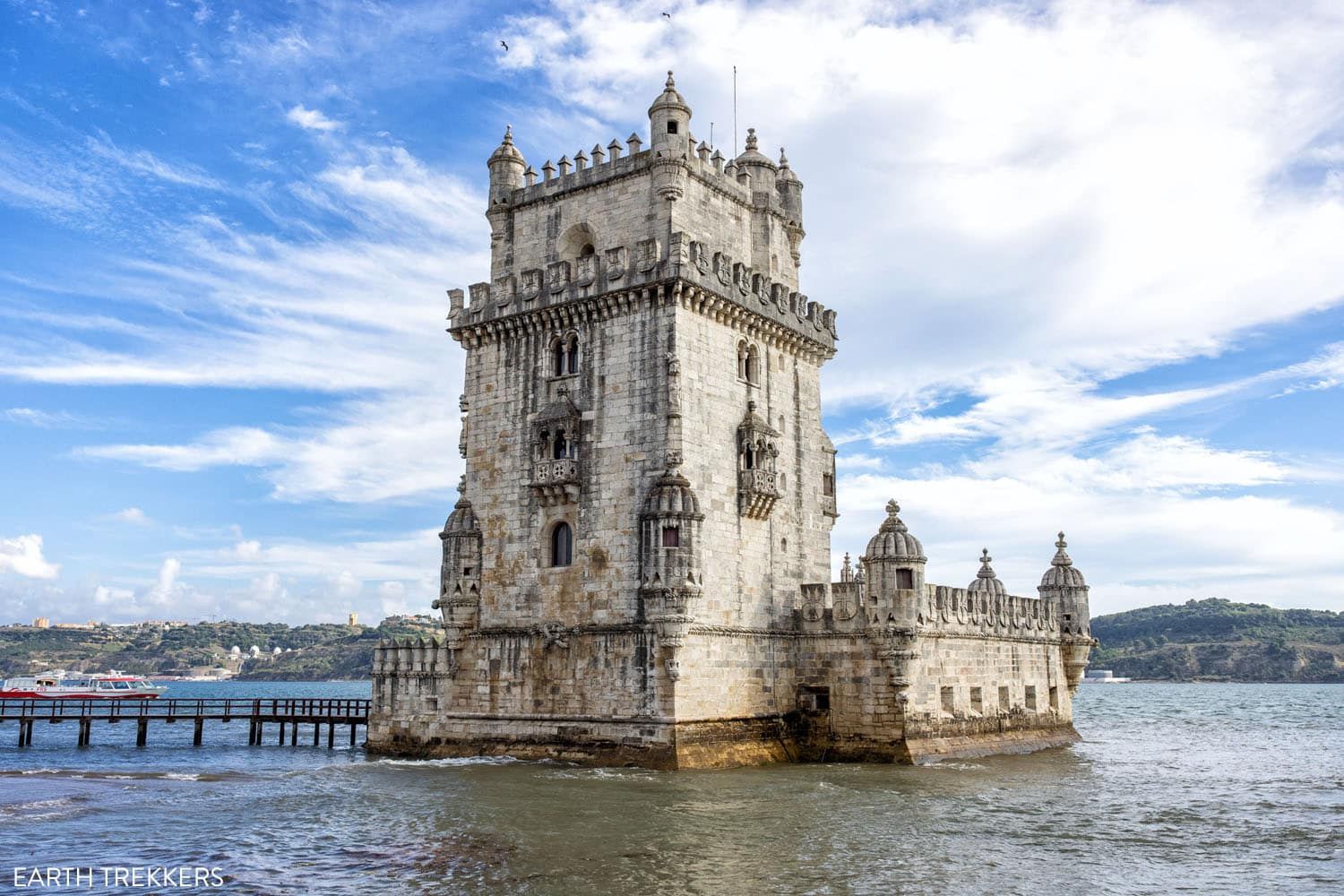
Belém Tower | Best Things to Do in Lisbon
Belém Tower took several years to build and was completed in 1516. It is part bastion and part tower.
If you are interested, you can enter the tower. It is best to purchase your ticket in advance or wait in the line that forms in front of the tower. For the shortest wait in line, get here at opening time (9:30 am). If you wait too late in the day, the queue closes so you may be denied entry.
31. Monument to the Discoveries
The Monument to the Discoveries (Padrão dos Descobrimentos in Portuguese) celebrates the Portuguese Age of Discovery. It is located on the Tagus River where ships departed to explore India and Asia.
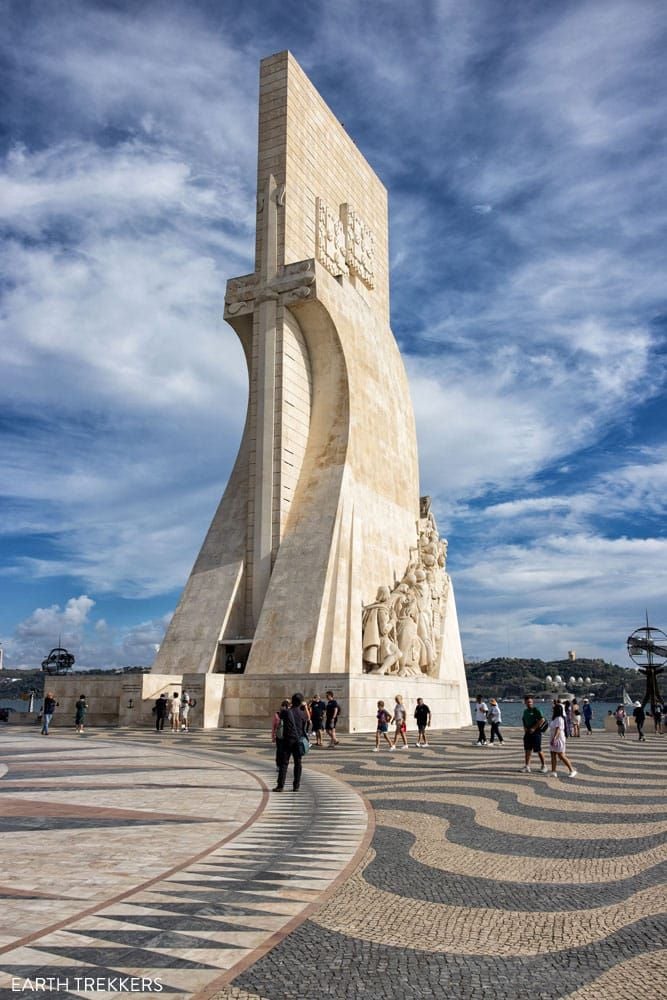
Monument of Discoveries
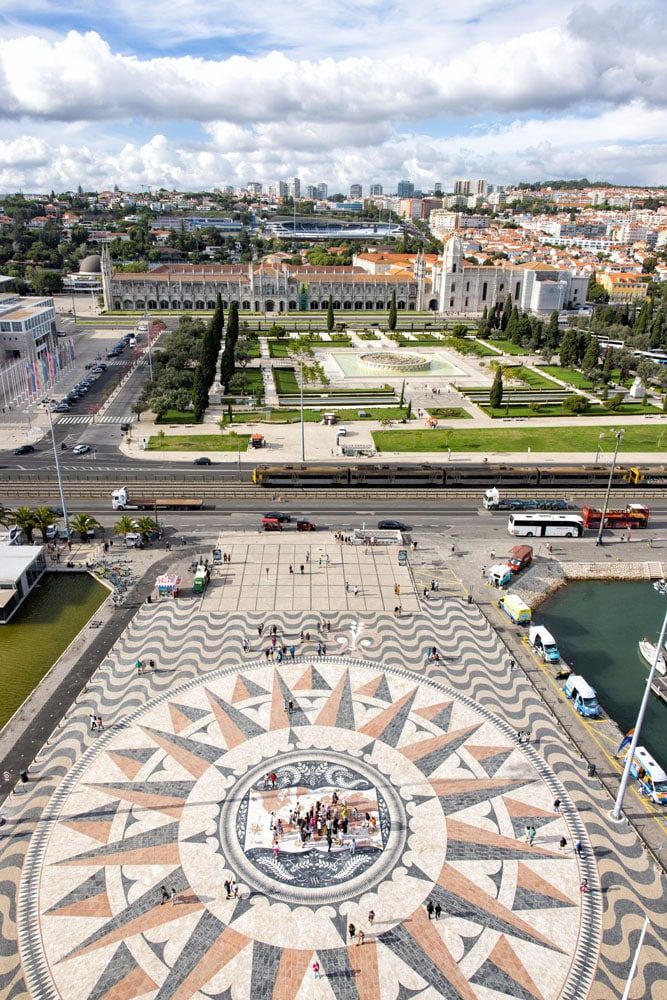
The view from the Monument of Discoveries
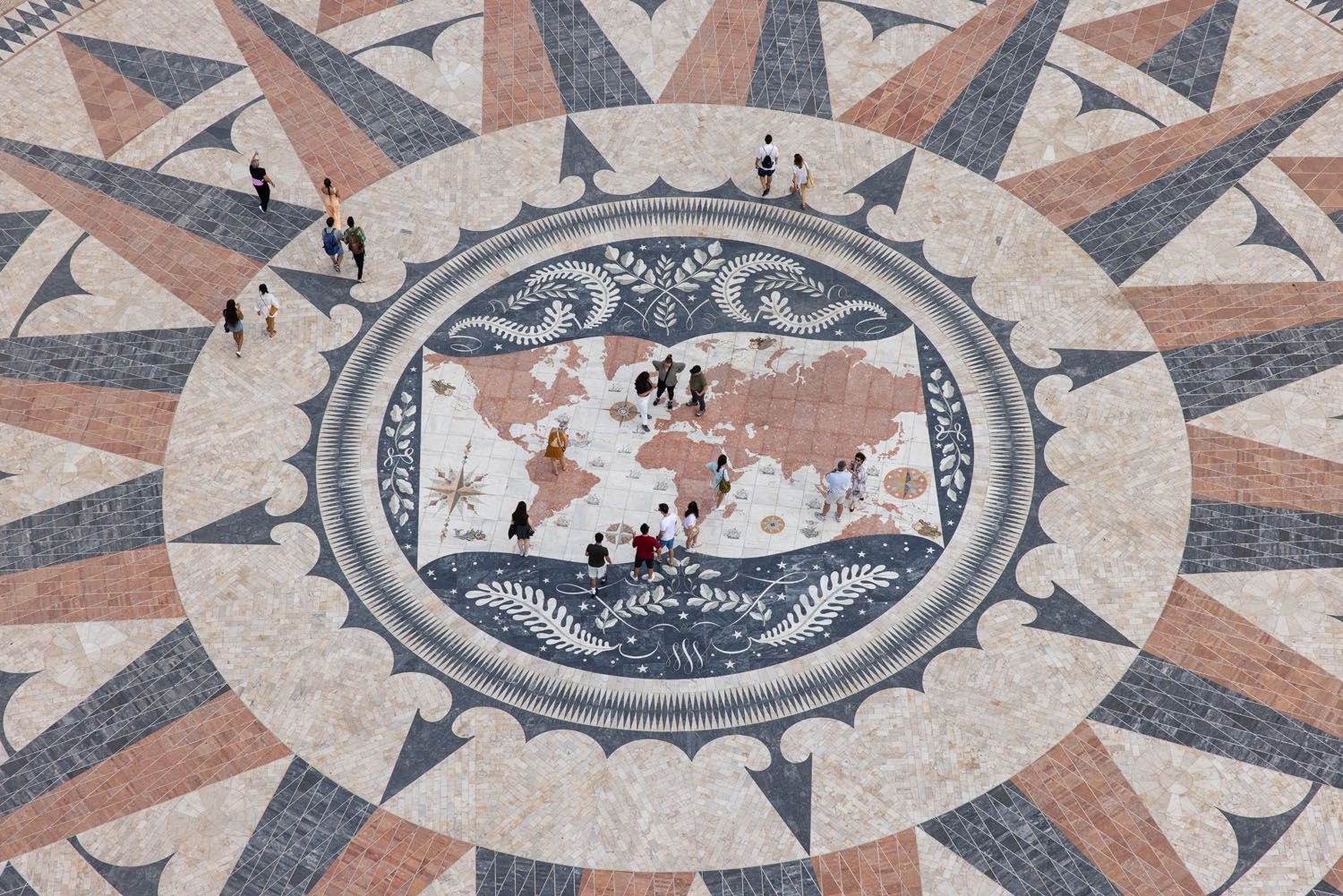
Another view from the top of the monument
The monument was temporarily built in 1940 and then demolished. It was reconstructed in 1960 as a permanent monument. Statues line the base of the monument, with Henry the Navigator being the main statue. The smaller statues are of other seafarers and explorers, including Vasco da Gama, Afonso V of Portugal, and Queen Philippa of Lancaster.
For one of the best views in Lisbon, visit the outdoor terrace on top of the Monument of Discoveries. To get here, you can either walk all 267 steps to the top or ride the elevator and walk the final 42 steps to the top. The view of Jerónimos Monastery, Belém Tower, and the Tagus River is spectacular from this vantage point.
Get hours and pricing on the official website.
32. Maritime Museum
Located next to Jerónimos Monastery, this museum has artifacts and exhibits about the early days of Portuguese exploration. On display are models of ships, life-sized sailing vessels, and navigational aids. We loved seeing the World Map at the entrance to the museum and the beautiful maps inside the museum.
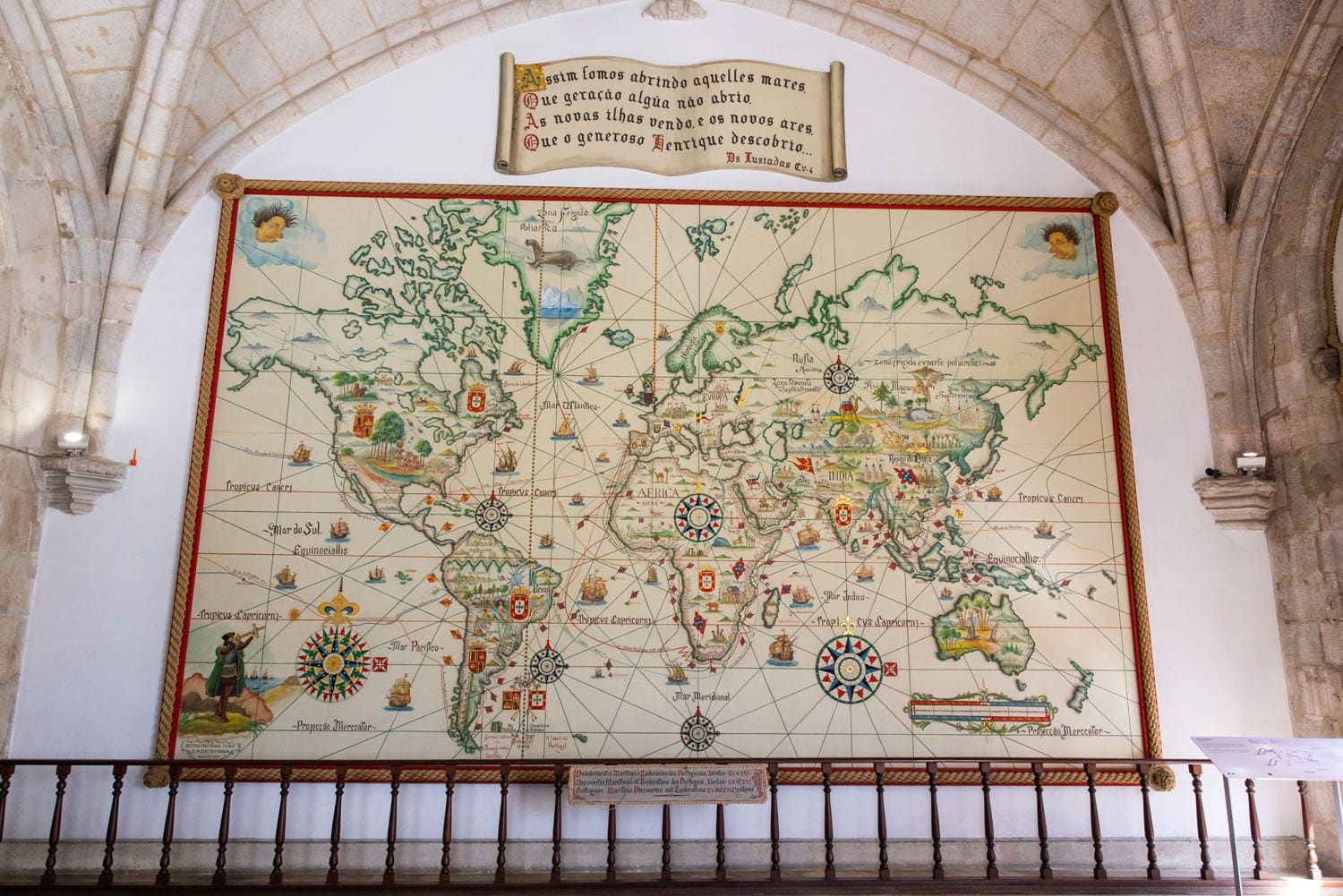
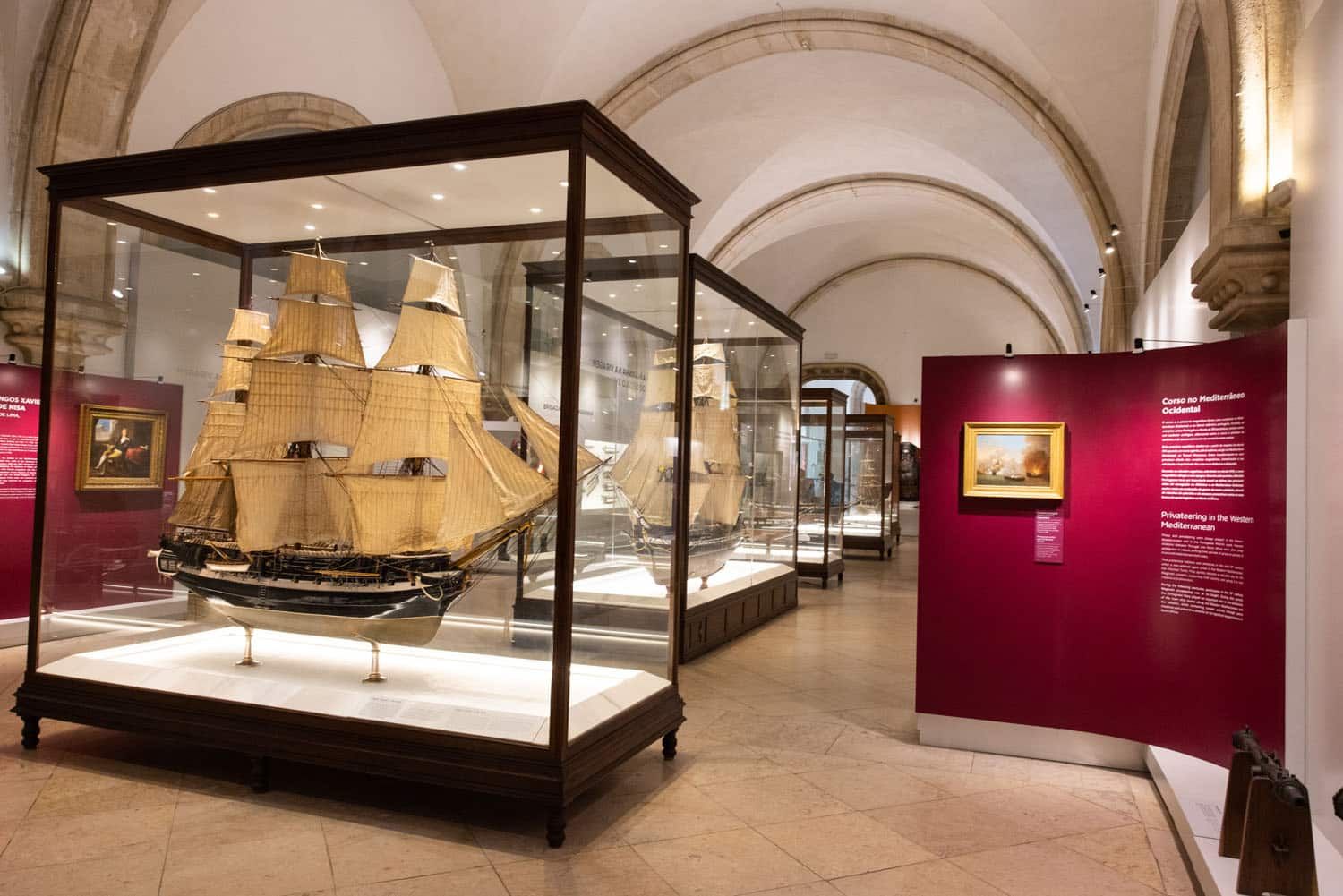
PRO TRAVEL TIP: There are several other museums in the Santa Maria de Belém area of Lisbon. They are only worthwhile if you have a lot of time in Lisbon (5 or more days) and have an interest in art and museums.
Museu Colecao Berardo is a modern art museum that contains a few Picassos. Our favorite room was the Andy Warhol room. This museum is located across the street from the Maritime Museum.
Farther east is the National Museum of Coaches and Quake, a museum about the 1755 earthquake (you have to book a timed session and each session lasts 1 hour and 40 minutes; this is an interactive museum where you get to experience what an earthquake feels like). These are located a short walk from MAAT.
33. MAAT
The Museum of Art, Architecture, and Technology (MAAT) is famous for its distinctive architecture. Walking on the roof of the MAAT for views of the Tagus River is a highlight of a visit here. The exhibits on the inside of the museum get mixed reviews.
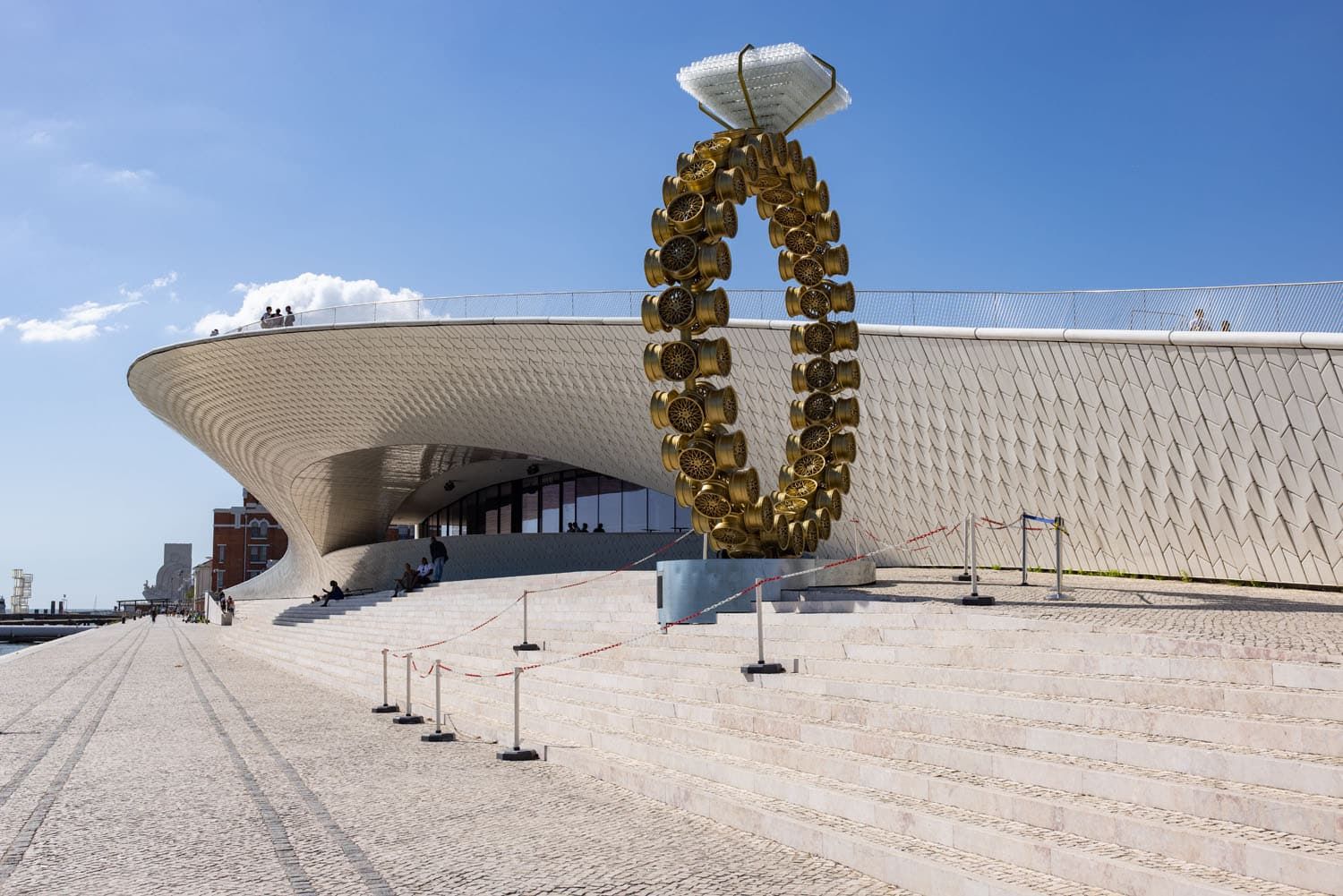
MAAT
34. Pastéis de Belém
One of Portugal’s most famous foods is the Pastel de Nata.
This Portuguese egg custard pastry was first made in the 18th century by Catholic monks in Jerónimos Monastery. At that time, egg whites were used to clean and starch clothing. The monks had to find something to do with the leftover yolks, and the egg custard tart was a perfectly sweet solution.
When the monastery was closed in 1834, the recipe was sold to a sugar refinery, who then opened Fábrica de Pastéis de Belém. This pastry café continues to make Pastel de Nata, with the original recipe from Jerónimos Monastery.
The shop now sells over 20,000 pastries per day. It is located just a 5-minute walk from Jerónimos Monastery.
Expect a long line here. The longest line is the takeaway line, and when we were here in the afternoon, at least 50 people were in line. There is a second line for preorders, which was very short and moved very fast. We went inside, placed a takeaway order at the counter, and were in and out in under 5 minutes.
This is a great spot to have breakfast before visiting Jerónimos Monastery. On our most recent visit to Lisbon, we had breakfast here at 9 am (in July, a busy month to visit Portugal), and the place was empty.

35. LX Factory
This trendy spot is a revitalized textile industrial complex in Lisbon. This collection of warehouses has been renovated and converted into space for more than 50 shops, restaurants, and bars.
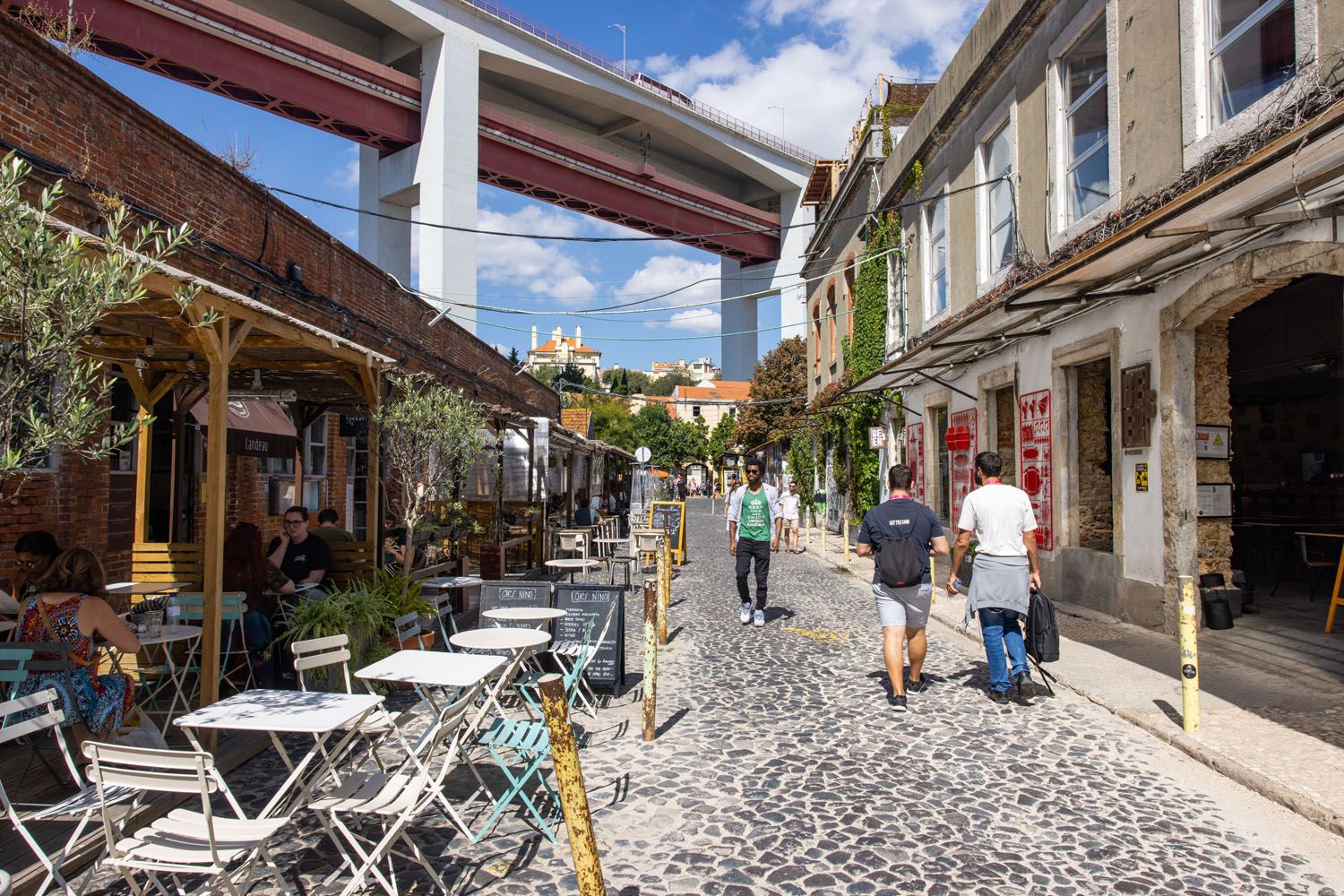
Like Time Out Market, it’s a great place to go to sample new foods. You can also hop from bar to bar, go ax throwing at the USAxe Club, do a little shopping, and photograph the street art that adorns the buildings. We ate lunch at Ni Michi Cocina Latina which was very good. Be sure to check the reviews on Google for the restaurants because some of them get mediocre reviews.
The LX Market is a cool spot to spend an afternoon or evening, since it has a great collection of bars and restaurants in one spot. However, we liked the overall experience and food options more at Time Out Market.
36. See a Fado Show
Fado is folk music that originated in the mid-1800’s. In the evenings, some restaurants and fado houses offer fado shows, where you can listen to the historic folk music over dinner. This folk music is so culturally important that it has made the UNESCO World Heritage list of Intangible Cultural Heritage of Humanity.
Popular places to see a fado show in Lisbon include Fado in Chiado, Clube de Fado, Sr. Fado de Alfama, Tasca do Jaime, and Adega Machado.
37. Basilica of Estrela
This basilica, which also goes by the longer name Royal Basilica and Convent of the Most Sacred Heart of Jesus, is a minor basilica and Carmelite convent. It was ordered to be built by Queen Maria I of Portugal.
This basilica is located in western Lisbon, near Prazeres Cemetery. It is one of the first stops on Tram 28, if you board the tram at Campo Ourique, next to the cemetery.
Estrela Basilica is an off-the-beaten-path destination in Lisbon. We really enjoyed our visit, with the highlight being the views from the roof. From the ground floor, it is 114 steps to the roof, on a spiral staircase. From here, you have a distant view of the city center. It’s not the most impressive view but we liked having the rooftop views almost all to ourselves.
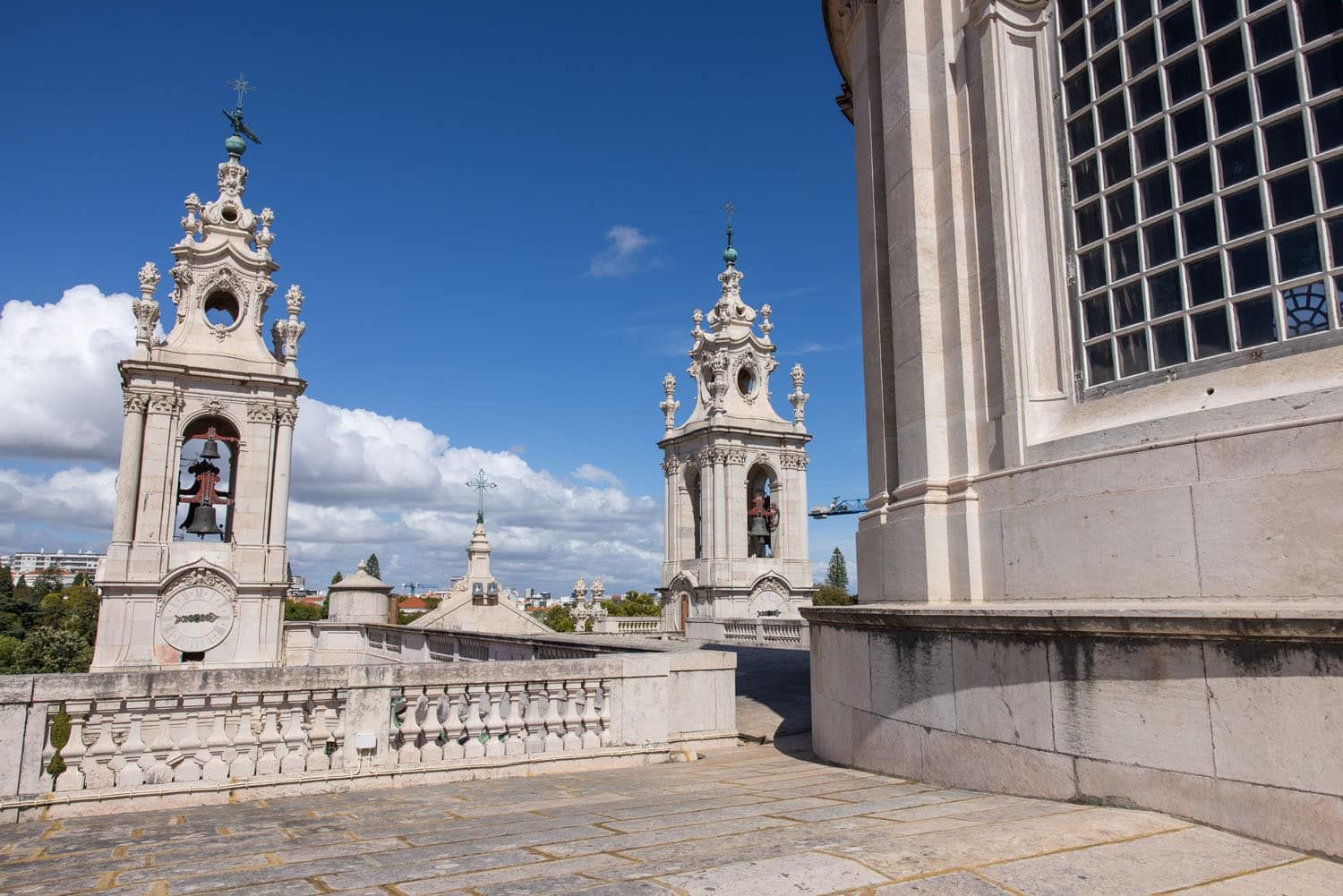
Note: The church closes for lunch but the rooftop has different hours. We were here during lunchtime but could still visit the rooftop.
38. Lisbon Winery
If you want to sample Portuguese wine and port in Lisbon, one of the best places to do so is at the Lisbon Winery.
During your tasting, you will try five Portuguese wines along with Portuguese artisanal cheeses and Iberian pork charcuterie, as well as Portuguese extra virgin olive oil. The wine selections are from smaller wine producers in Portugal and as your sommelier learns your taste, adjusts the wine selections to fit your palate.
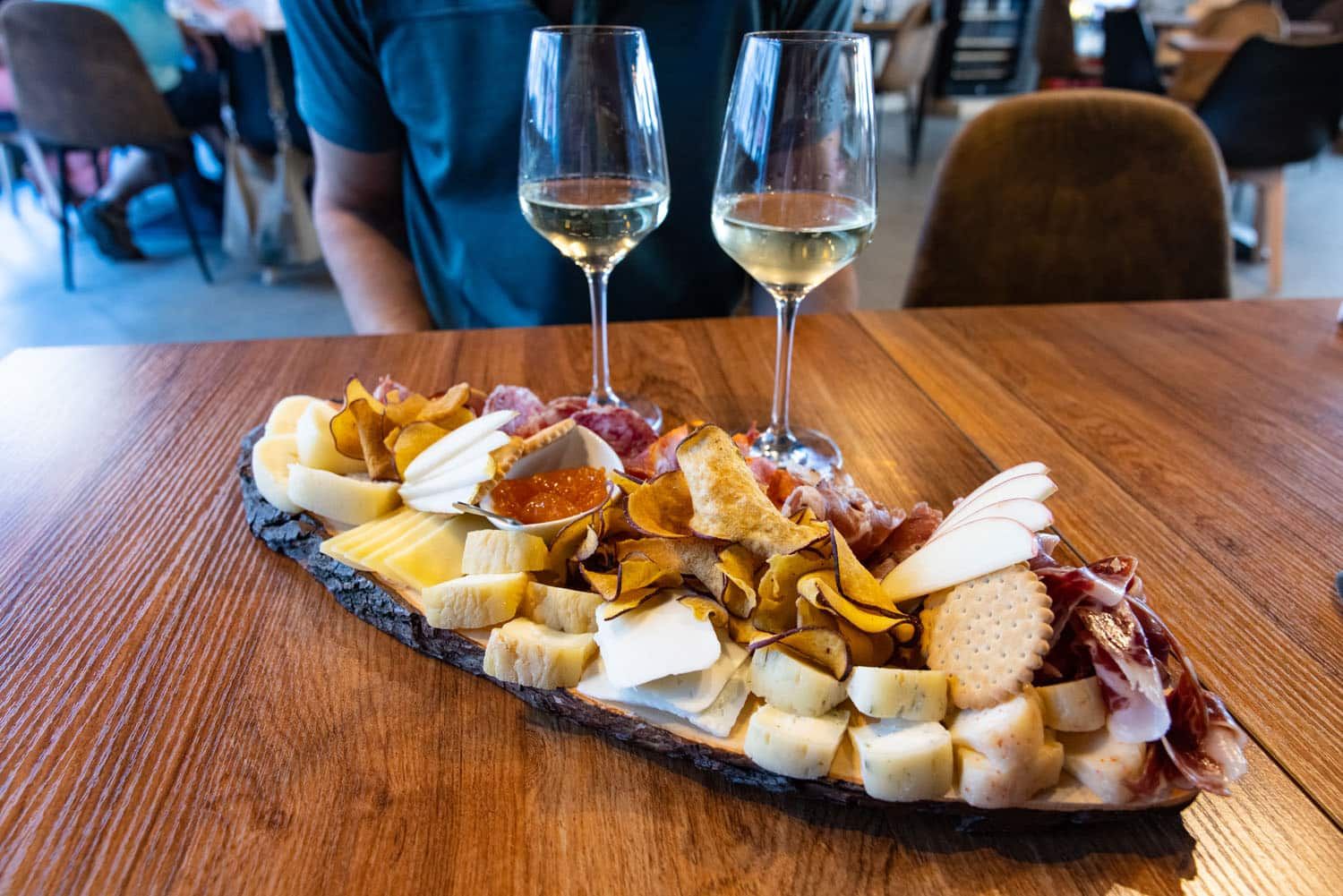
We loved this experience, especially talking with our sommelier, who taught us the basics about Portuguese wine and the various wine regions throughout the country.
This experience is growing in popularity. Make your reservation in advance on their website.
39. Ajuda National Palace
When the royal family’s residence on the waterfront was destroyed in the 1755 earthquake, they decided to relocate up into the hills of Lisbon. They had big plans to construct one of the largest palaces in Europe, but invasions and changing politics slowed construction. Only one fifth of the planned palace was built.
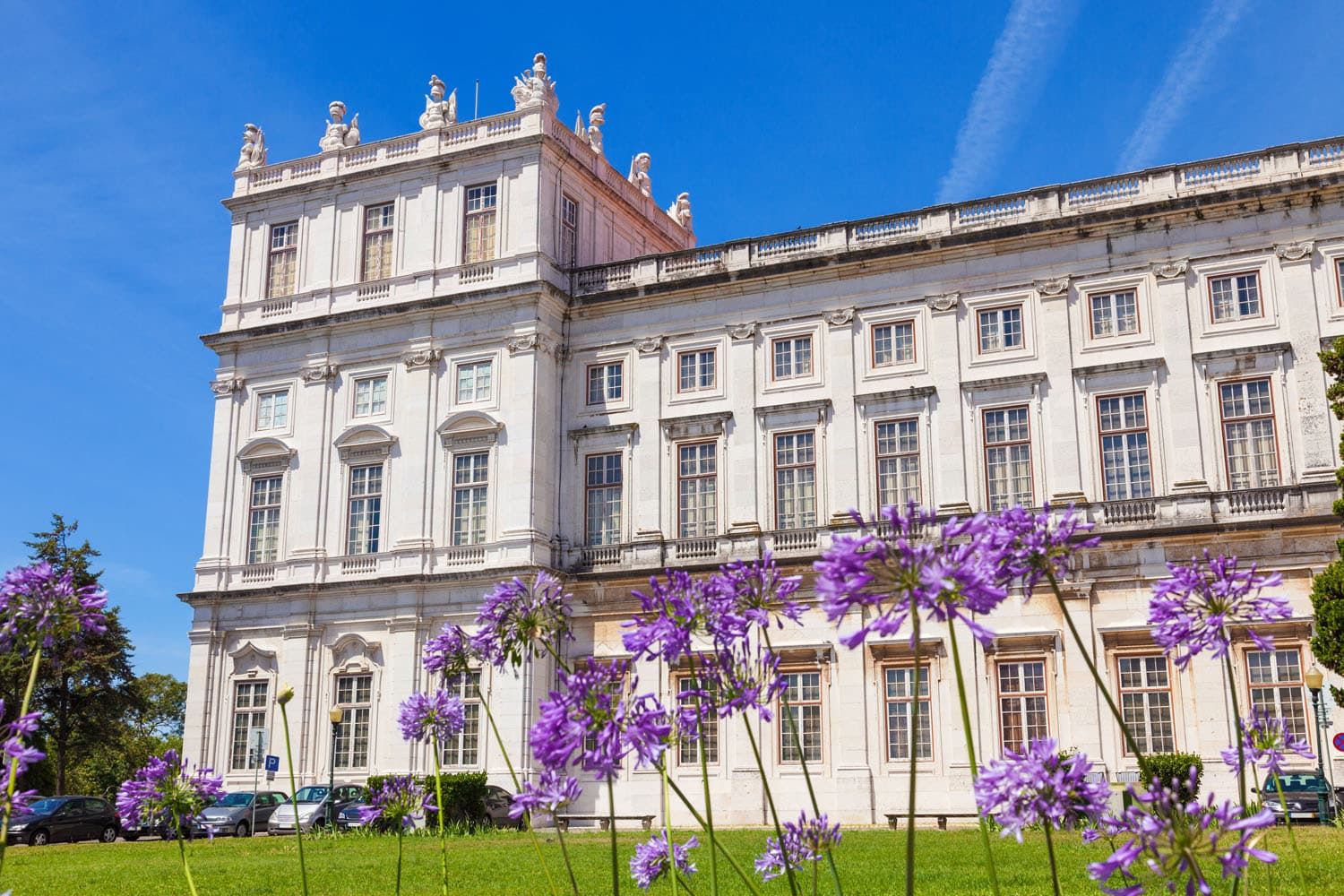
Ajuda National Palace | Ivan Soto Cobos/shutterstock.com
The palace was converted into a museum, which is filled with ornately decorated rooms, the Royal Treasure Museum, and numerous artworks.
The Ajuda National Palace sits outside of the city center of Lisbon. You can get here on Tram 18, bus 760 or 732, or by taxi, Uber, or another ride share app.
40. Take a Day Trip
One of the best things to do in Lisbon is to leave it for a day, day tripping to places like Sintra, Cascais, and the coast. In fact, we wrote a guide to the Best Day Trips from Lisbon ↓
14 Amazing Day Trips from Lisbon
Best day trips from Lisbon and exactly how to plan them.Sintra is the most popular day trip from Lisbon. This land of fairytale palaces and historic estates is where you will find Pena Palace, Quinta da Regaleira, and an ancient Moorish castle that is a joy to explore. Learn how to plan your day trip in our One Day in Sintra guide.
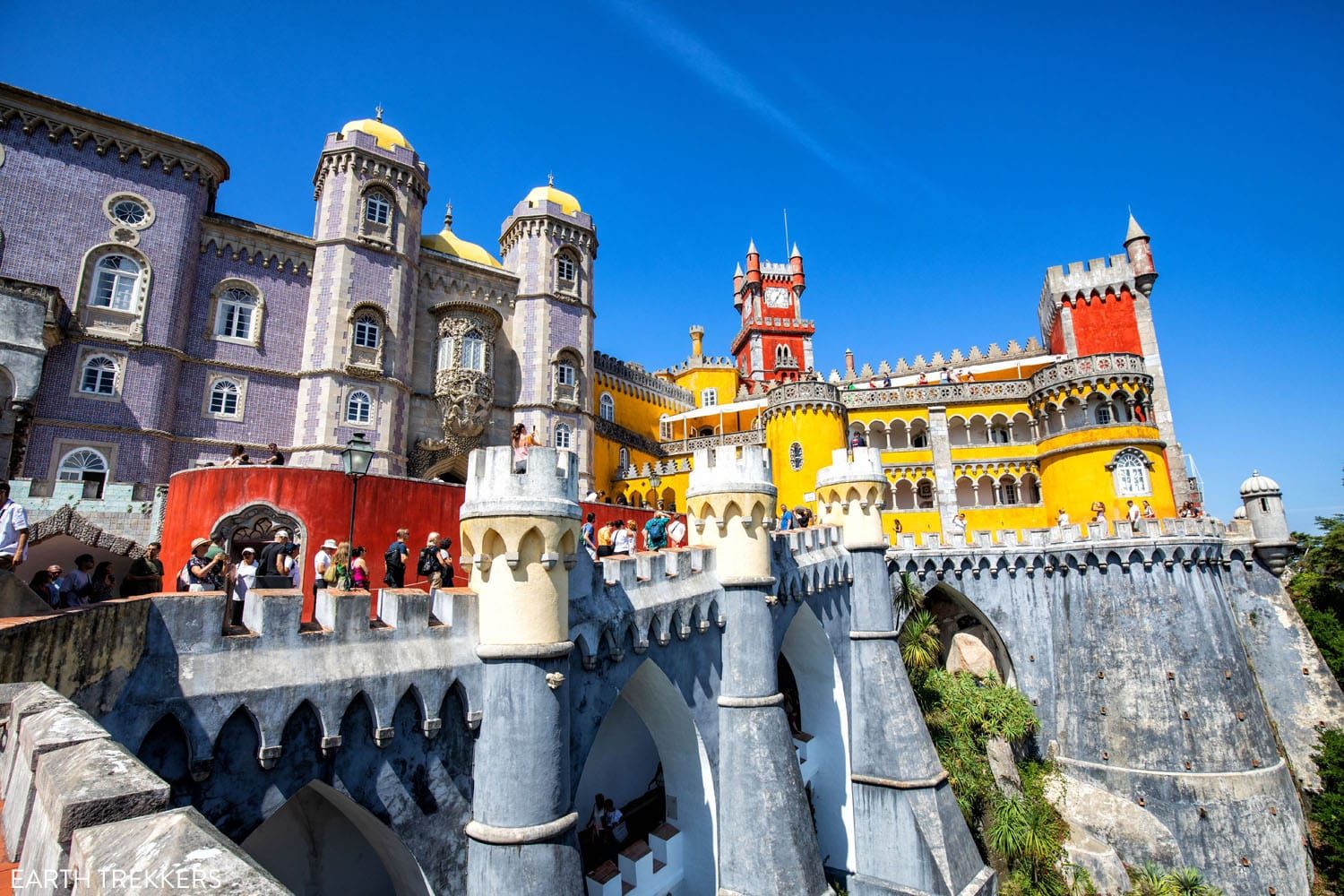
Pena Palace, Sintra
Cabo da Roca, the westernmost point of mainland Europe, is located near Sintra and also makes a great day trip from Lisbon.
Cascais, a small coastal town, also makes a popular day trip from Lisbon. Cascais is famous for its beaches, its historic city center, shopping, and restaurants.
You can also journey farther from Lisbon, visiting Óbidos (a small walled medieval town that is super fun to explore), the National Palace of Mafra, and Alcobaça Monastery.
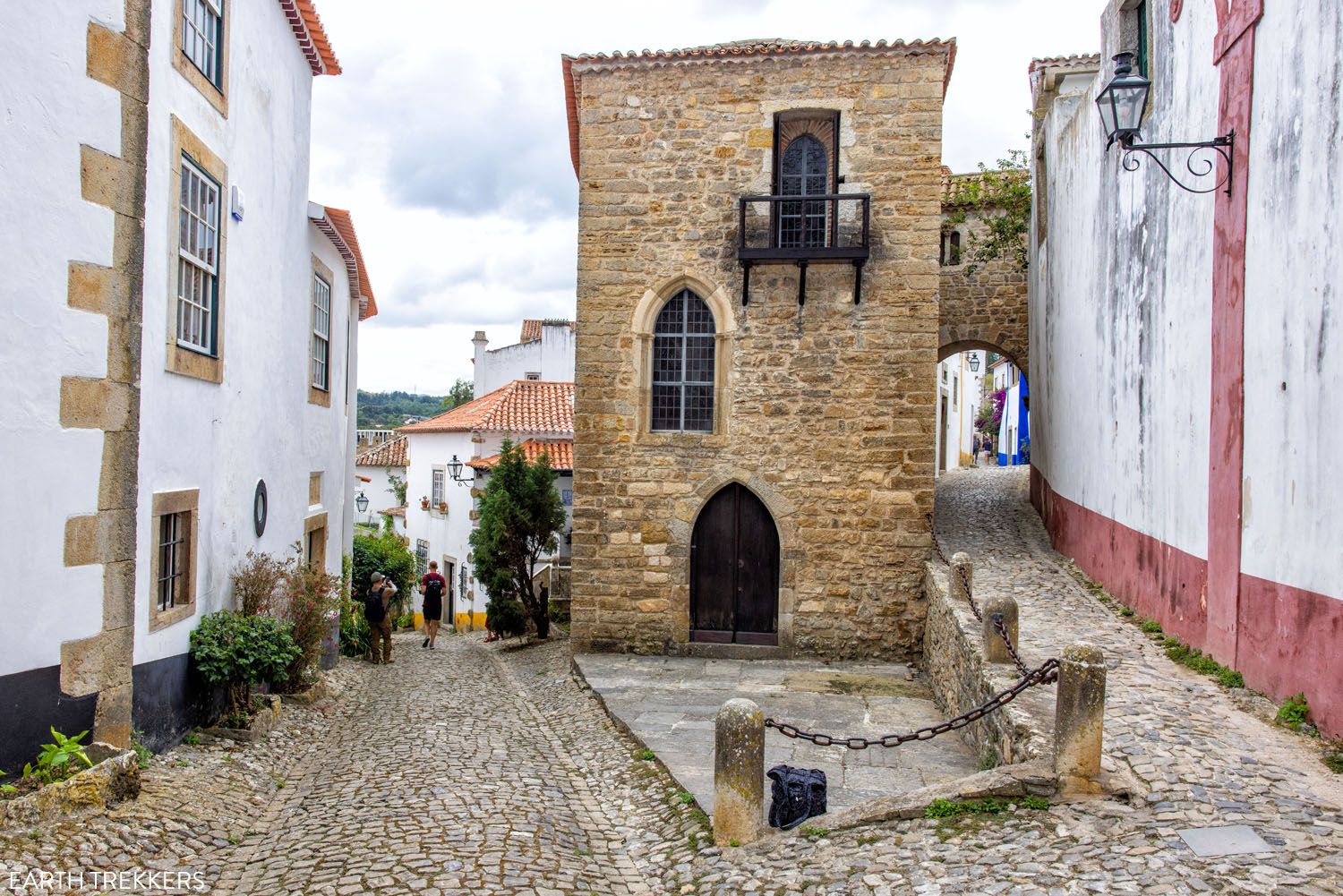
Óbidos
Best Things to Do in Lisbon: On a Map
How to Use This Map: Click the icons on the map to get more information about each point of interest. To take this map with you, click the star next to the title of the map which adds it to your Google account. Next, within your Google Maps app, select ‘Saved’ and then select ‘Maps’. This map title will now appear in your list.
Interesting Facts about Lisbon
Lisbon is the capital and the largest city of Portugal. It is the second-oldest European capital city, with Athens taking the #1 spot.
Lisbon was first established by pre-Celtic tribes, then came under the rule of the Phoenicians and the Romans, and then passed between Germanic tribes and the Moors. In 1147, Afonso Henriques conquered the city and in 1255 it became Portugal’s capital.
On November 1, 1755, a massive earthquake struck Portugal, destroying 85% of the city’s buildings. As you tour the historic buildings in Lisbon (and other towns in Portugal), you will hear about this earthquake quite a bit. Following the earthquake, most of the medieval buildings were razed and, in their place, the large squares (Praça do Rossio and Praça do Comércio) were constructed, as were many of the buildings we still see today.
Lisbon is made up of several neighborhoods: Alfama, Mouraria, Bairro Alto, Alcântara, Baixa, Belém, Chiado, Estrela, and Beato.
Like Rome, Lisbon is built on seven hills. To get to the hilltops, which is well worth it for the views they offer, you can ride the handy network of funiculars and trams or take an electric tuk-tuk to get from place to place. Tram 28 and the Santa Justa Elevator make this list.
Our Recommendations
Top 10 Experiences in Lisbon
Here are the top 10 things to do in Lisbon if it is your first time in the city:
- Praça do Comércio
- São Jorge Castelo
- Jerónimos Monastery
- Belém Tower
- Time Out Market
- Ride or photograph Tram 28 & the Bica funicular
- Stroll through Alfama and Bairro Alto
- Take a day trip to Sintra
- Enjoy the view from the Church of Our Lady of Grace Bell tower
- Santa Justa Lift
- See blue and white tiles (azulejos): National Tile Museum or the Monastery of São Vicente de Fora
Best Free Things to Do in Lisbon
- Visit Praça do Comércio
- See Belém Tower
- Photograph Tram 28
- Stroll through Alfama and Bairro Alto
- Visit the Church of Santa Maria de Belém
- Enjoy the view from the top of Santa Justa Lift
- Pink Street
- Miradouro de Santa Luzia
- Miradouro da Senhora do Monte
- Visit São Pedro de Alcântara Miradouro
- Photograph the Bica funicular
10 Things to Do in Lisbon with Kids
- Lisbon Oceanarium
- Telecabine Lisbon
- São Jorge Castle
- Try a Pasteis de Belém
- Carmo Convent
- Maritime Museum
- Day trip to Sintra
- Ride the Bica funicular
- Visit Belém Tower
- See a fado show
LISBON DAY TRIPS: Lisbon is a great city to make your home base, to explore nearby locations such as Sintra, Cascais, and Obidos. Get the full list and lots of practical information in our article Best Day Trips from Lisbon.
Frequently Asked Questions
The Lisbon Card: Is It Worth It?
We purchased the Lisbon Card and don’t think we saved any money, which is amazing considering how many places we visited in Lisbon. The most value we got out of the Lisbon Card was getting into Jerónimos Monastery without having to purchase a ticket in advance. The card can be purchased at the Ask Me Lisboa – Praça do Comércio location (lines can be long) or any site that accepts the Lisbon Card (we purchased ours at Arco da Rua Augusta and there was no line).
If you are considering getting the Lisbon Card, add up the prices of the attractions you plan to visit and compare that to the benefits of the Lisbon Card.
How much time do you need in Lisbon?
At a minimum, plan on spending at least three days in Lisbon. This gives you enough time to visit the sites on our top 10 list plus take a day trip, if you are interested in visiting Sintra, Cascais, or the nearby coast.
What are the best day trips from Lisbon?
The best day trips from Lisbon include Sintra, Cabo da Roca, Cascais, Óbidos, and Marfa National Palace. Farther away are Alcobaça Monastery, Ericeira, Batalha Monastery, Nazaré, Fátima, Tomar, and Evora.
If you have any questions about the best things to do in Lisbon, let us know in the comment section below.
More Lisbon & Portugal Travel Guides
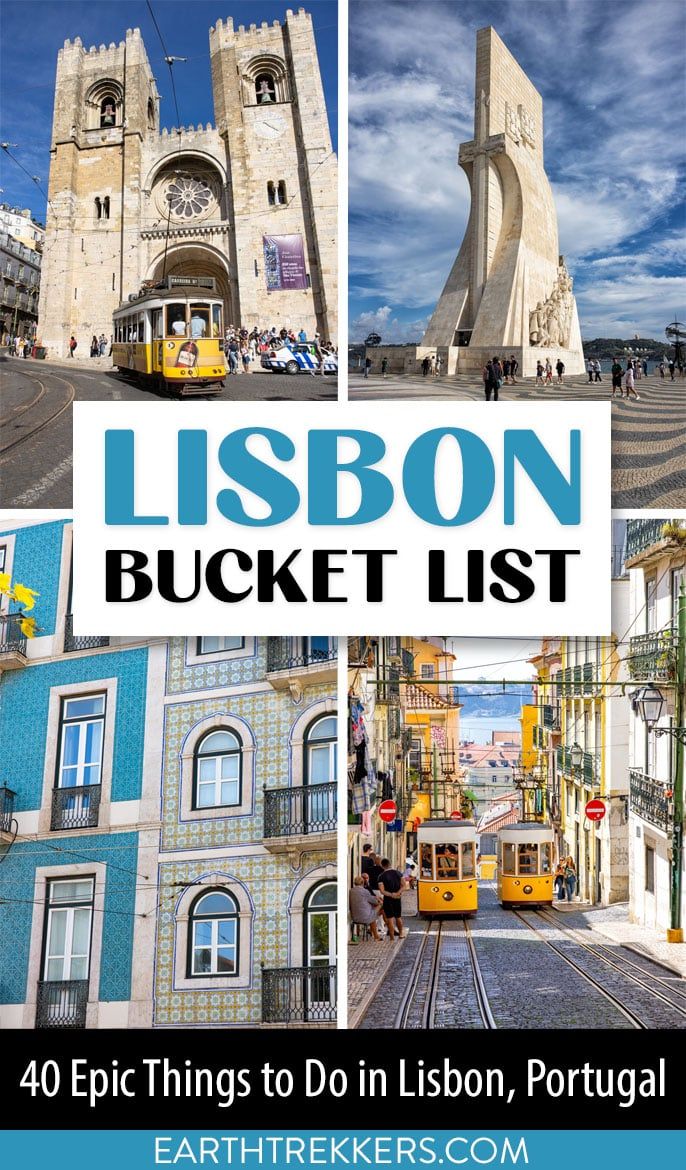
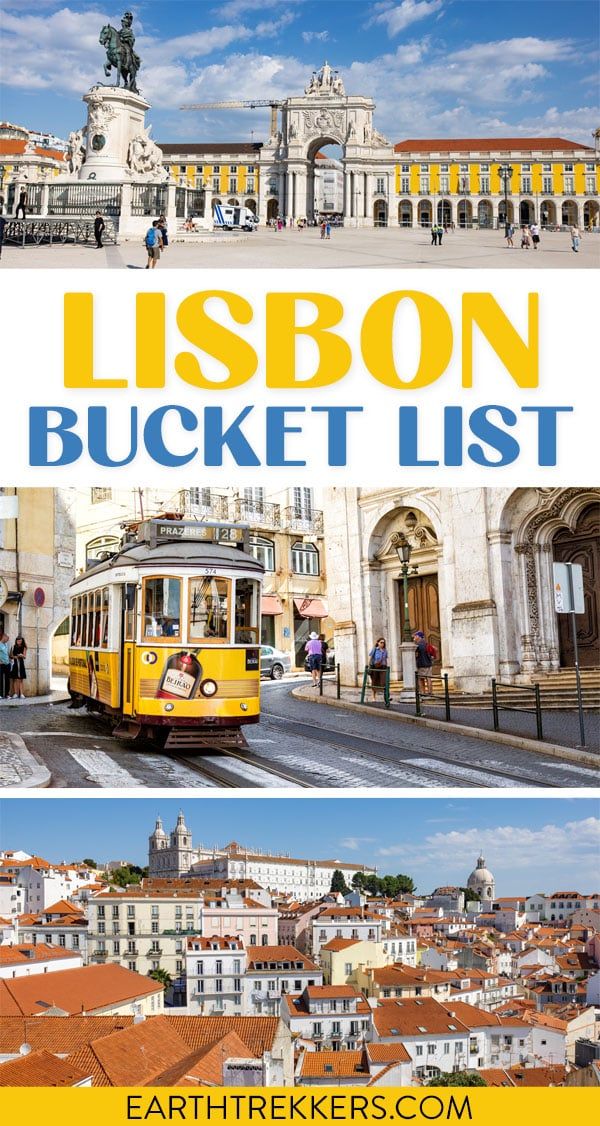
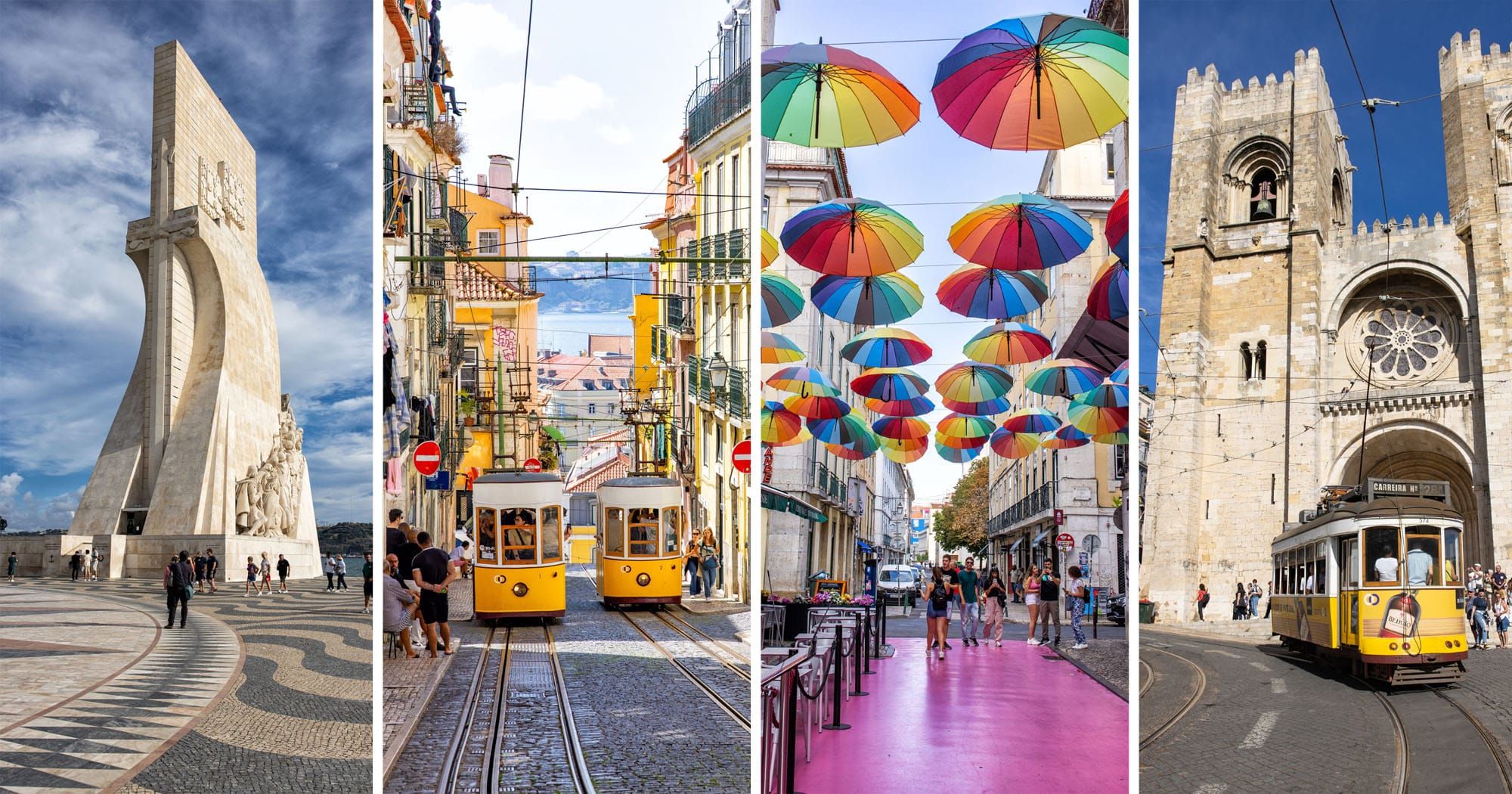

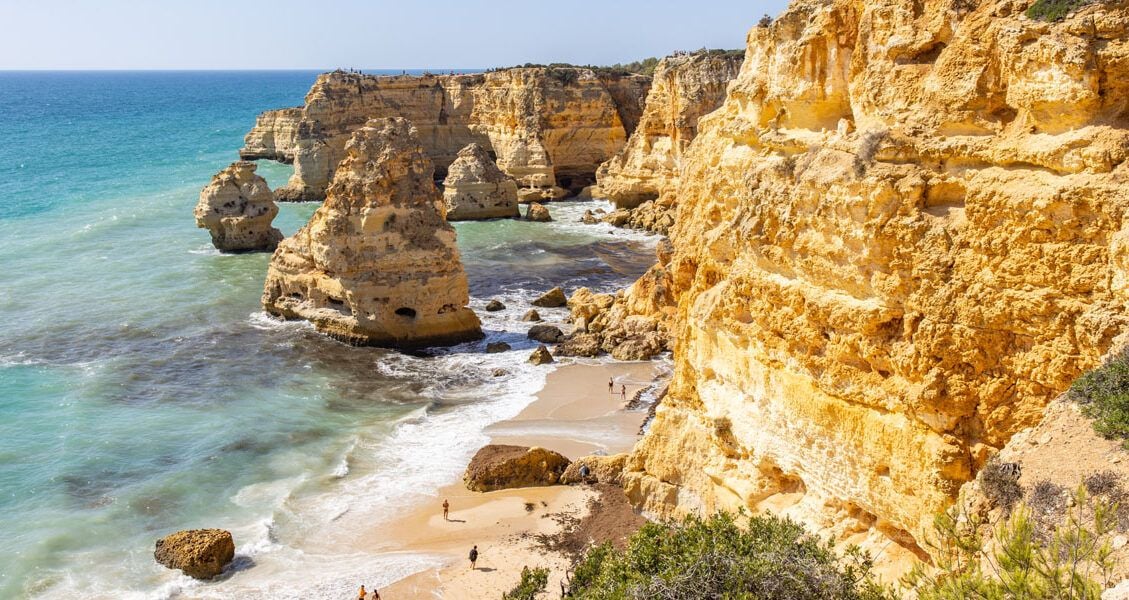
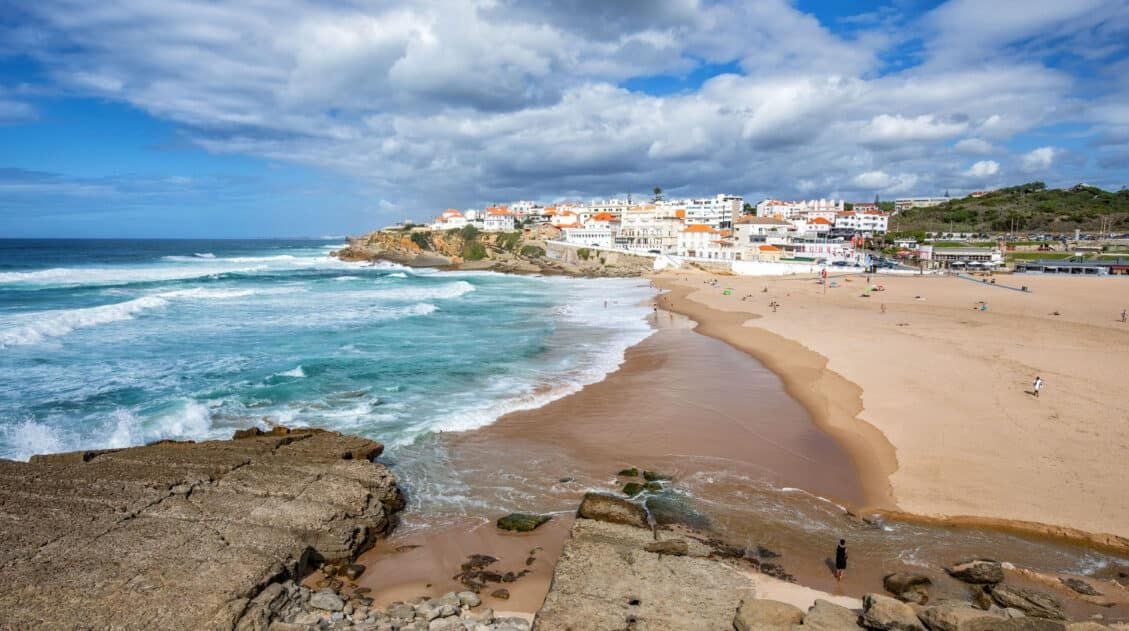
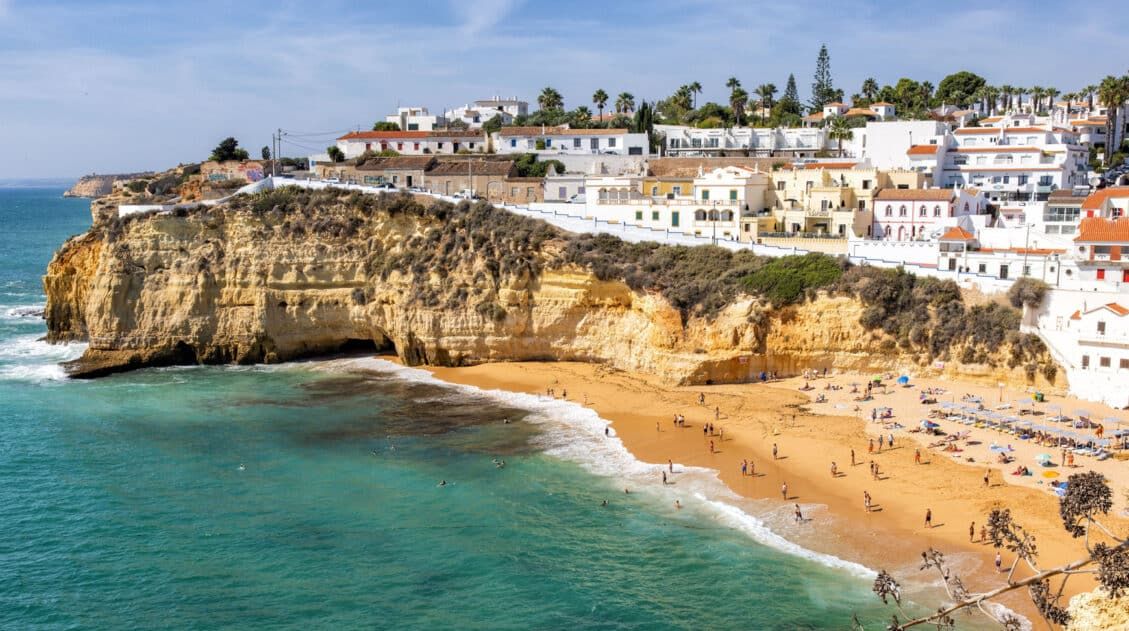
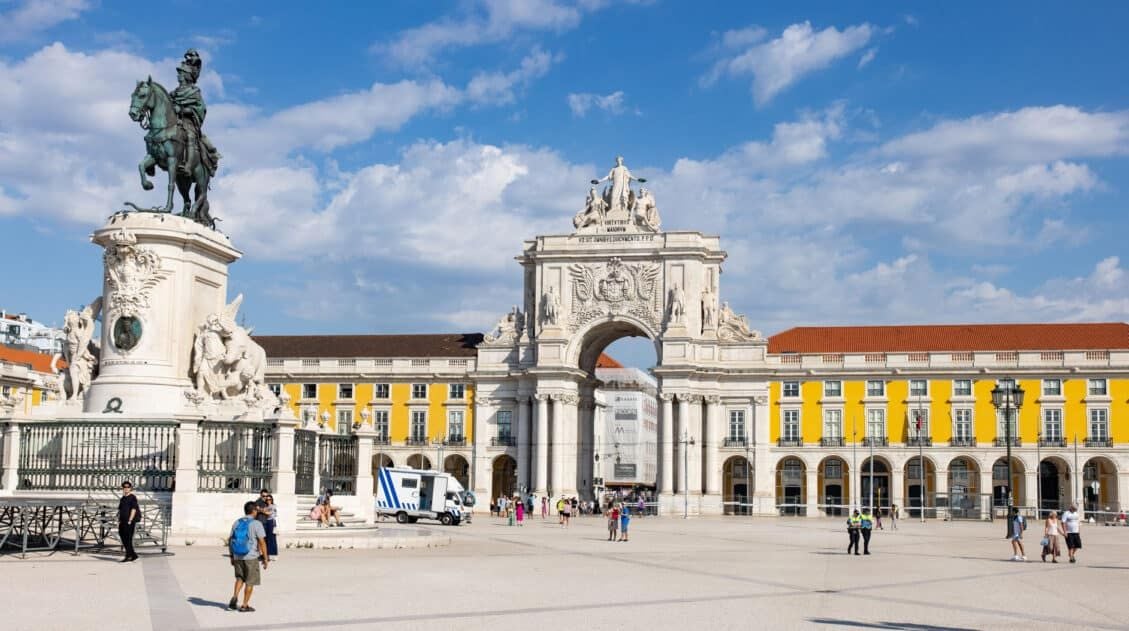
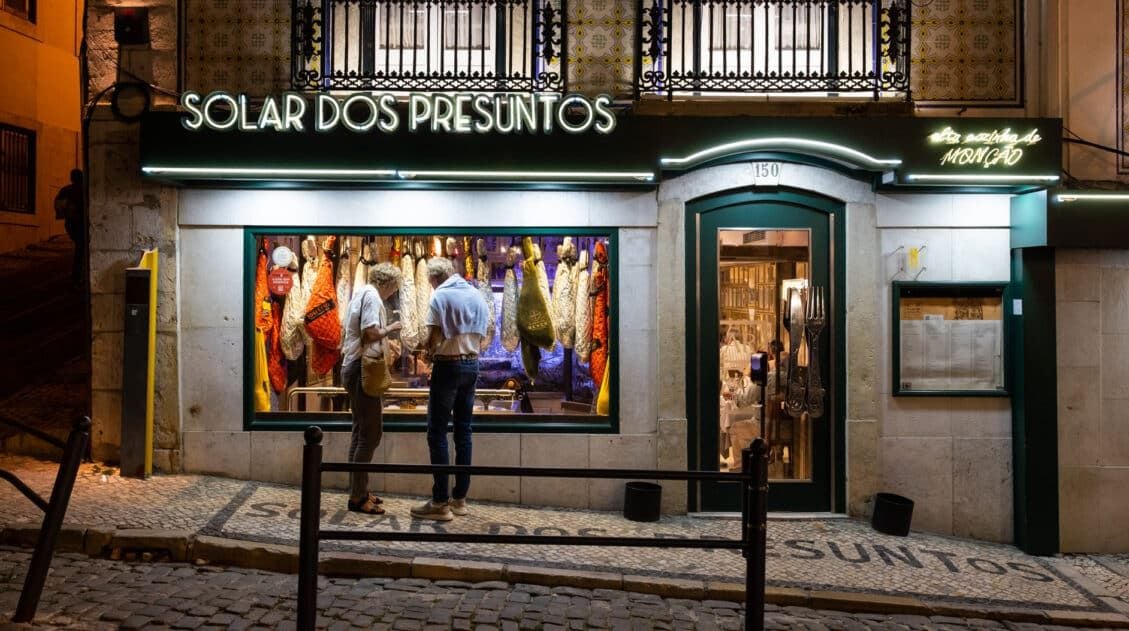
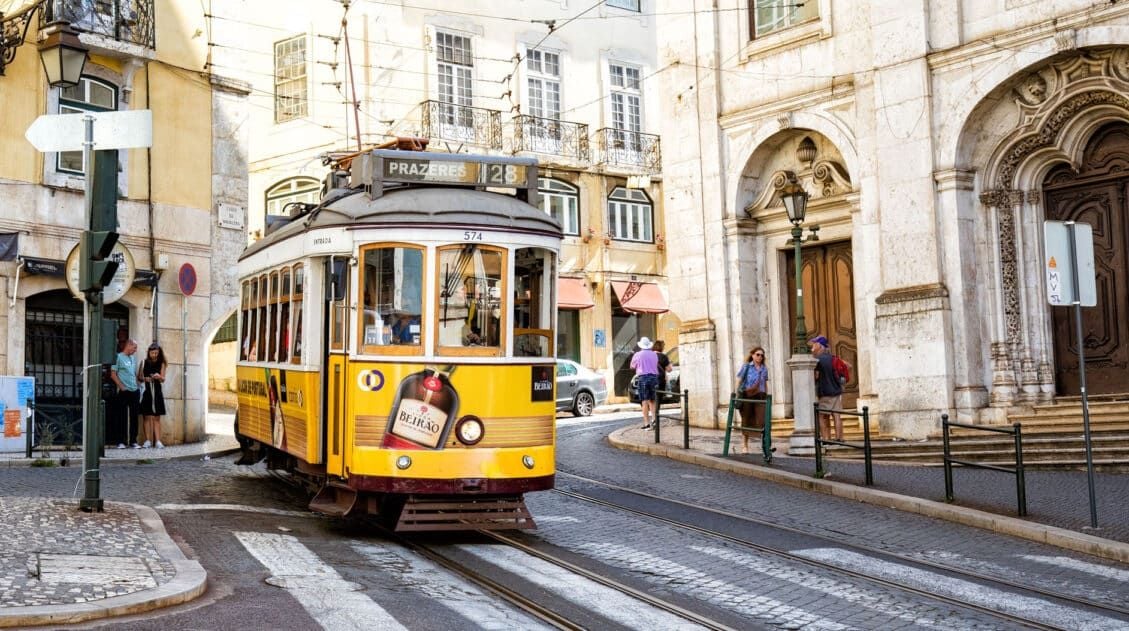
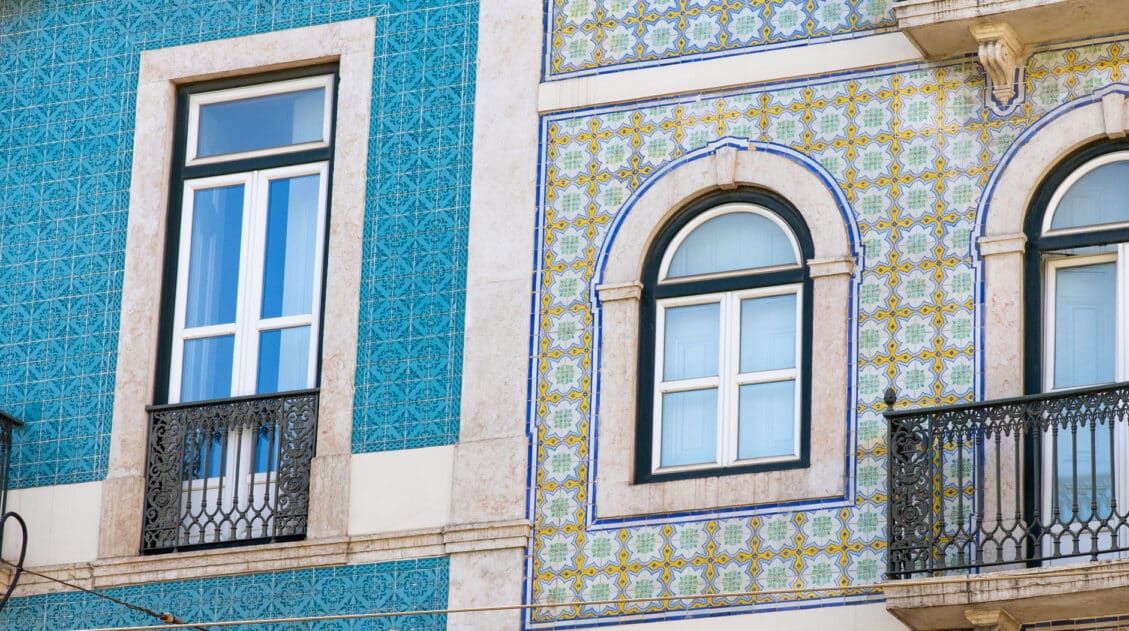
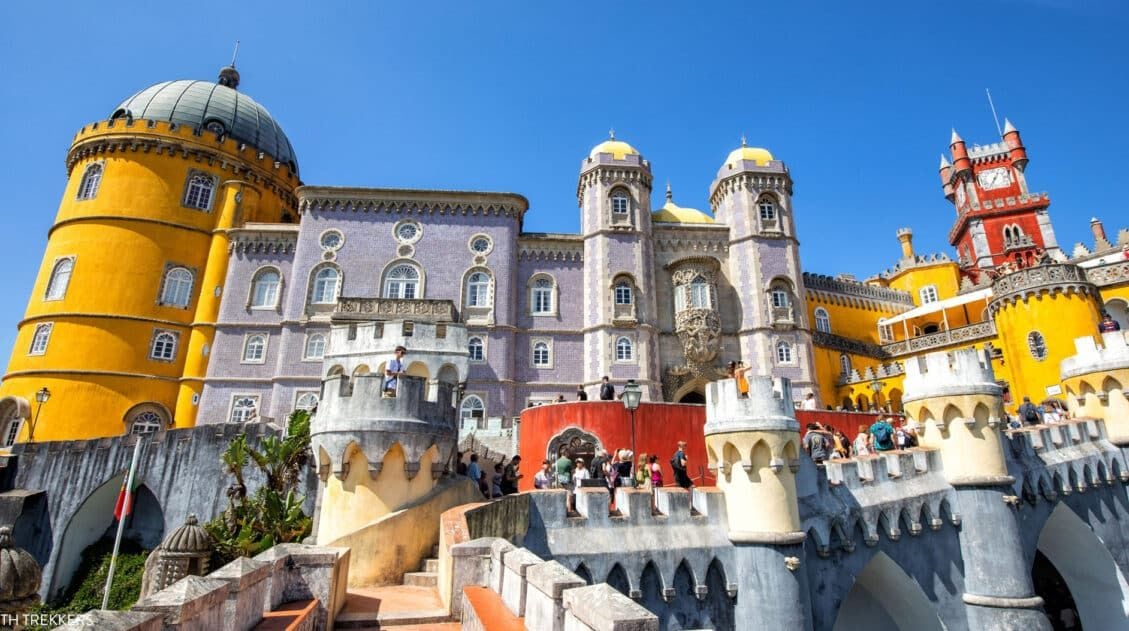
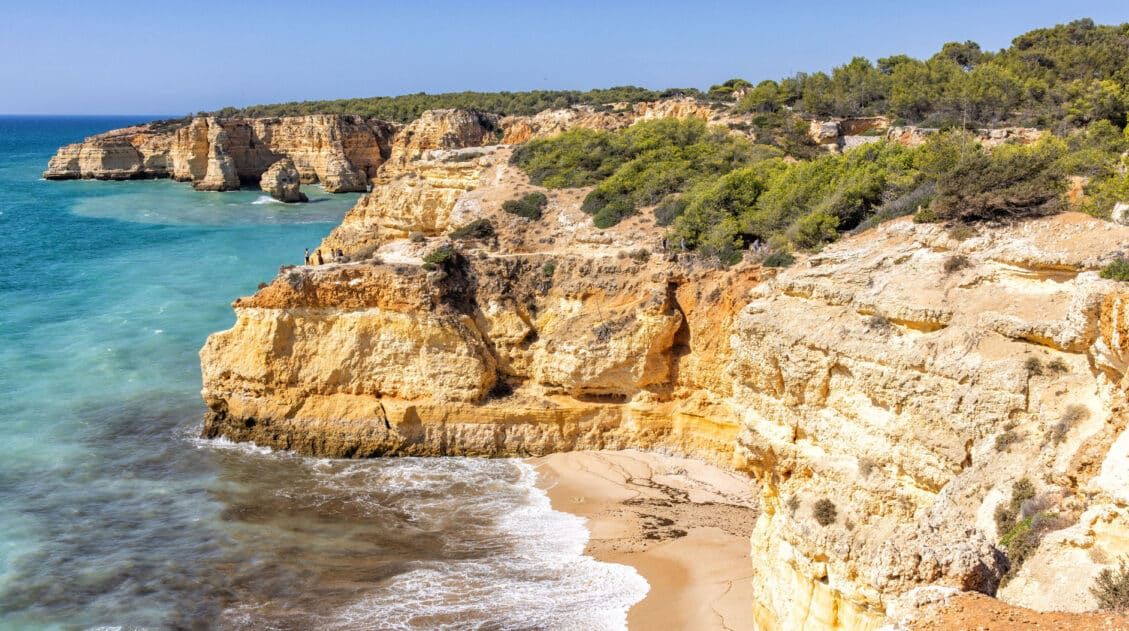
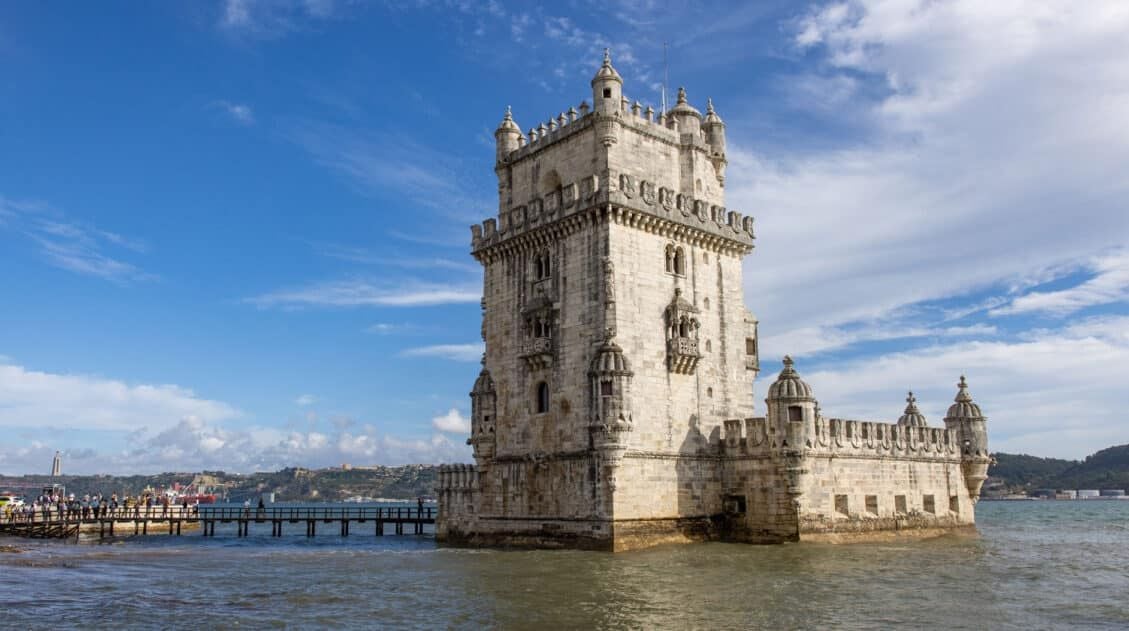
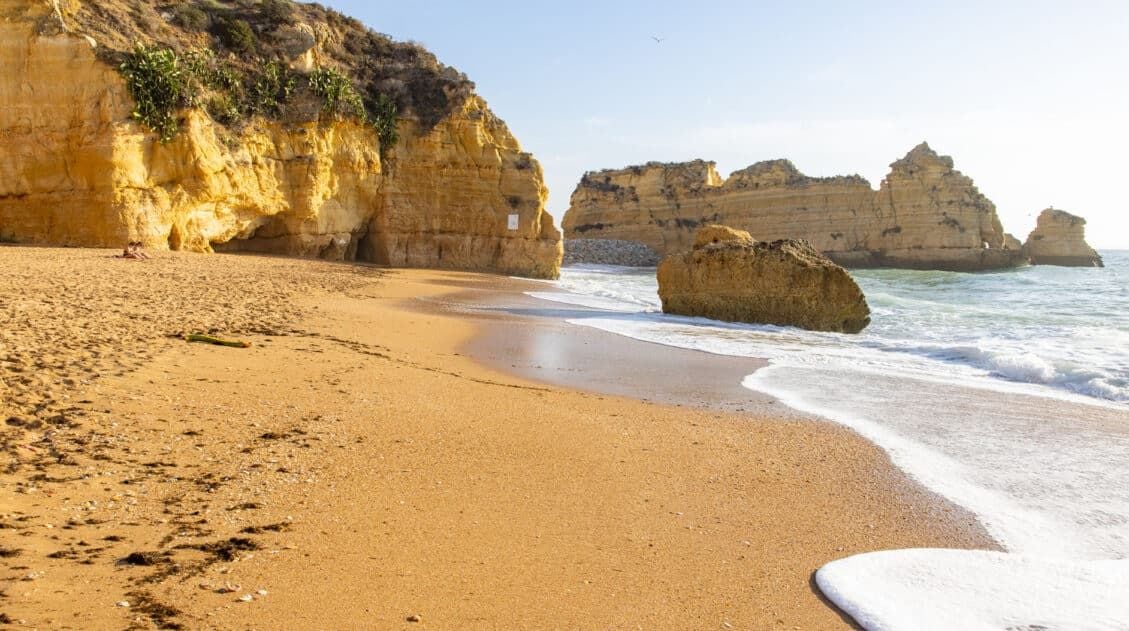
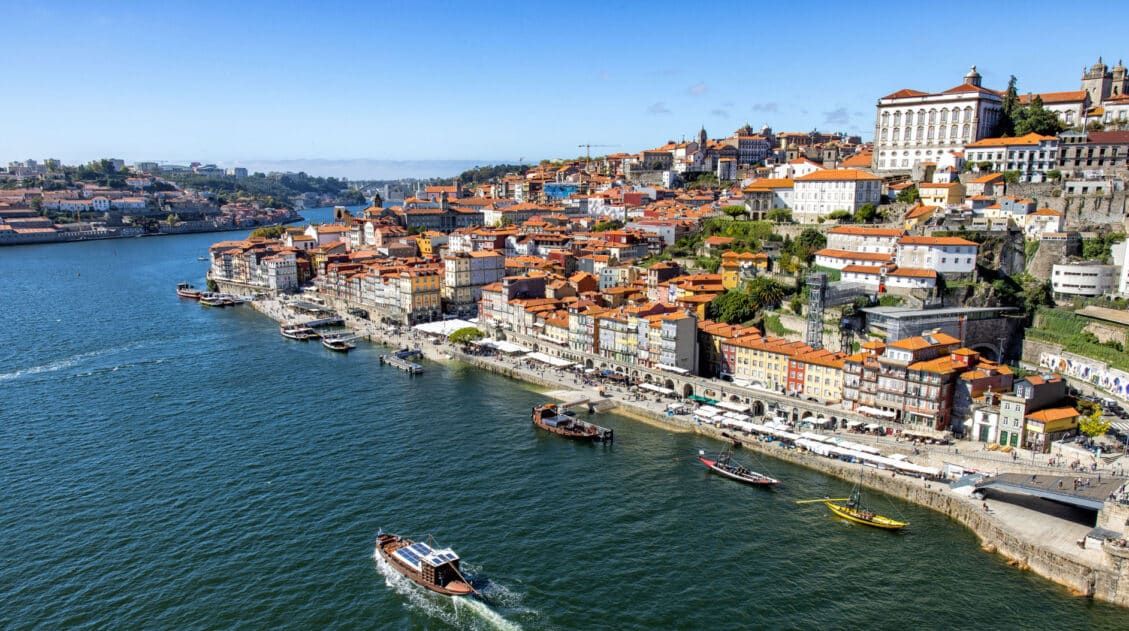
Comments 18